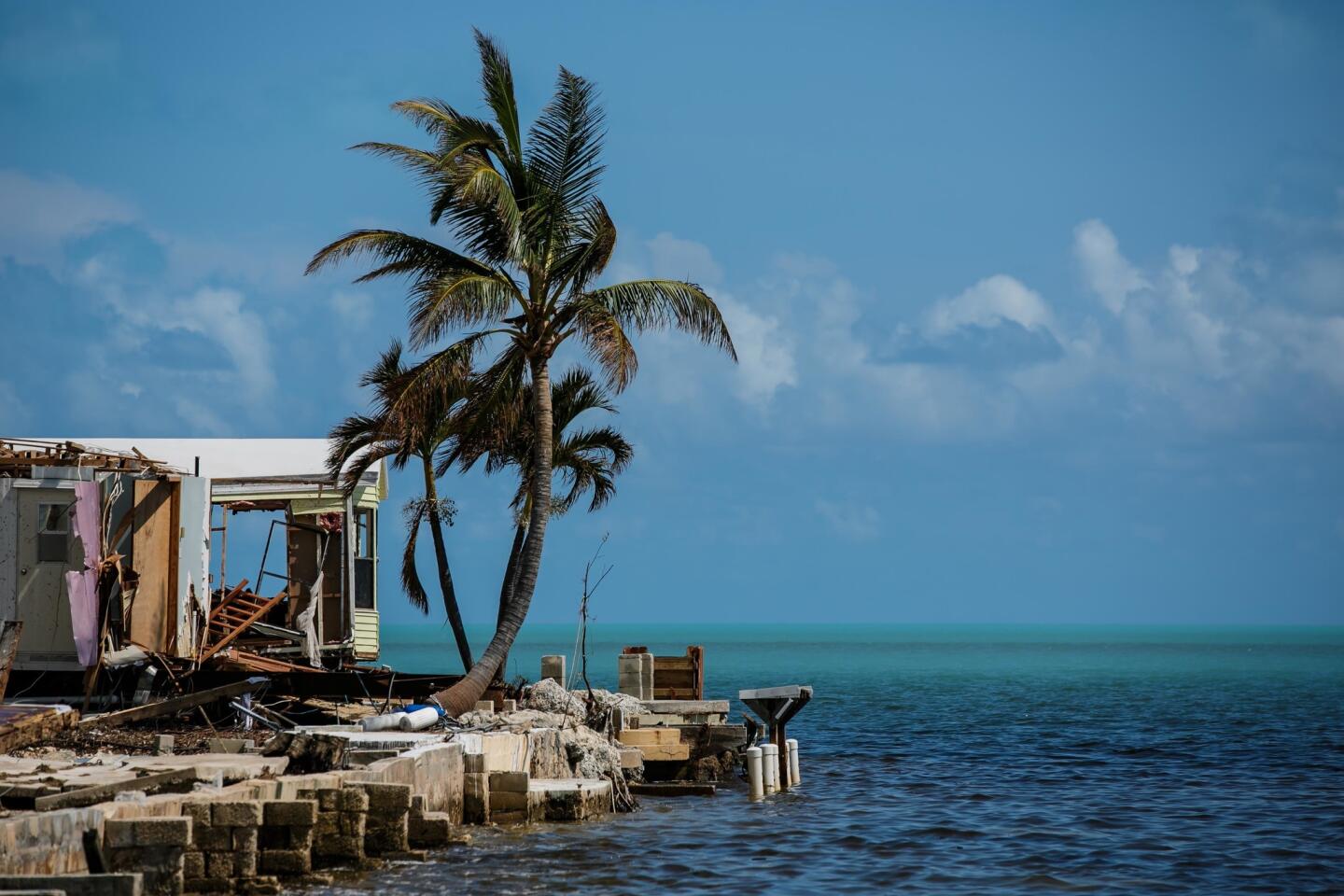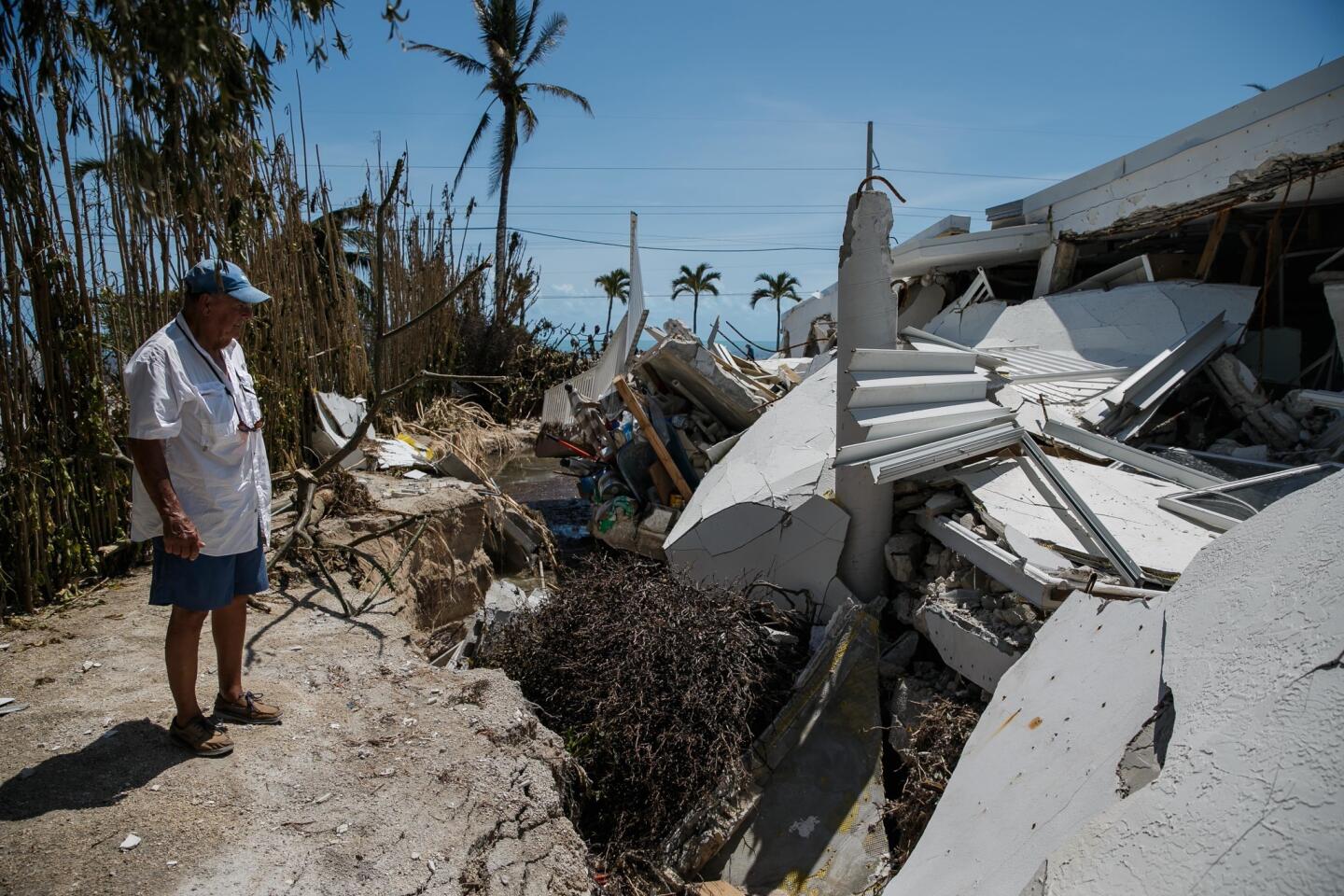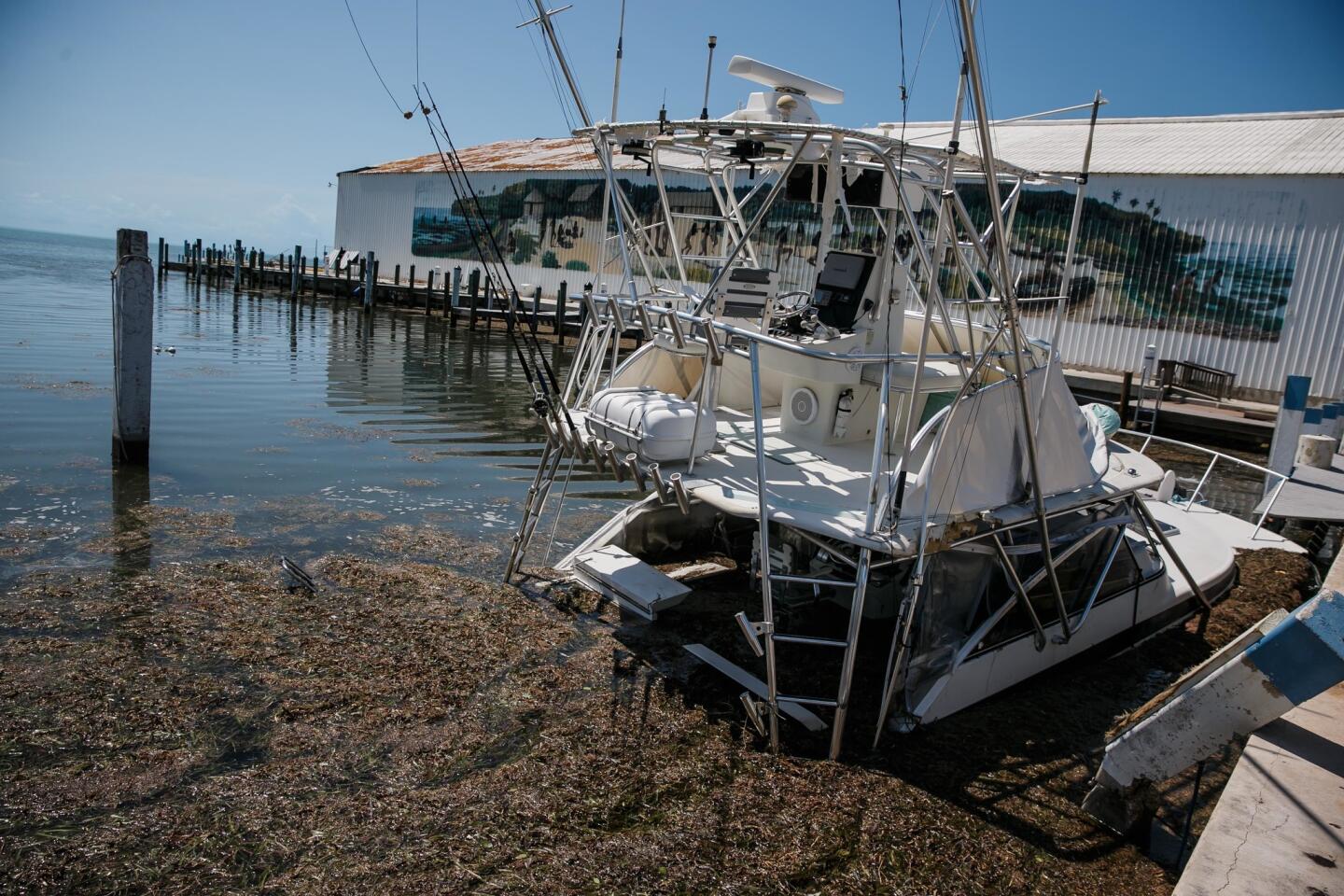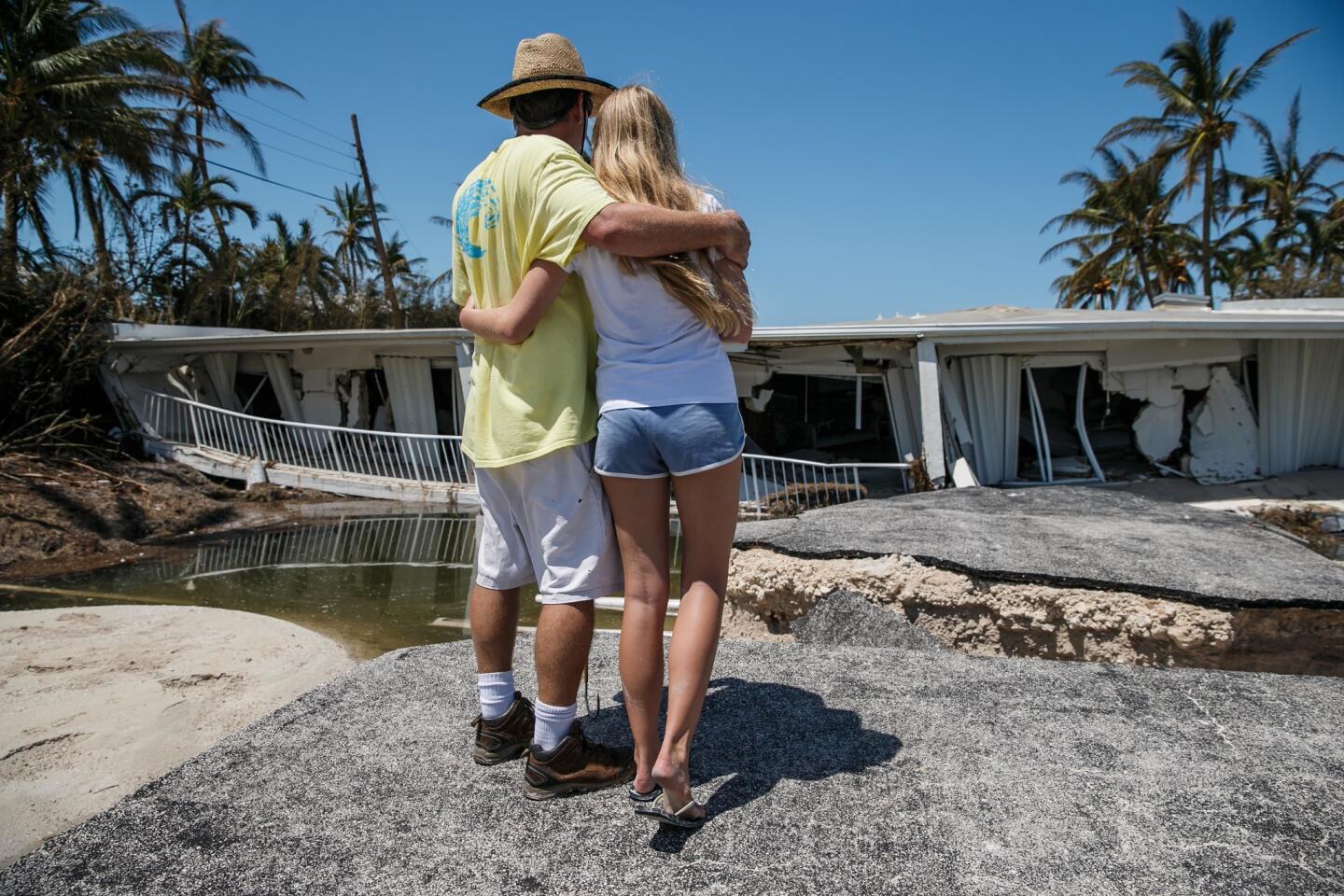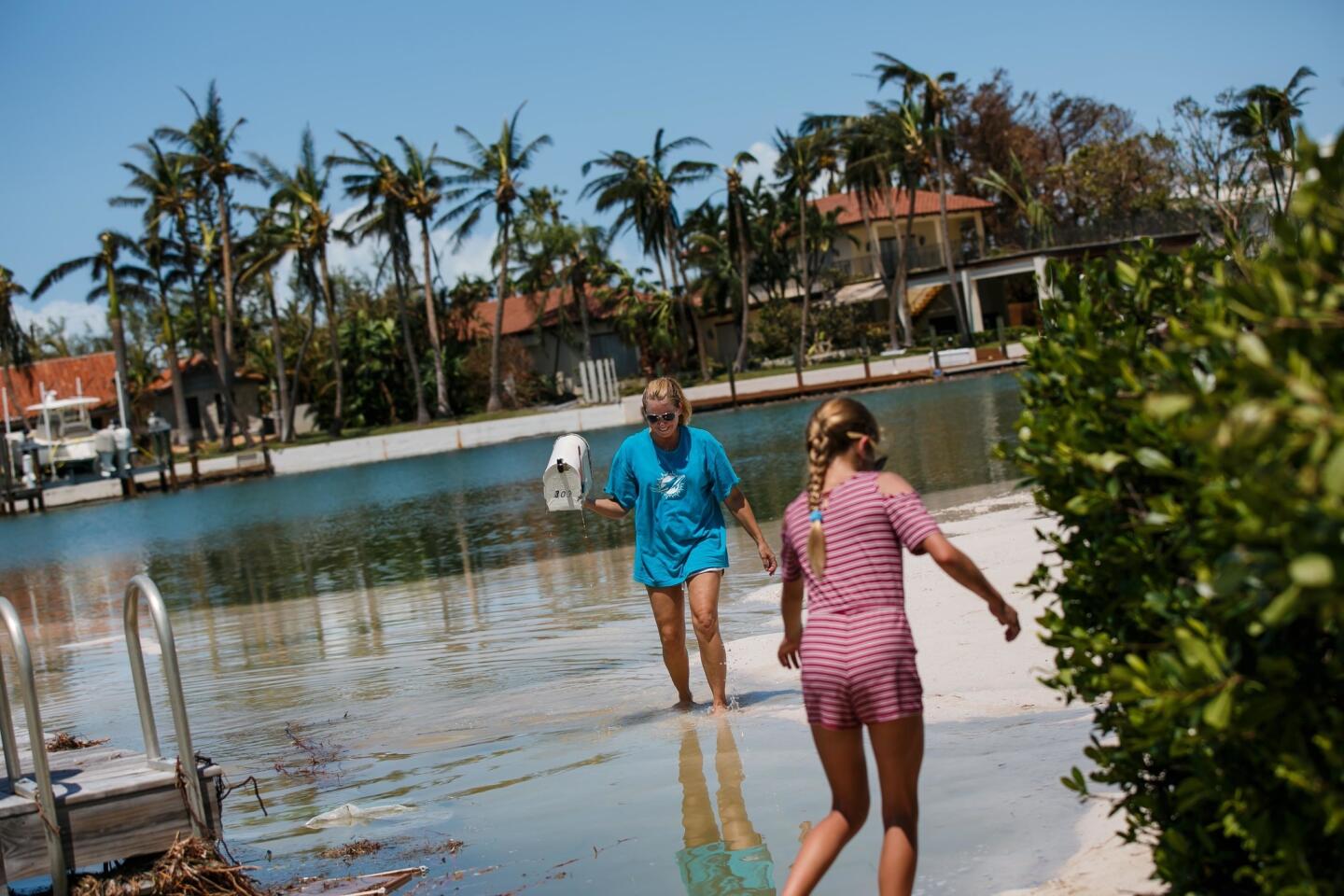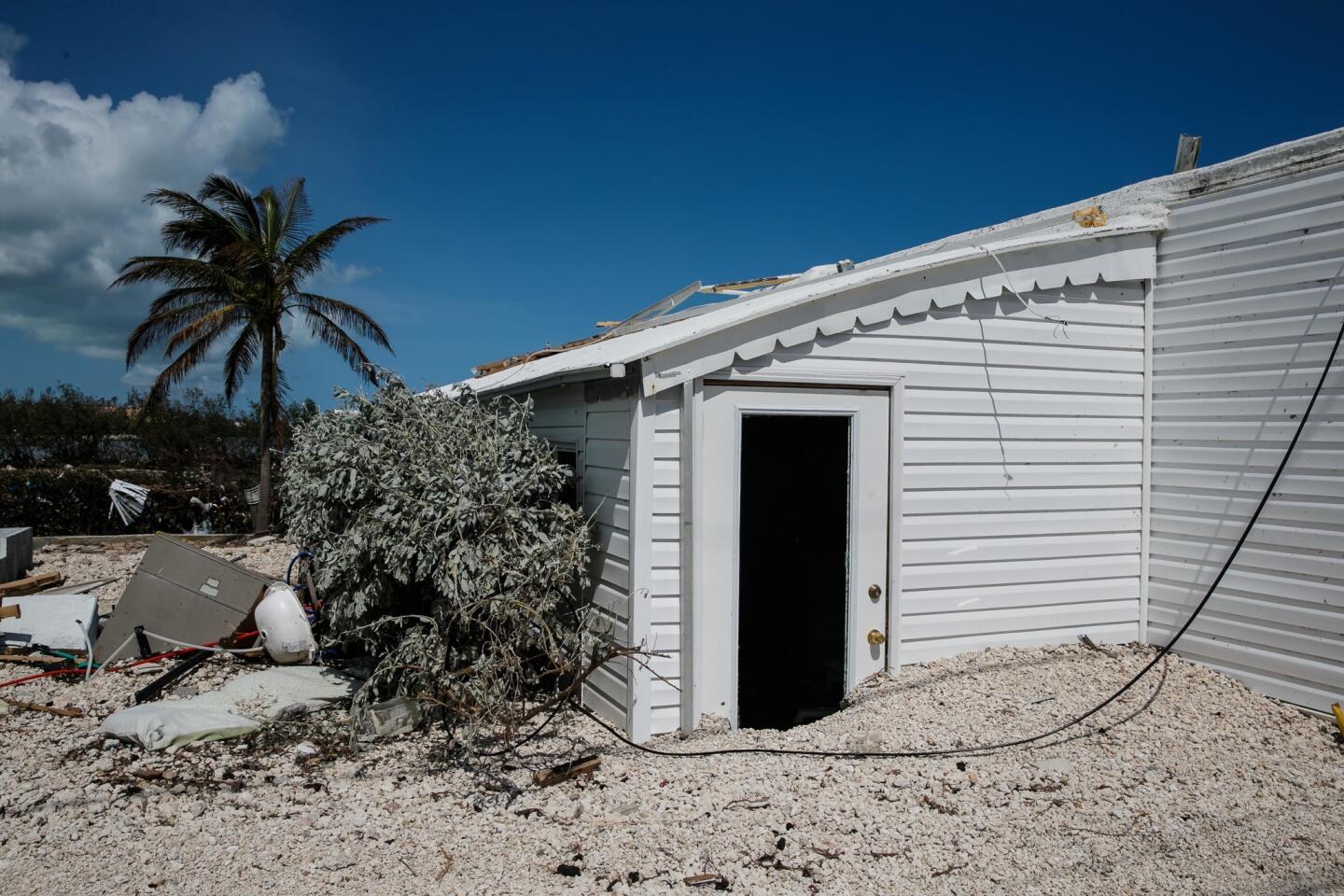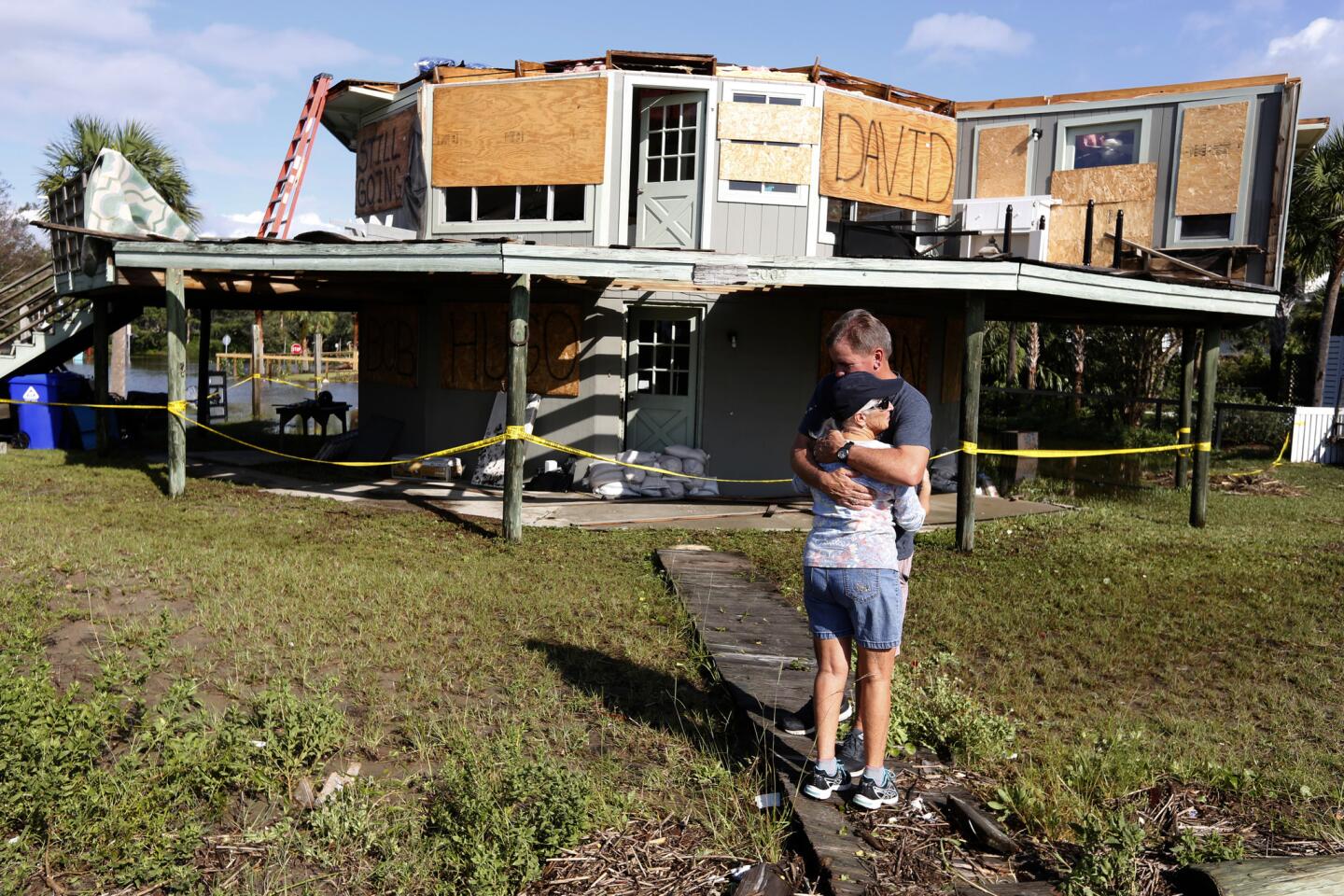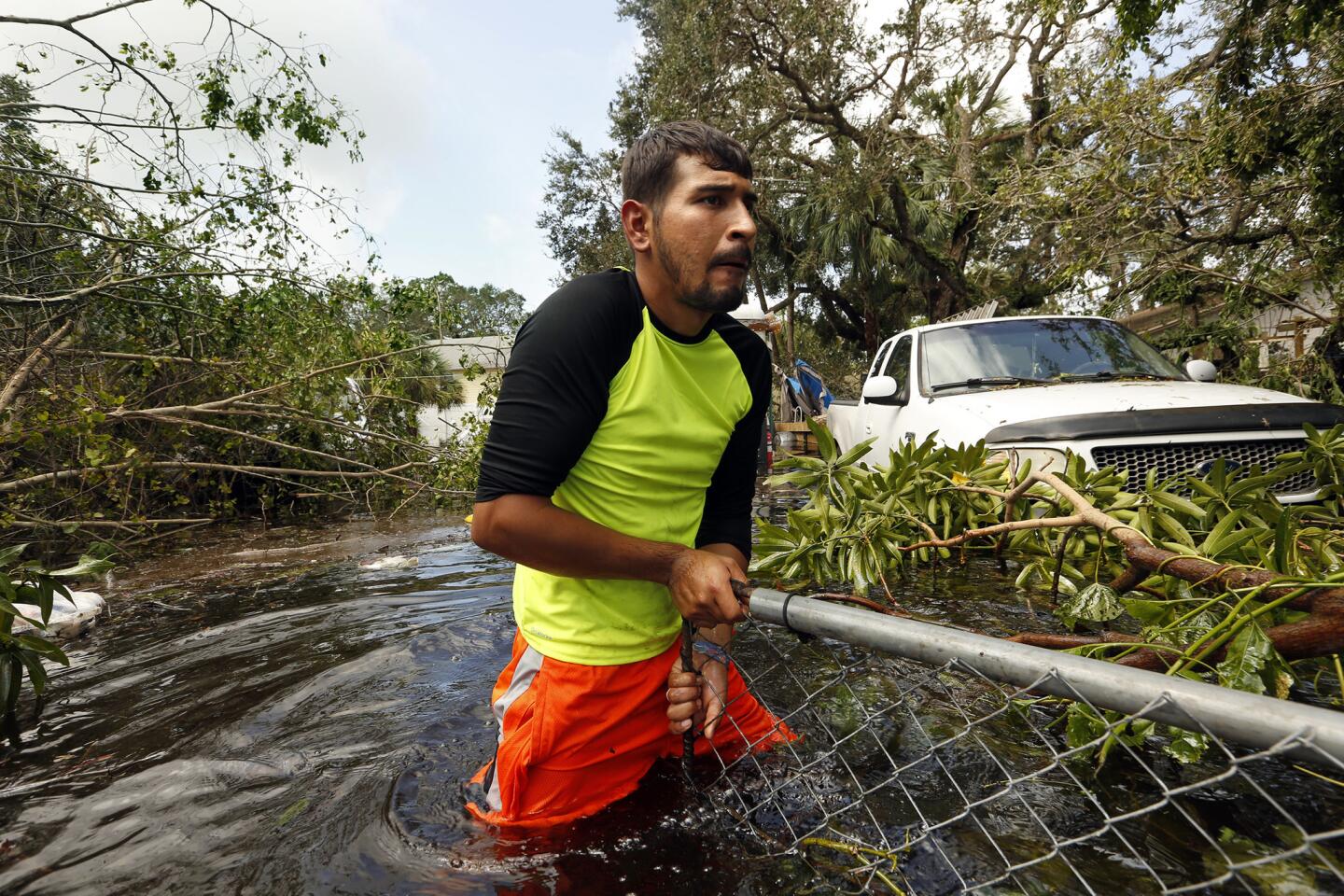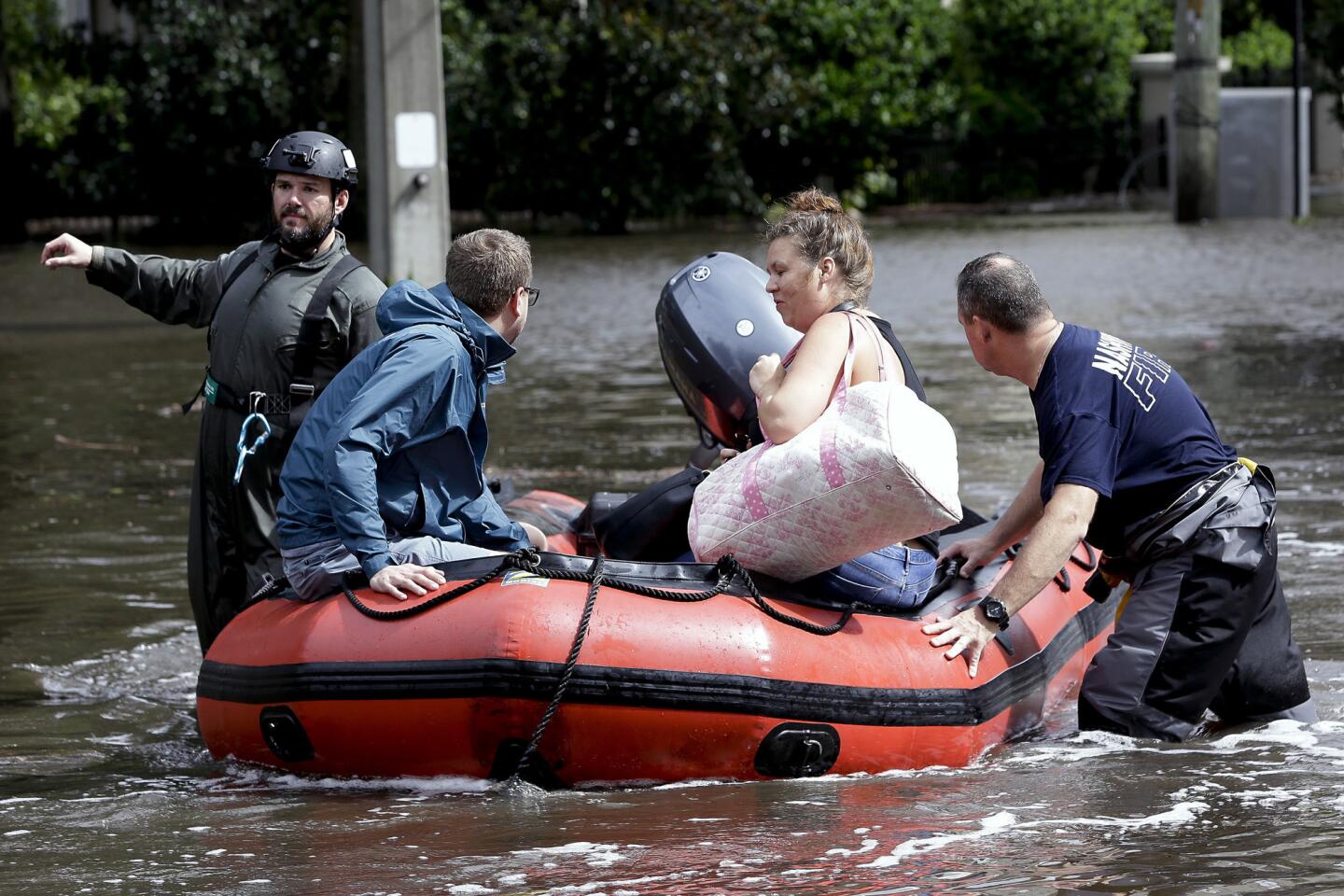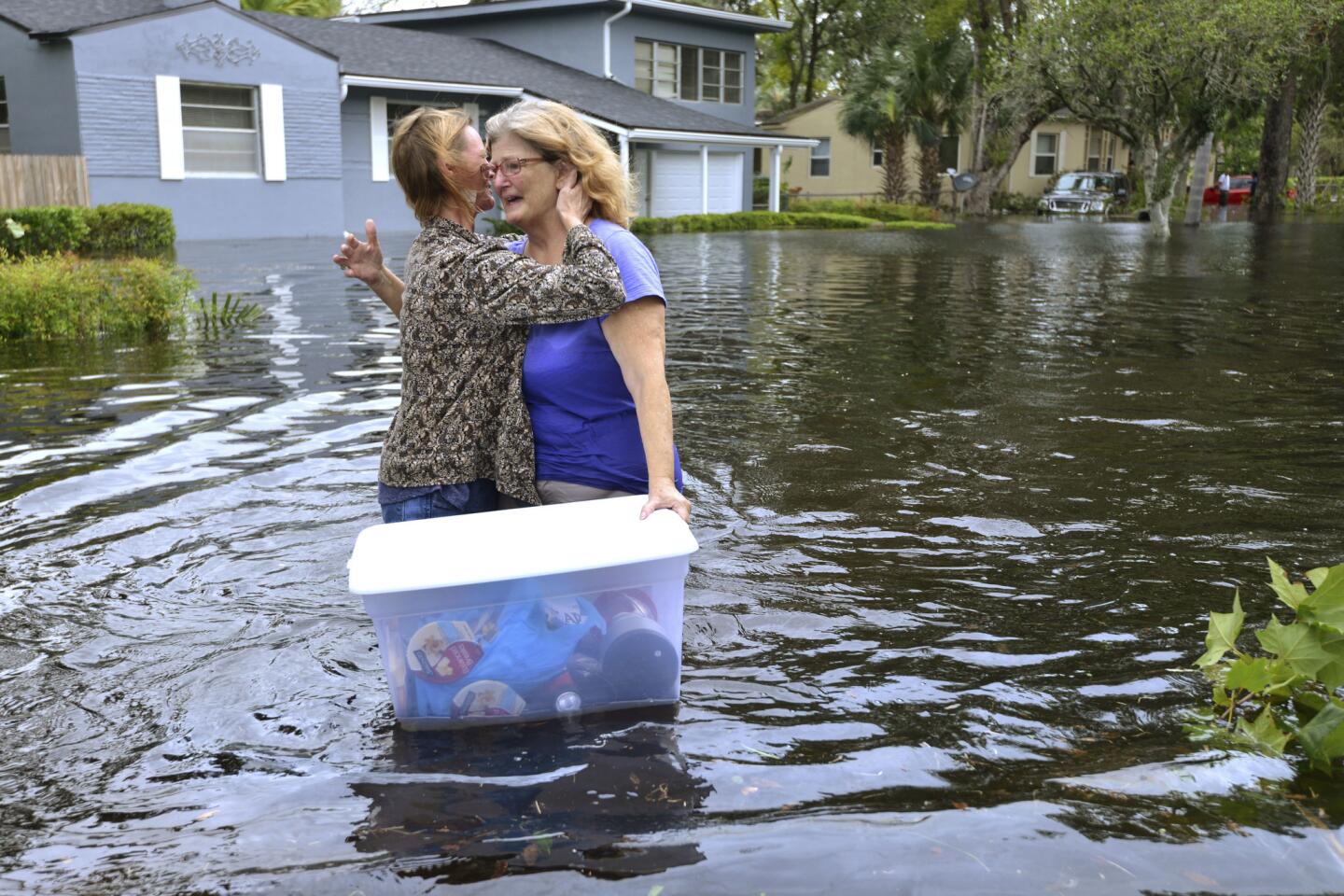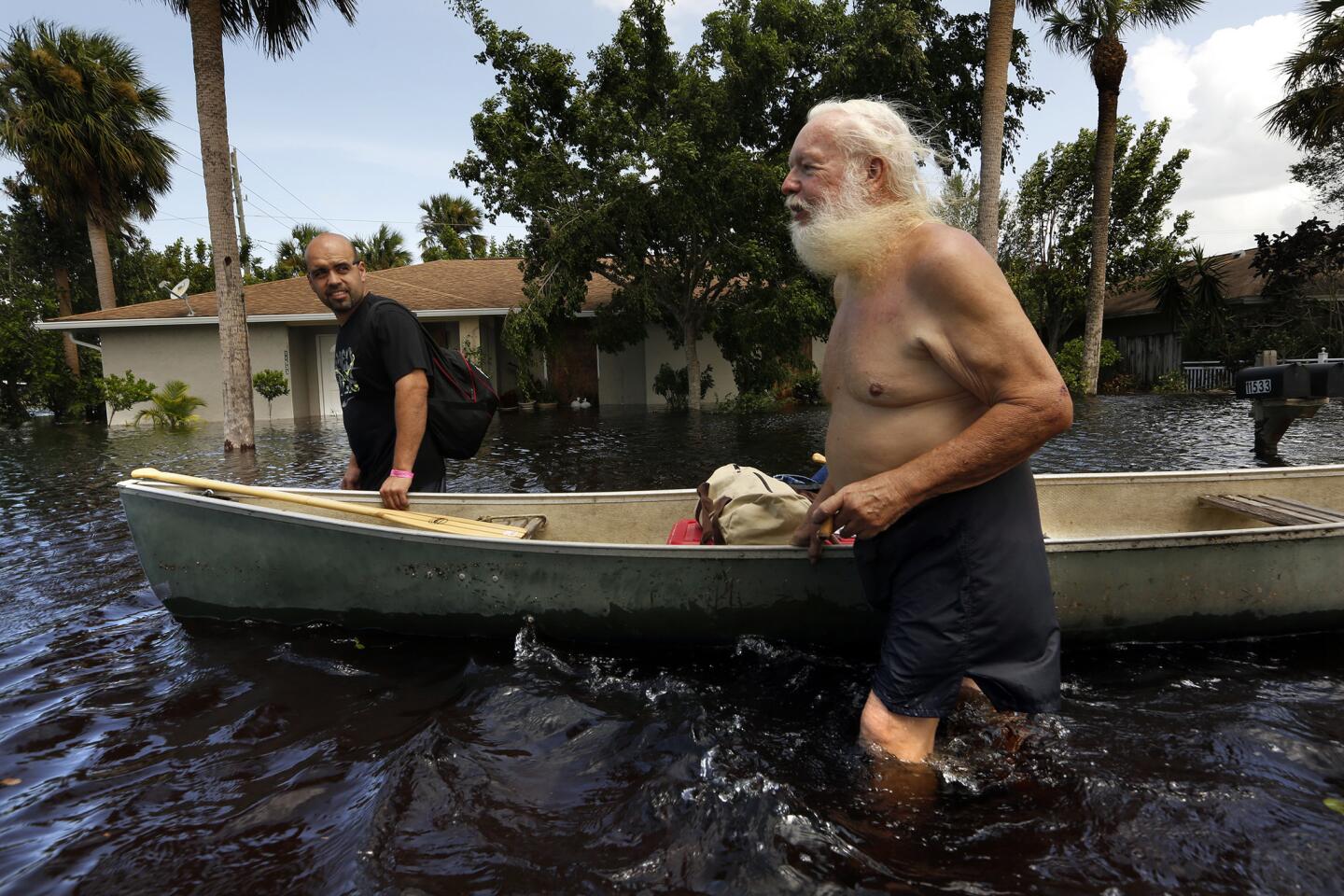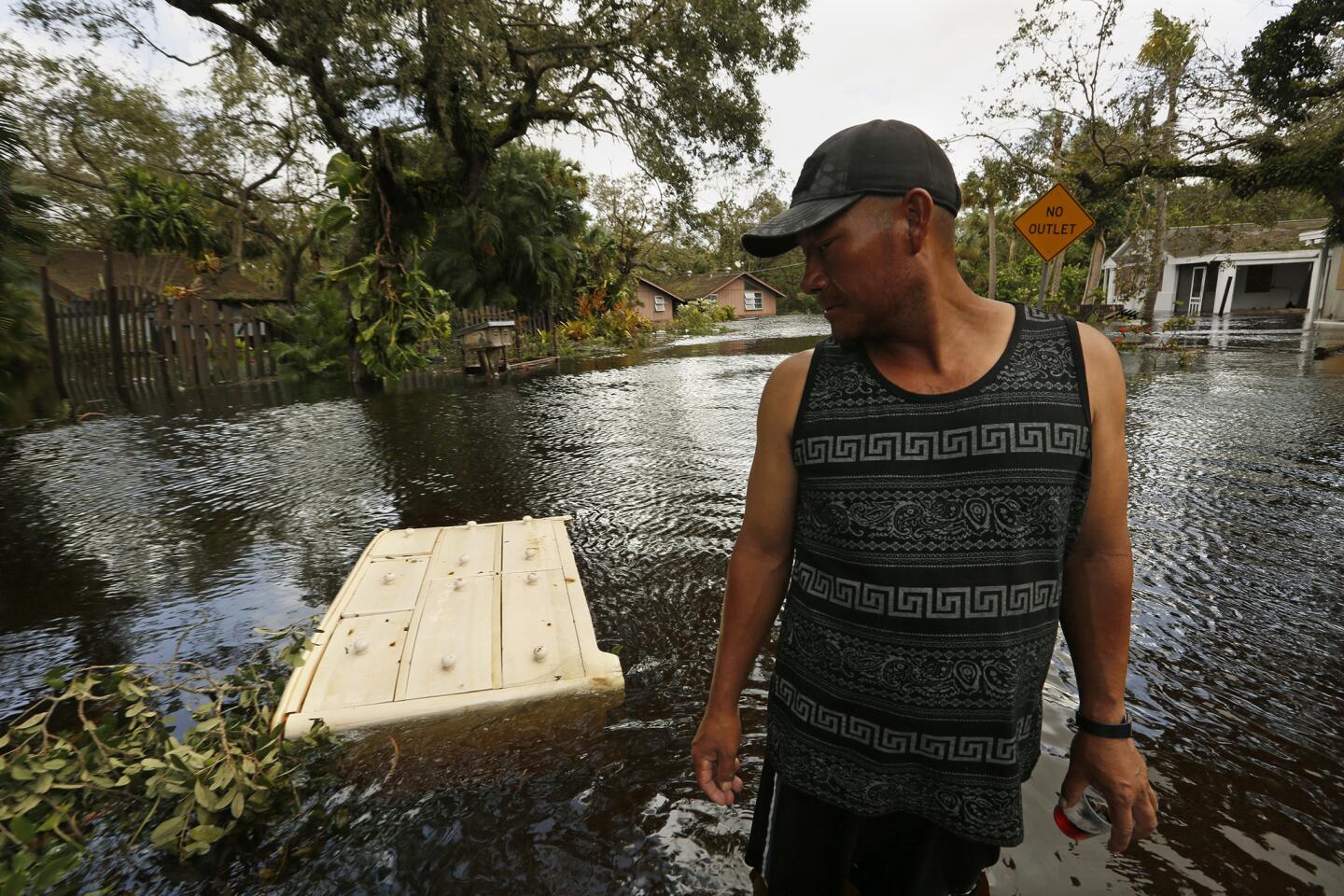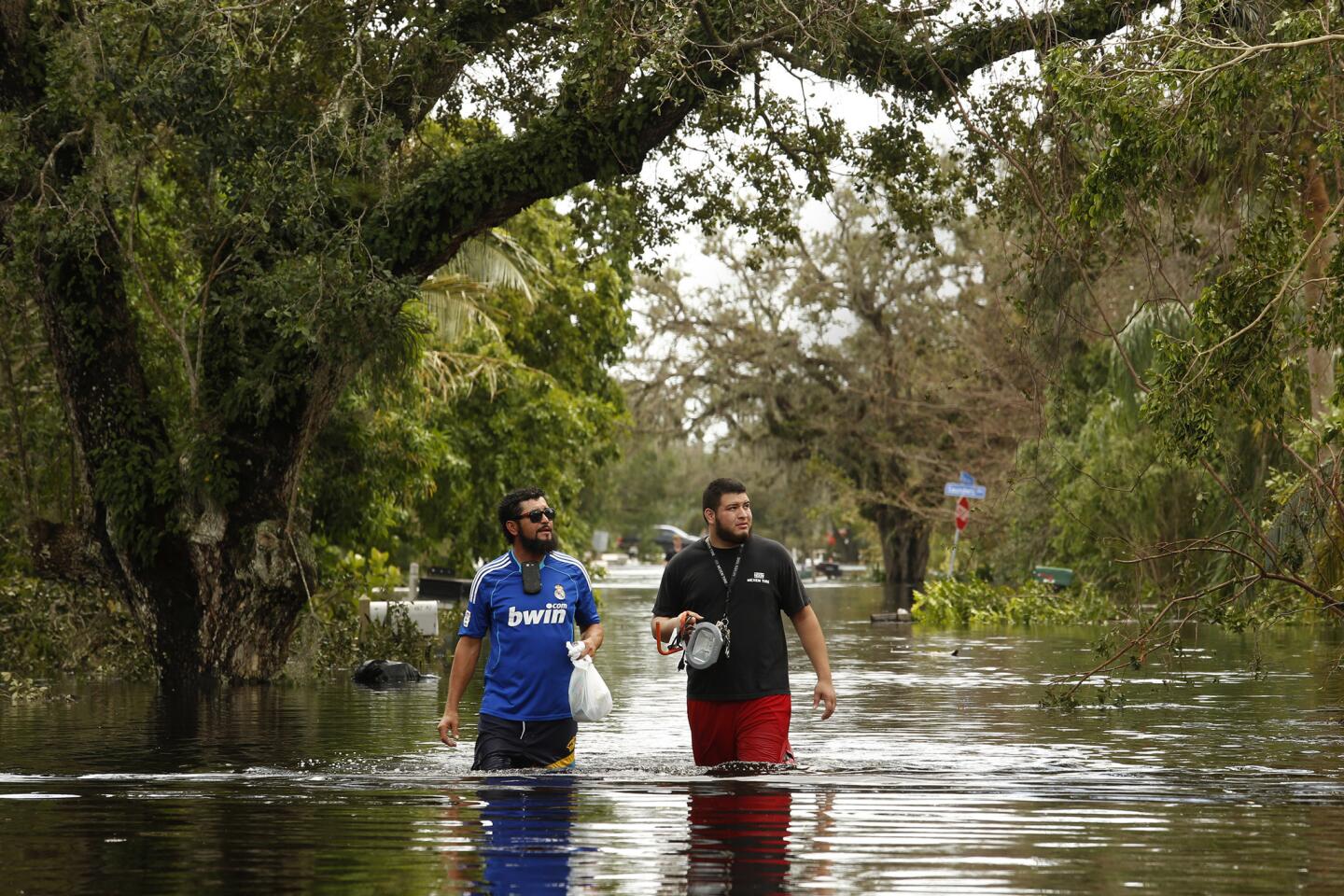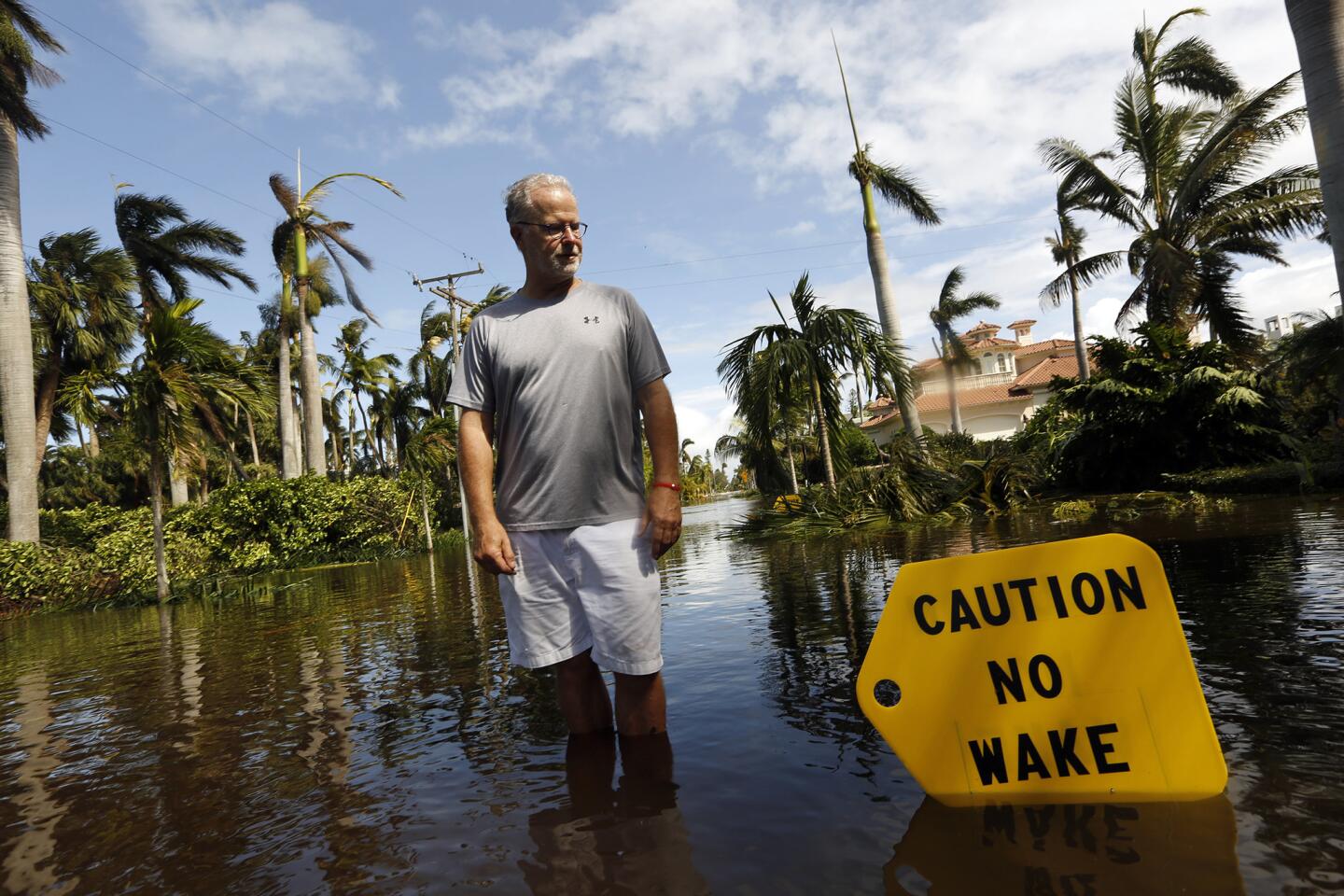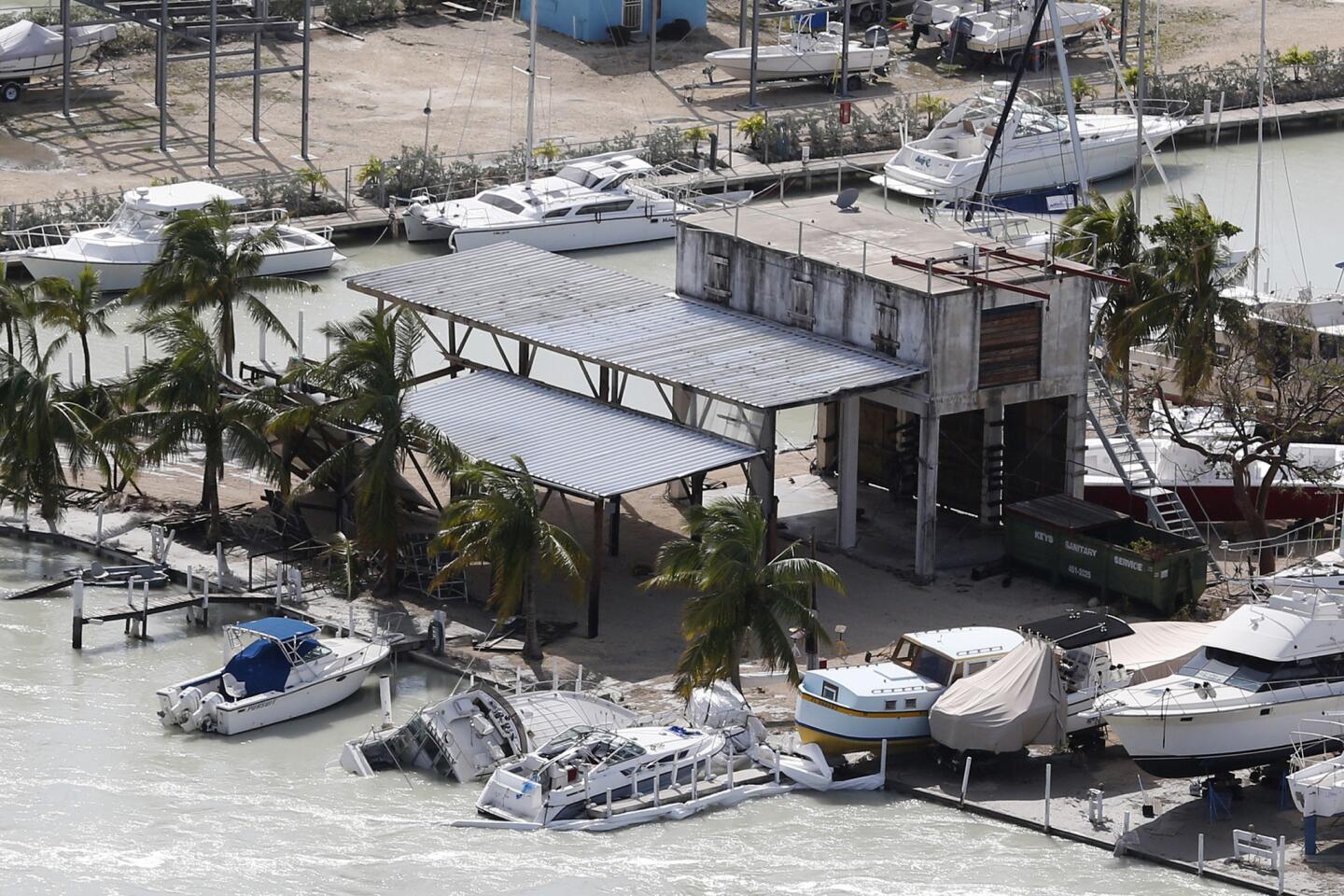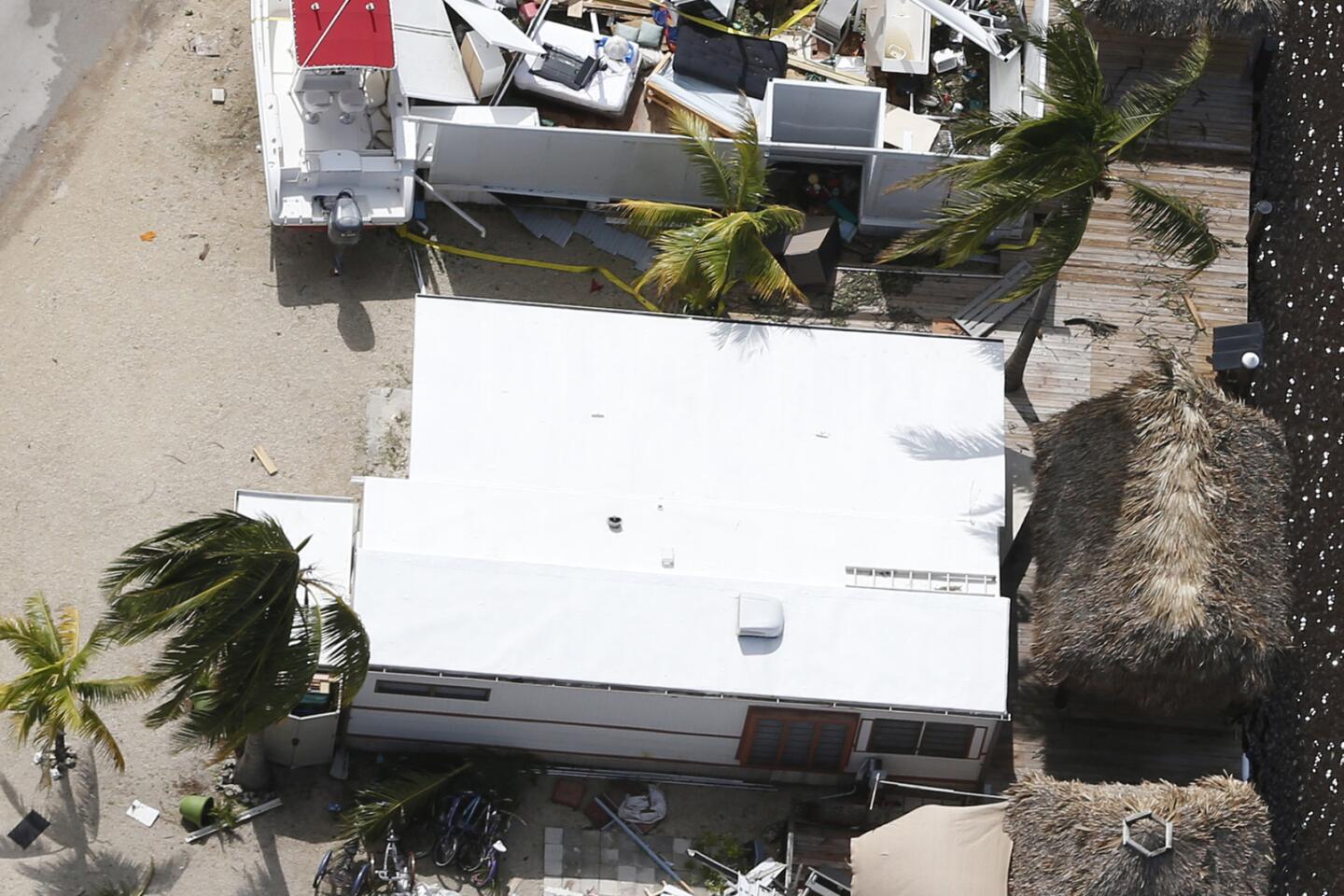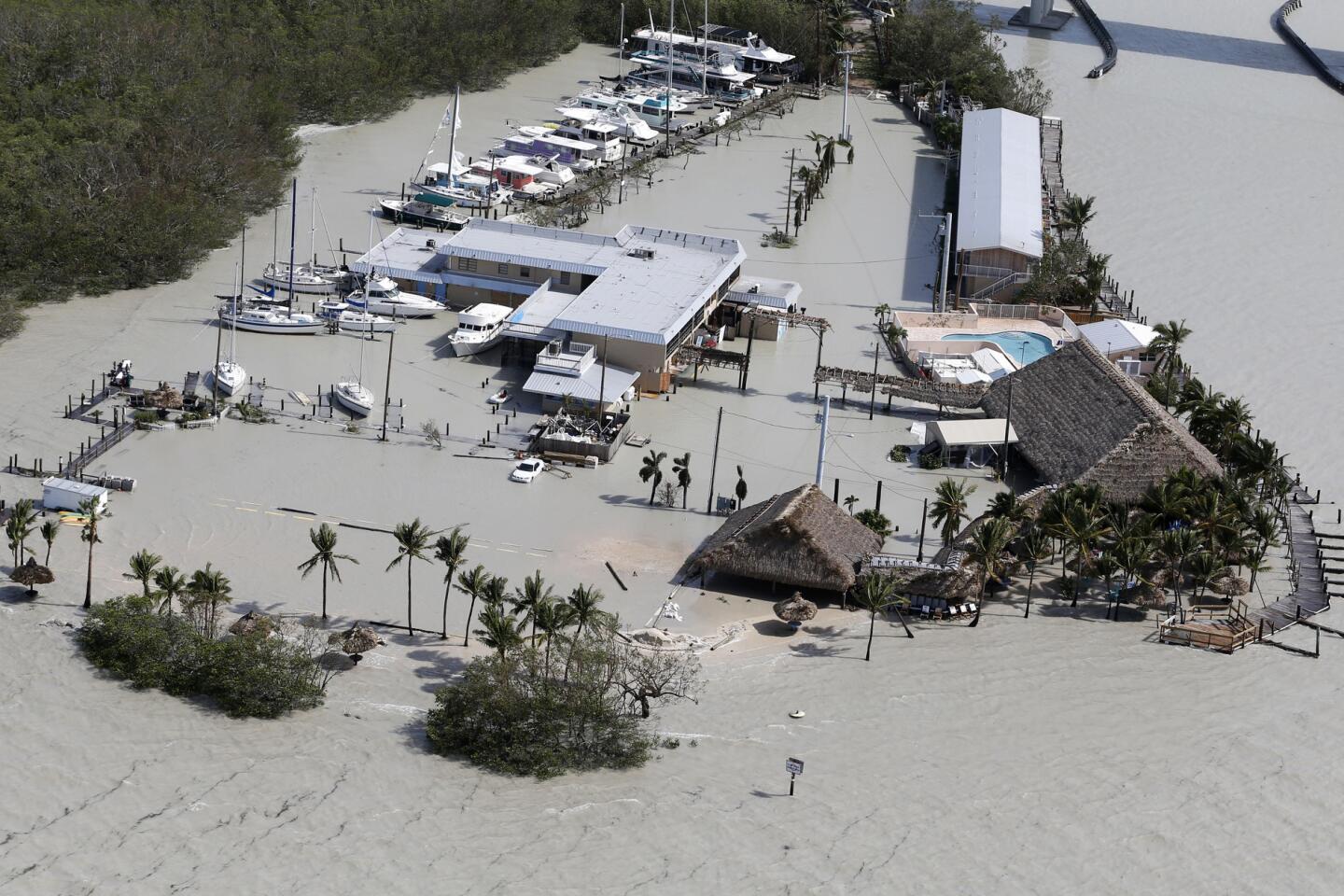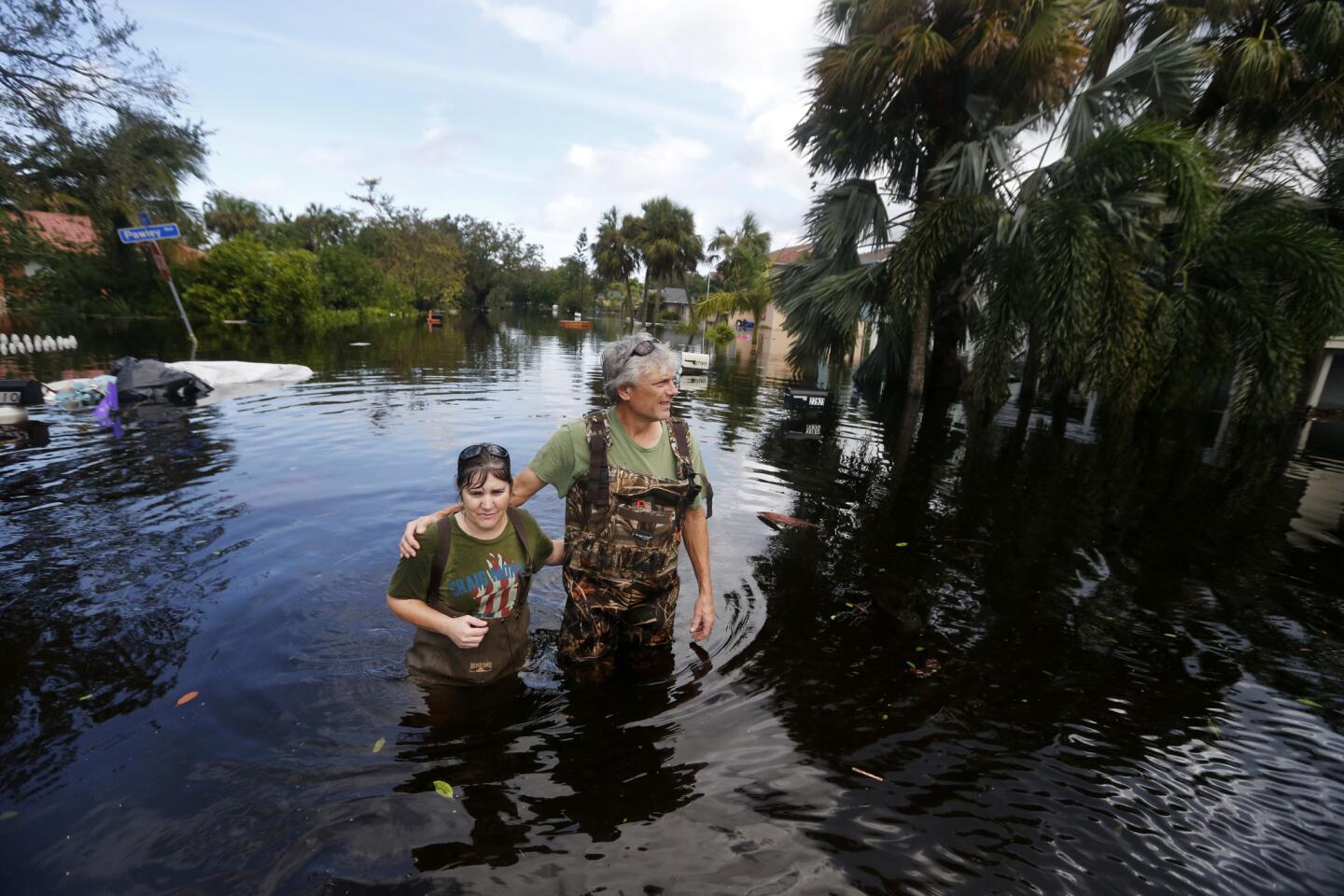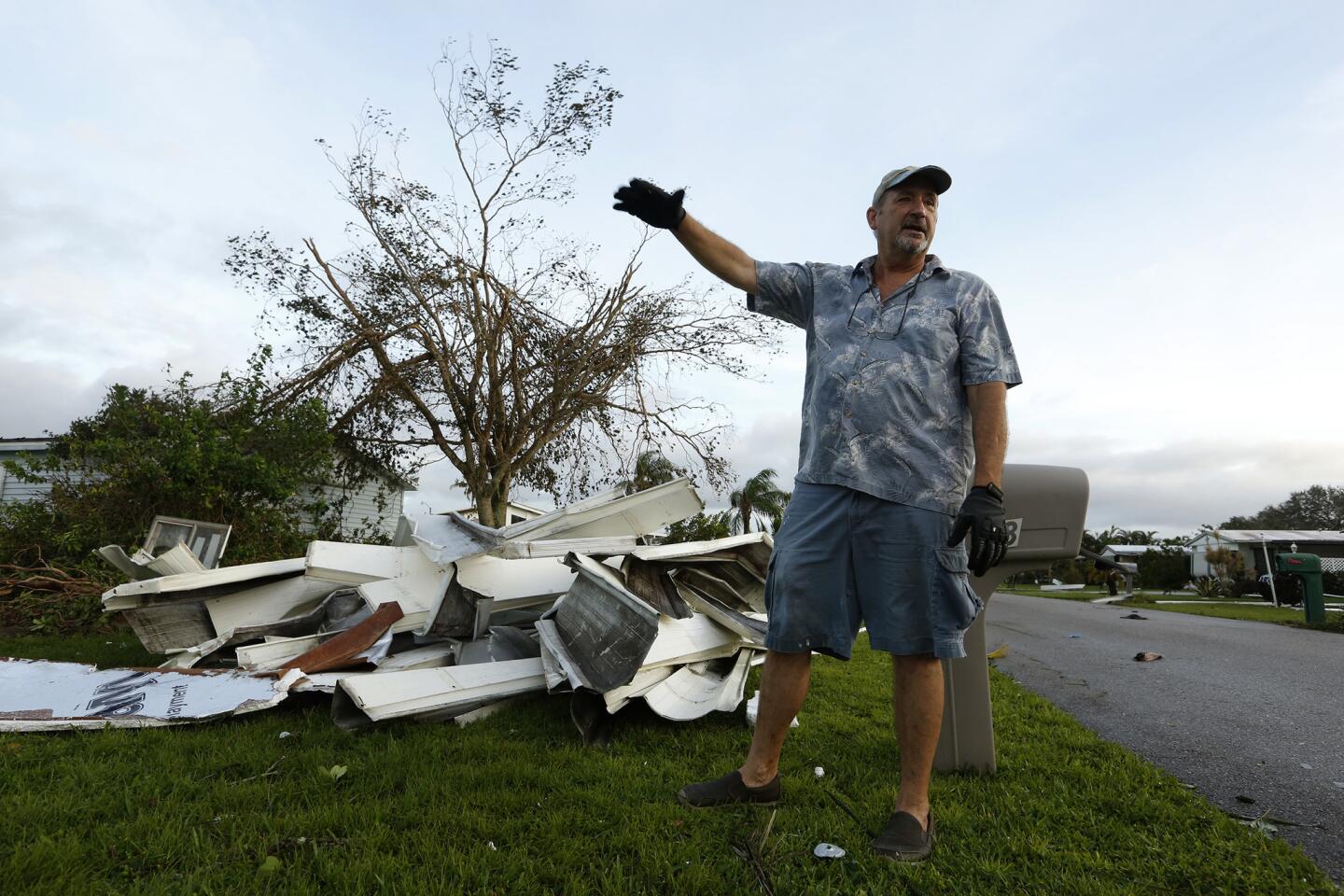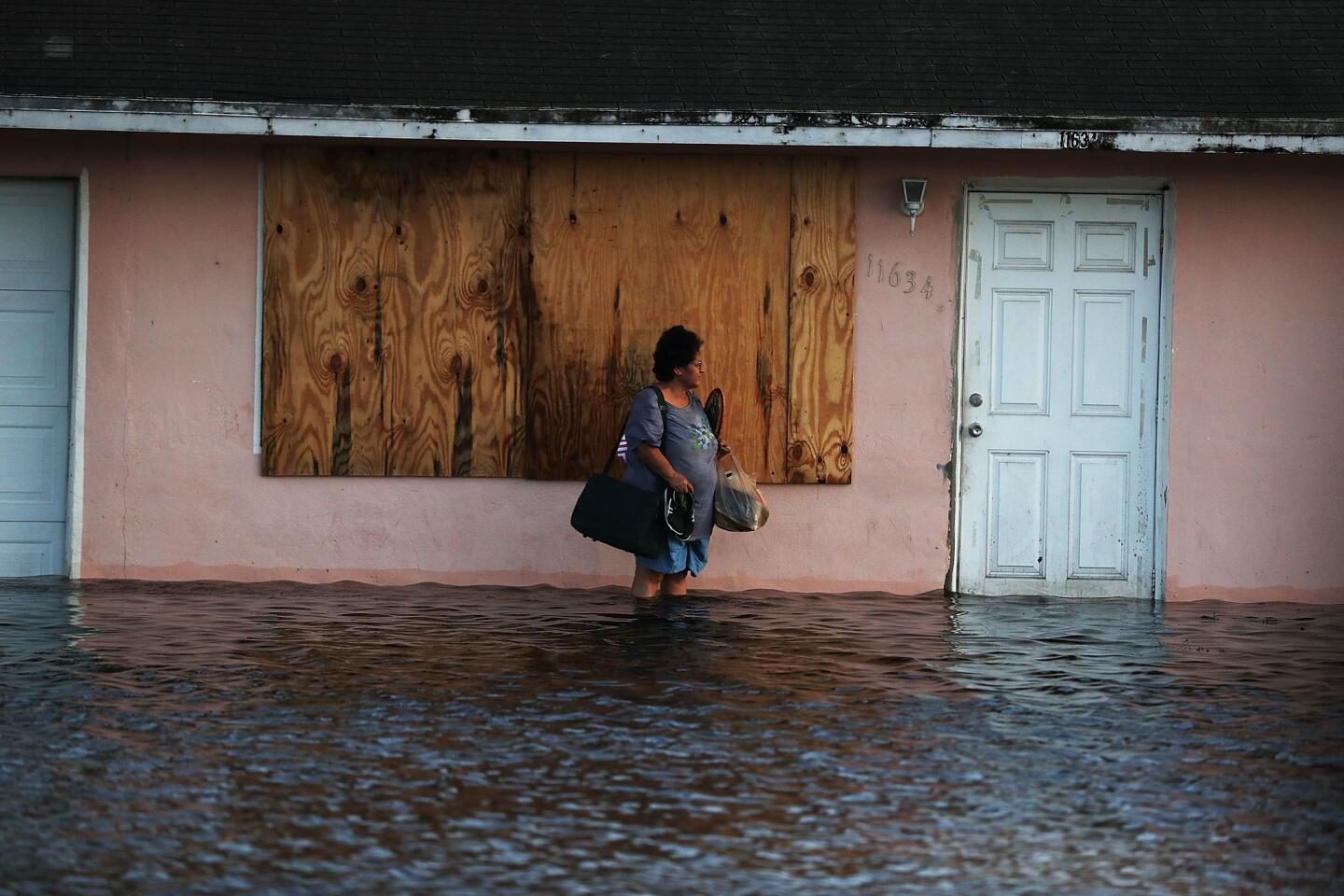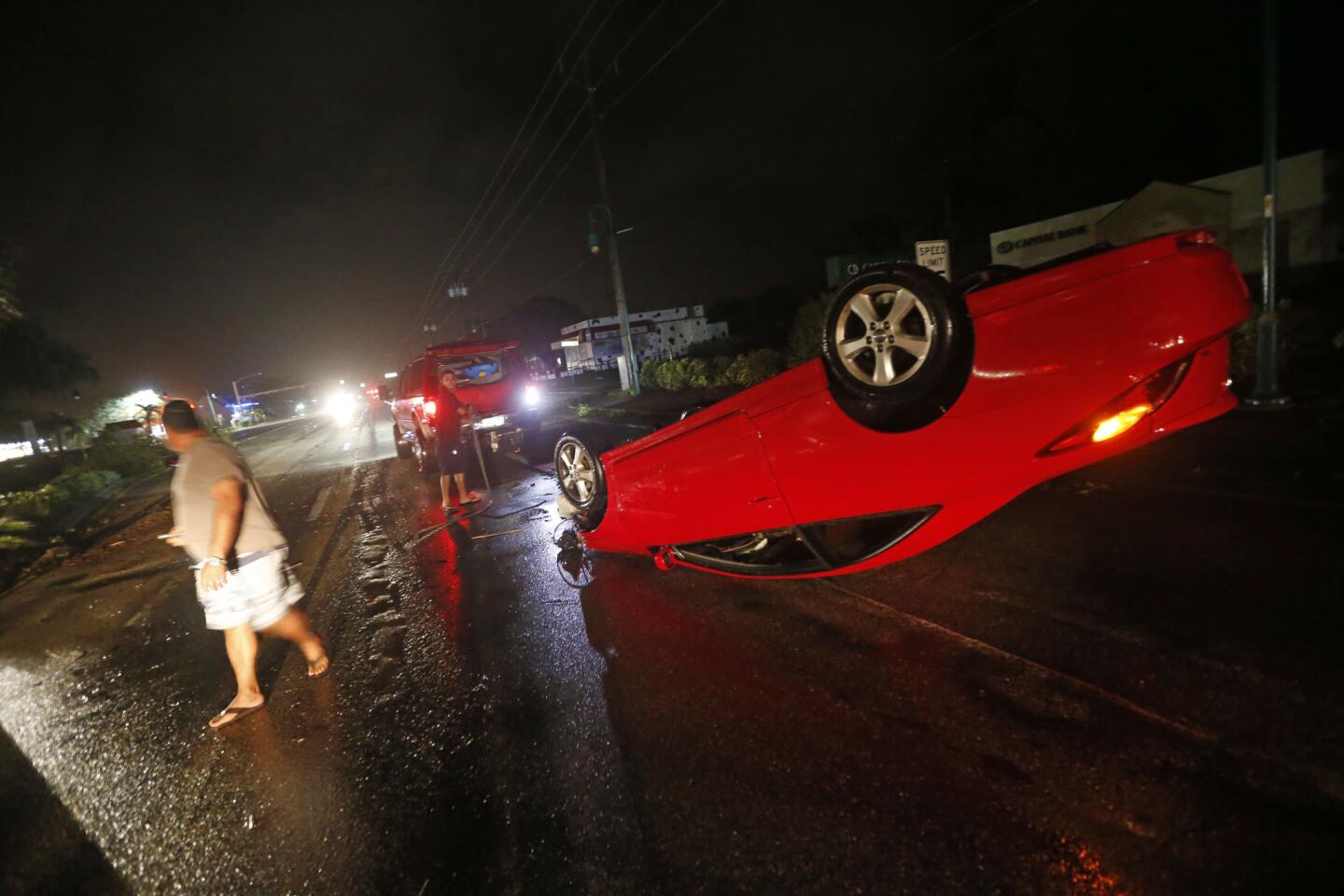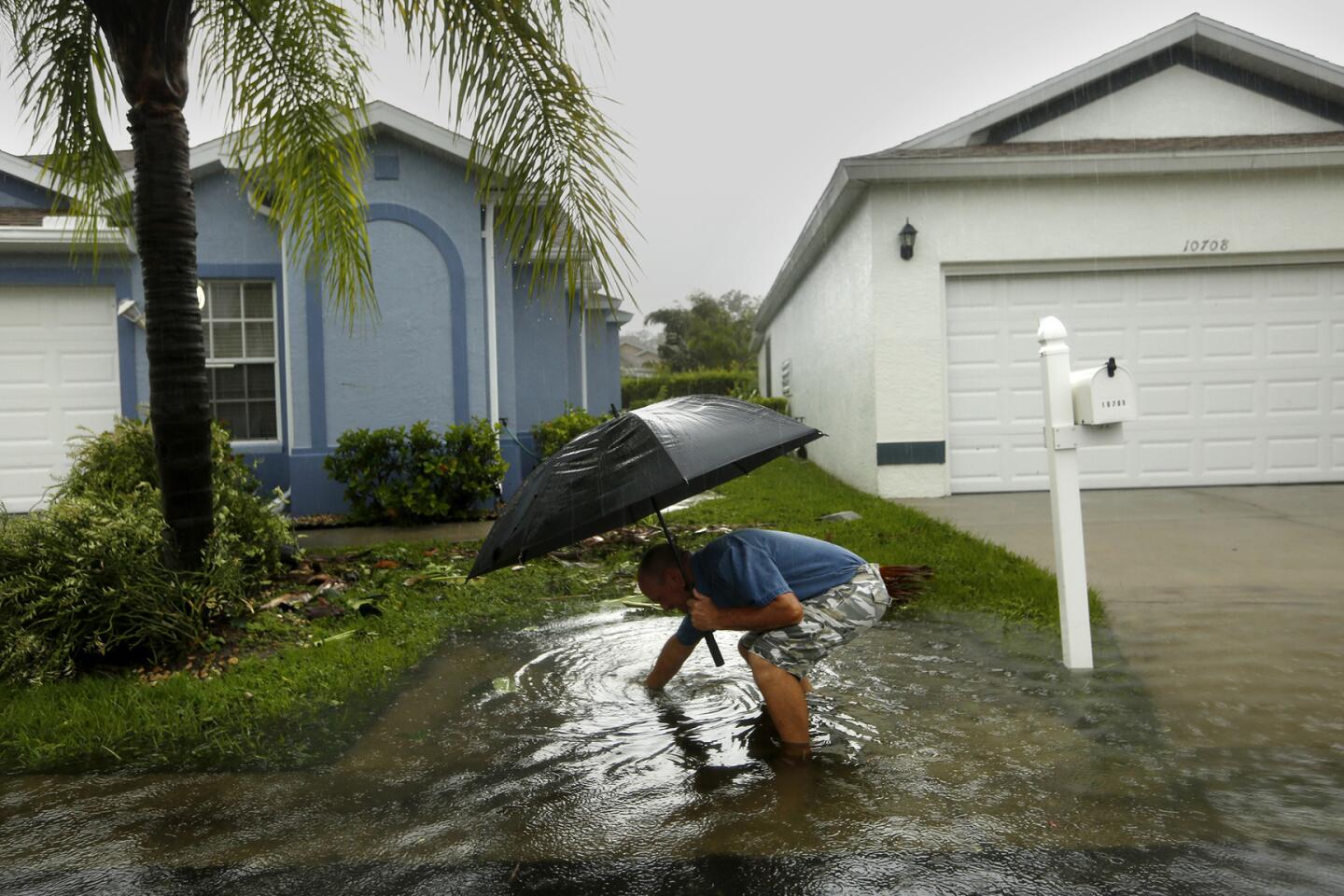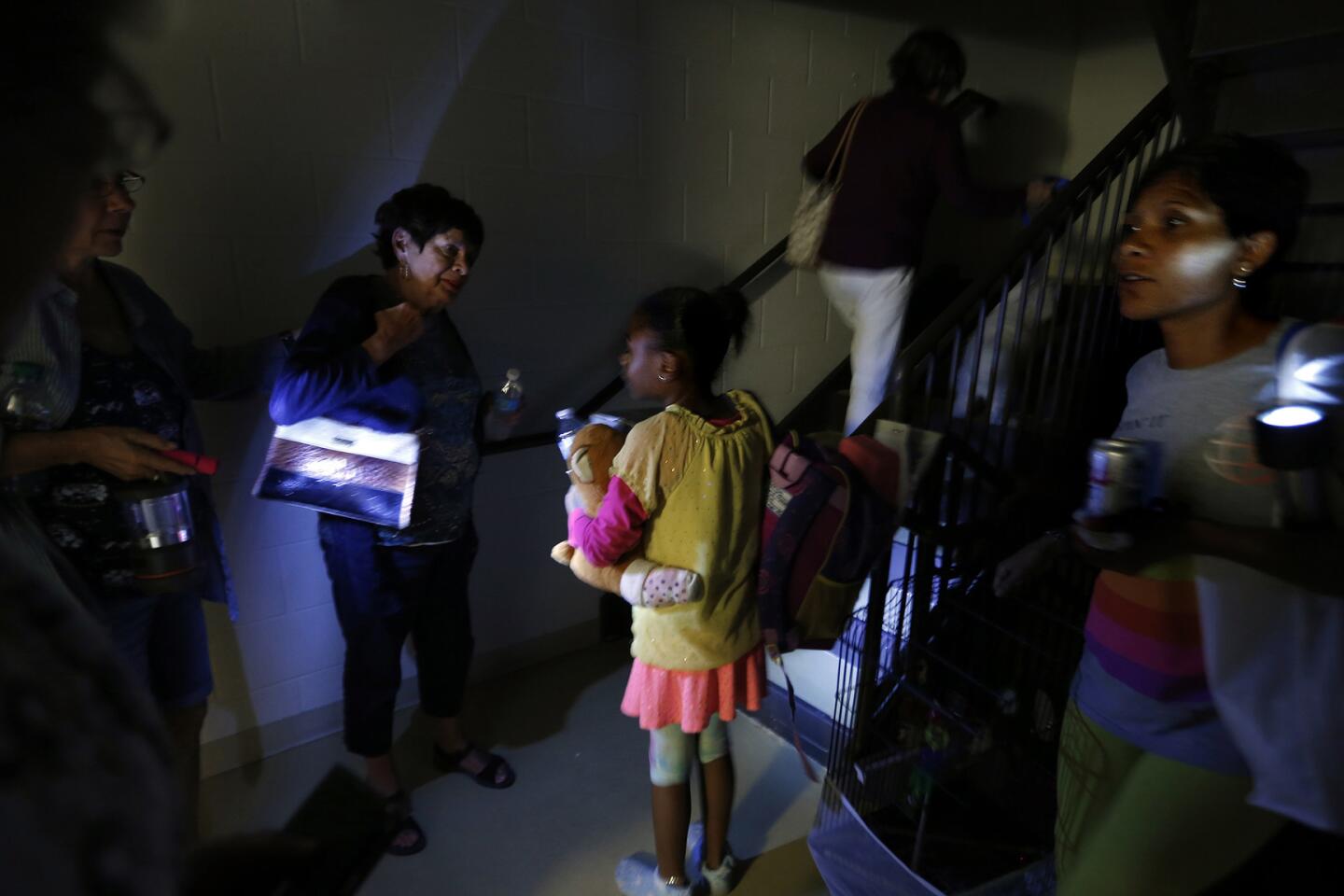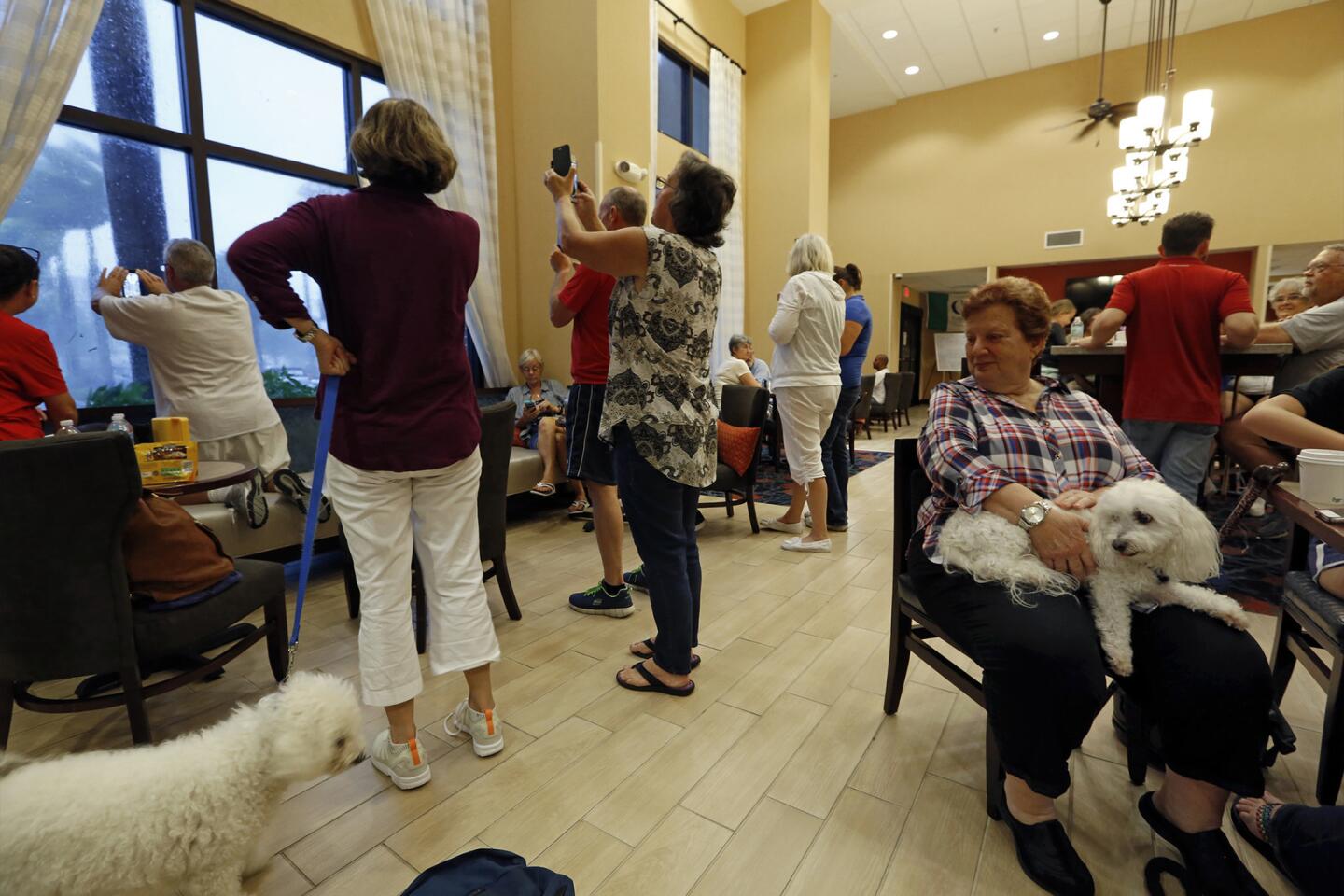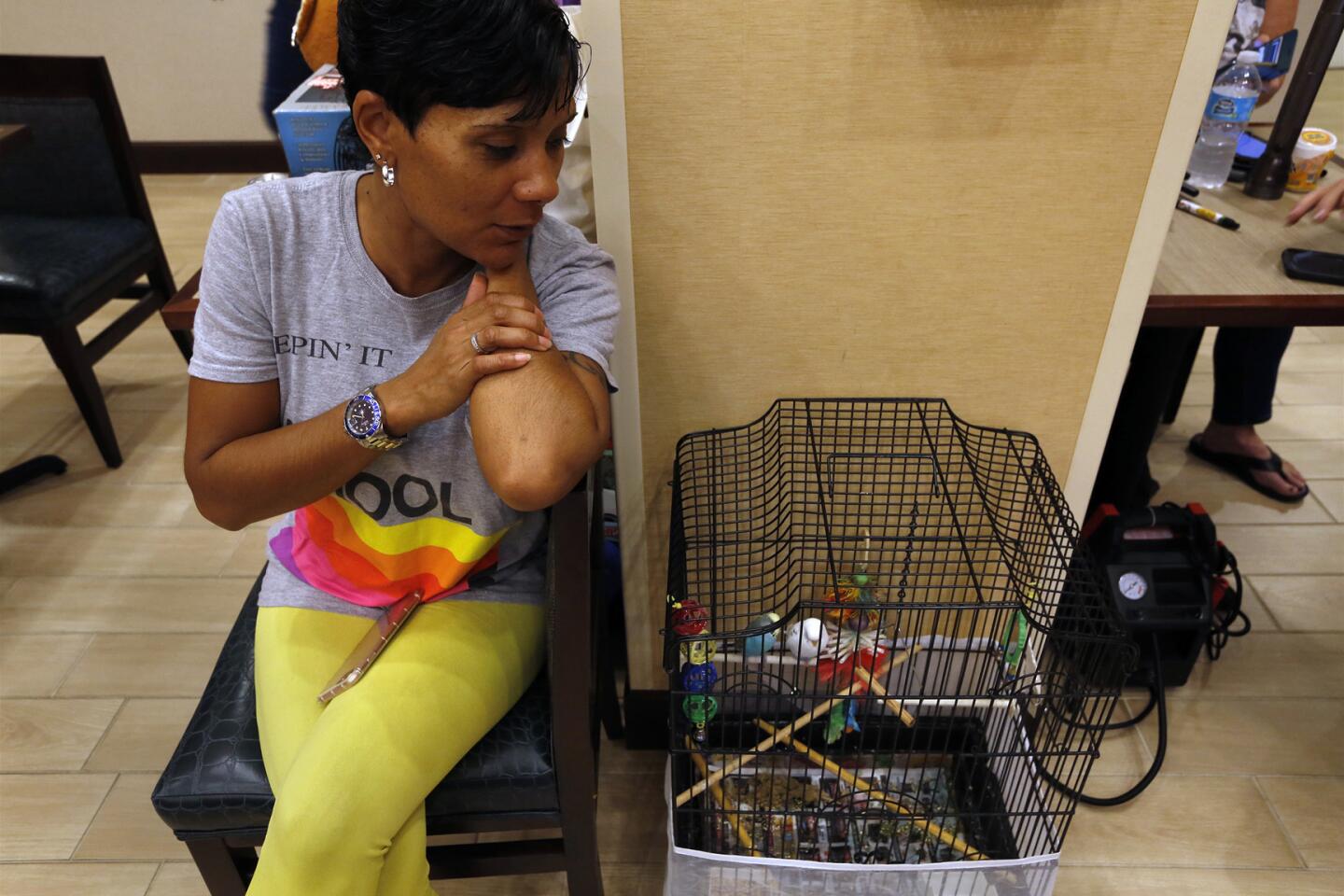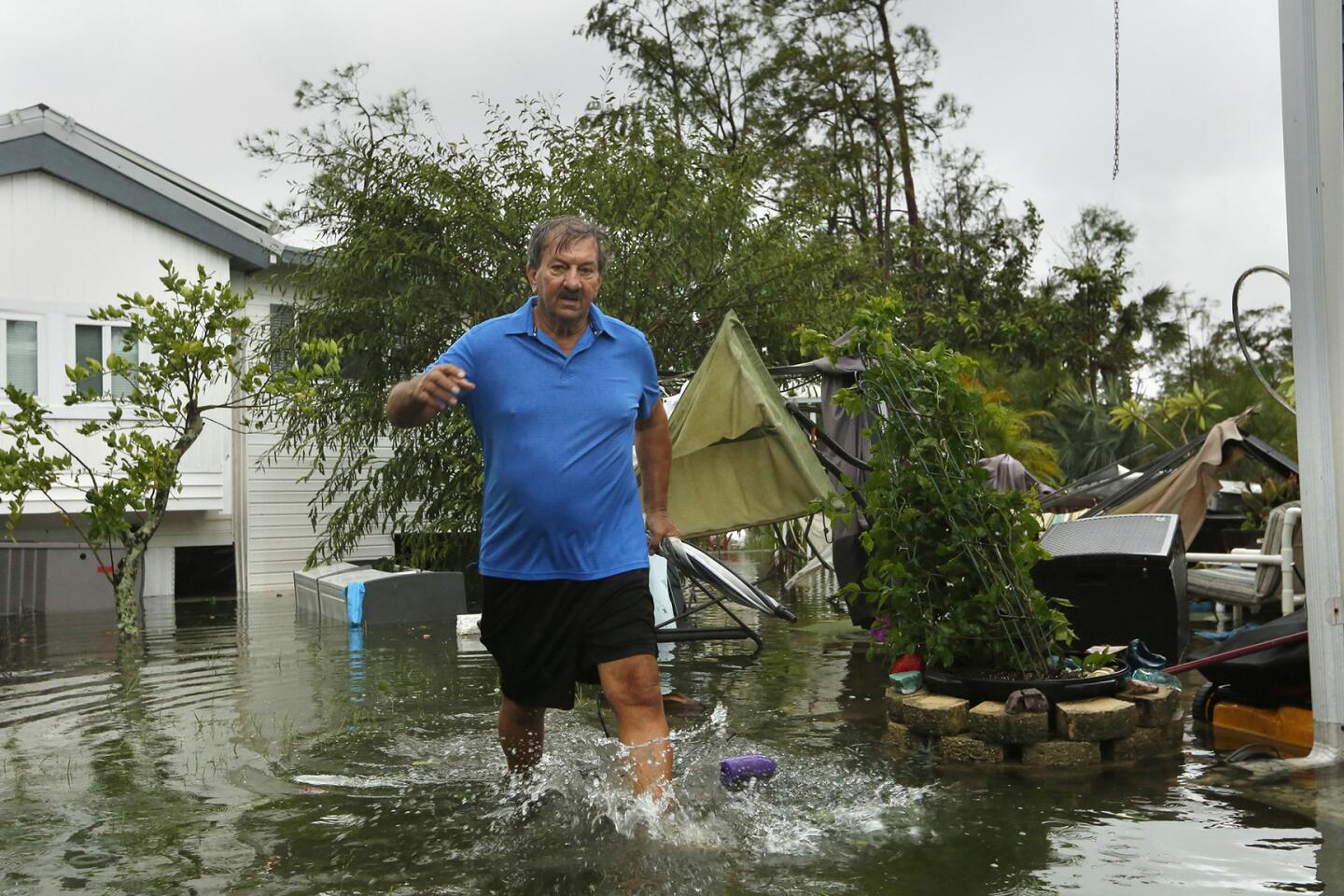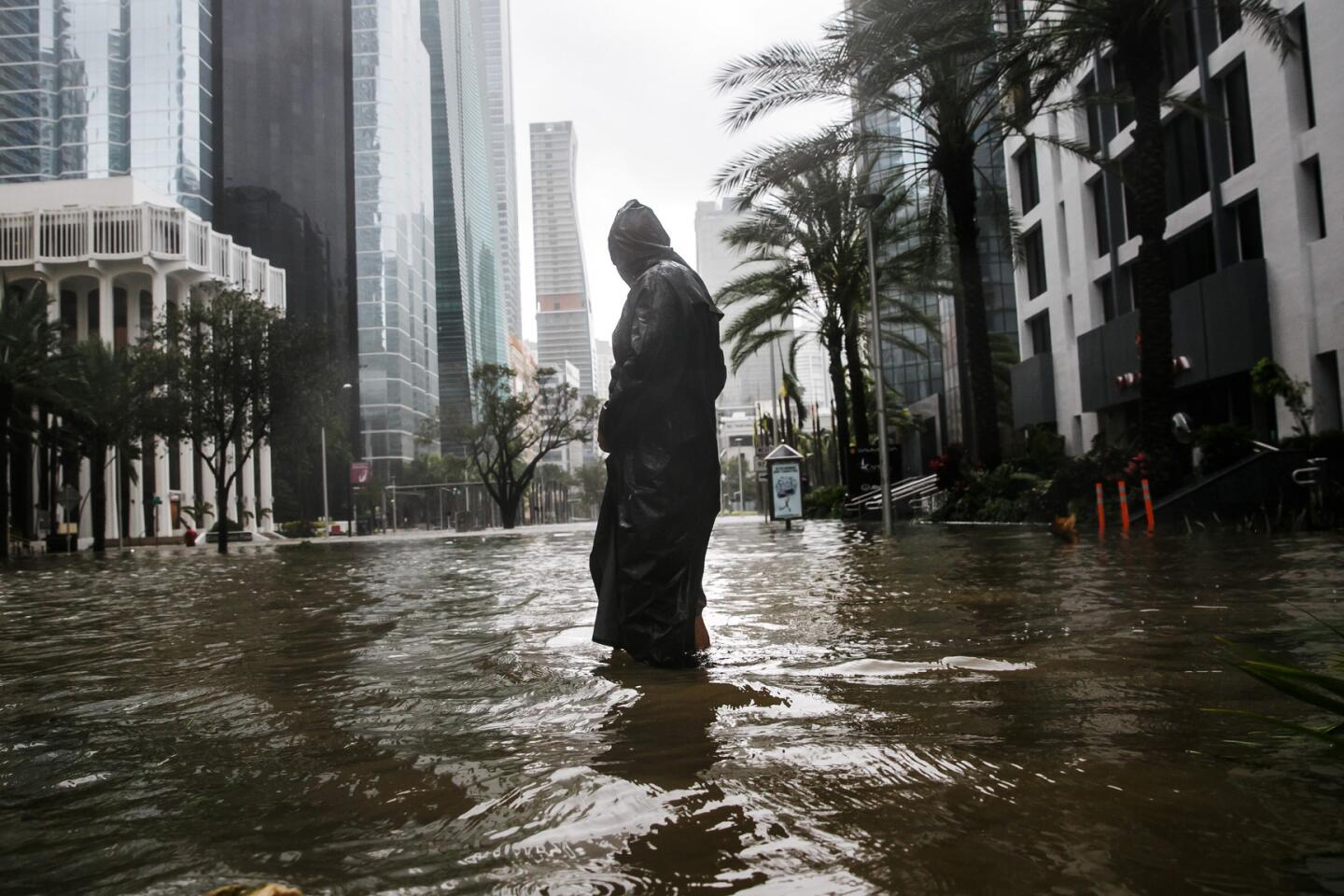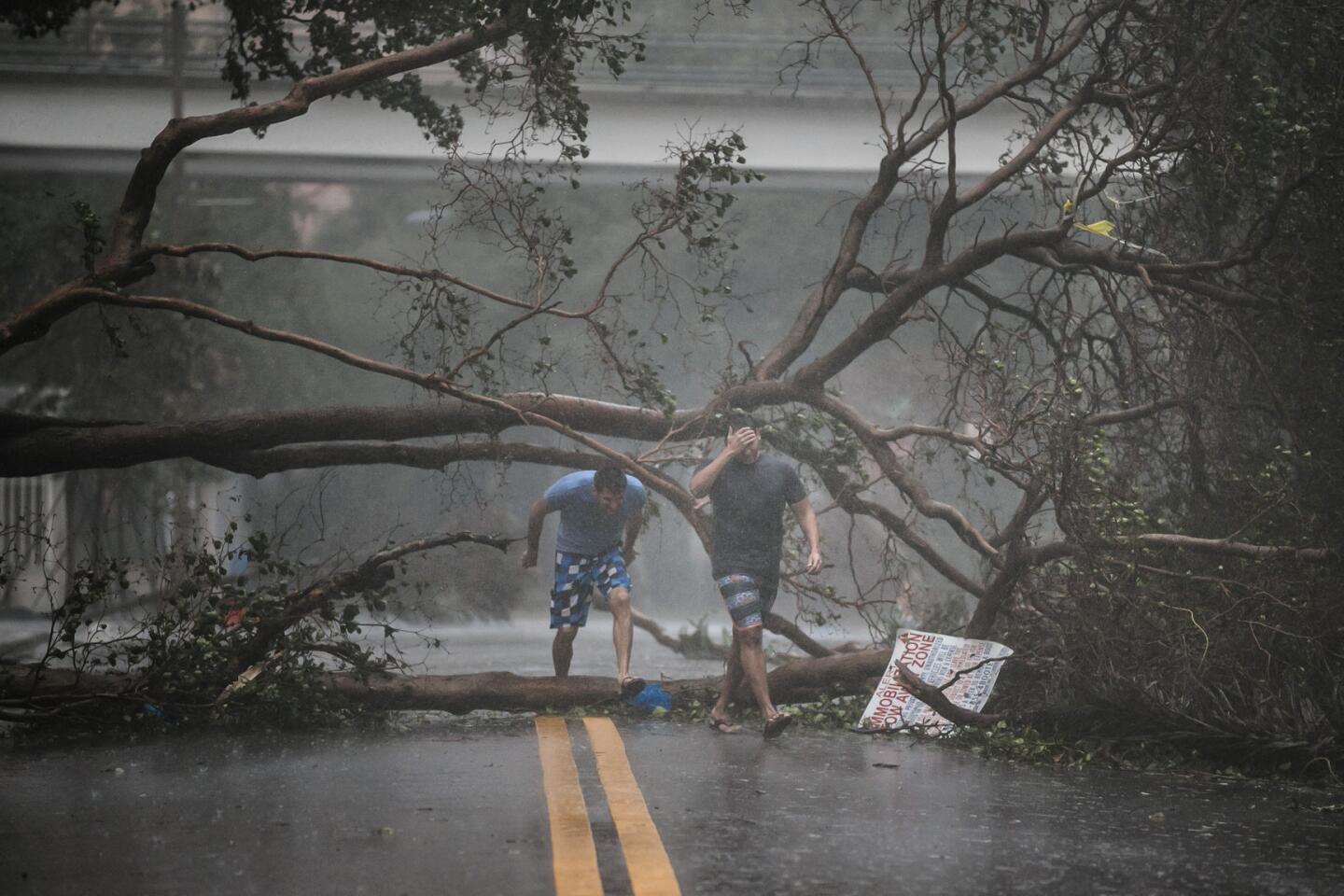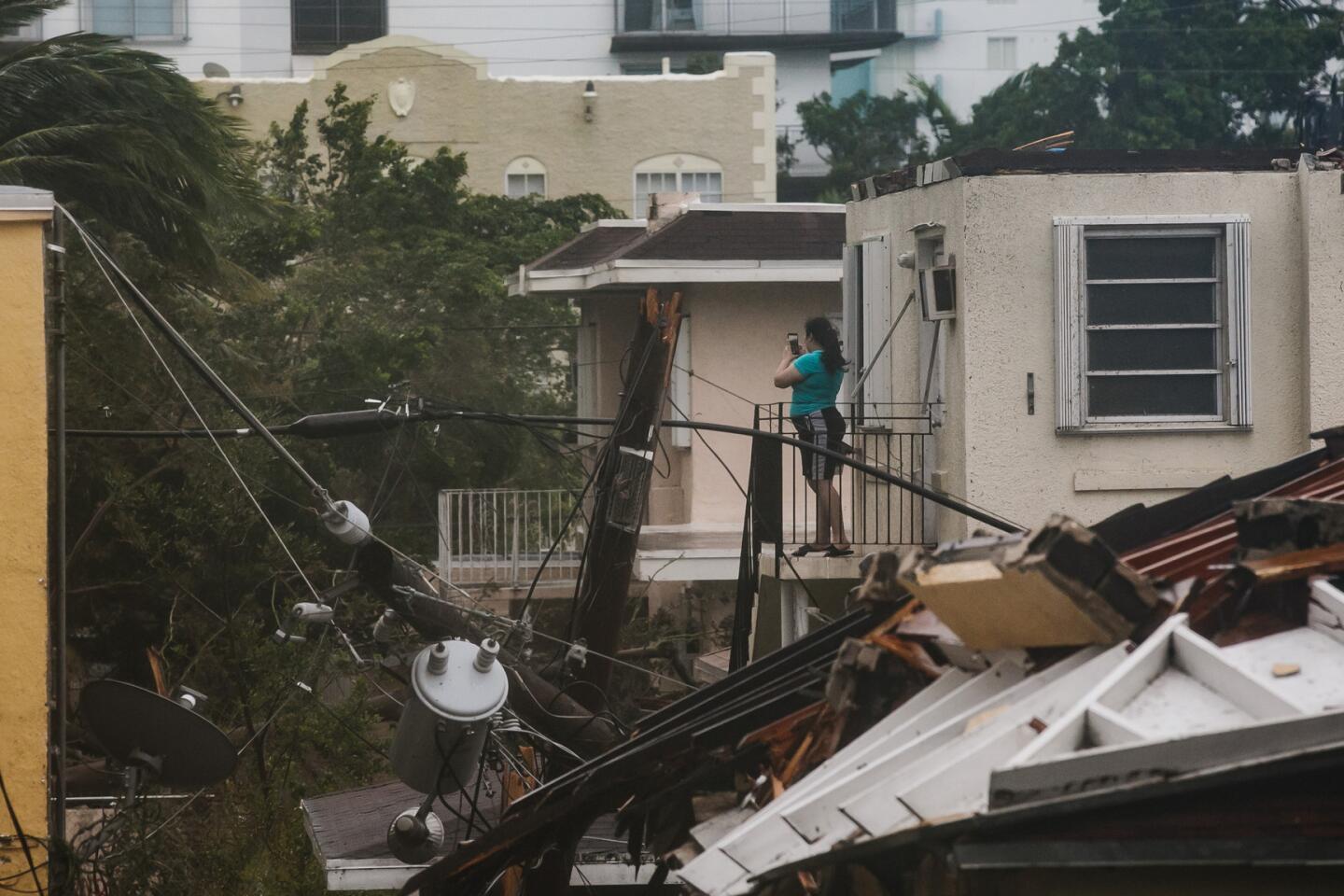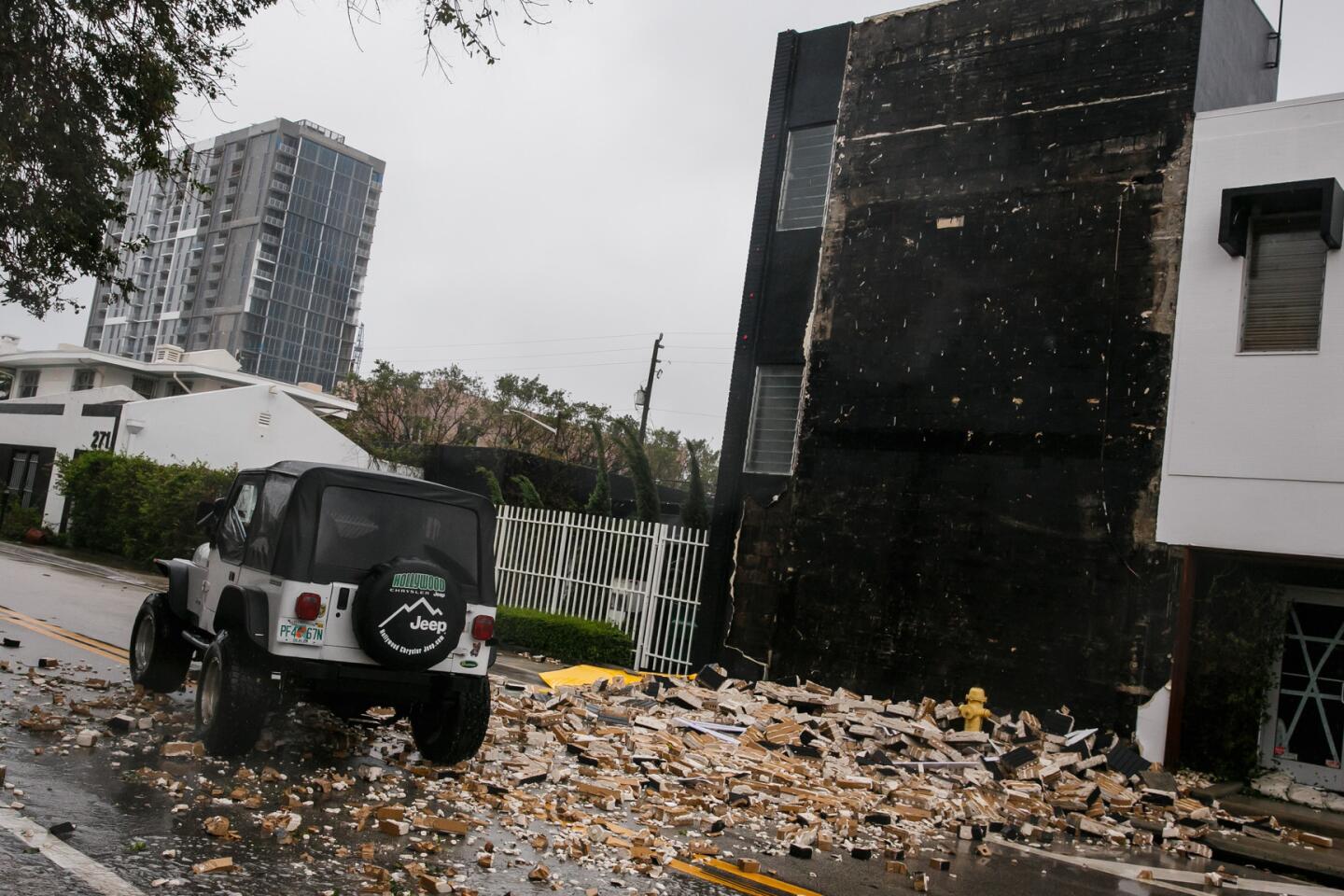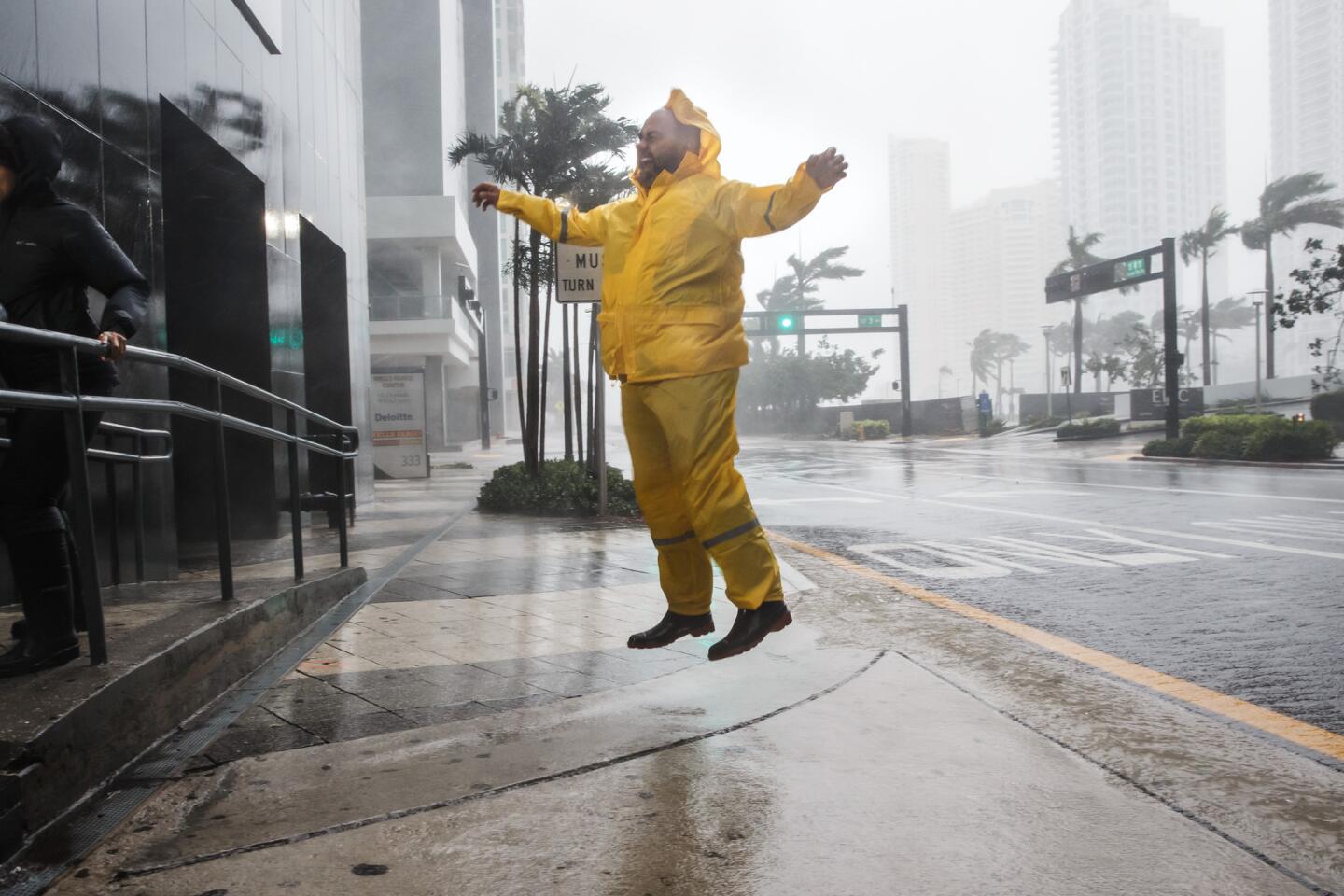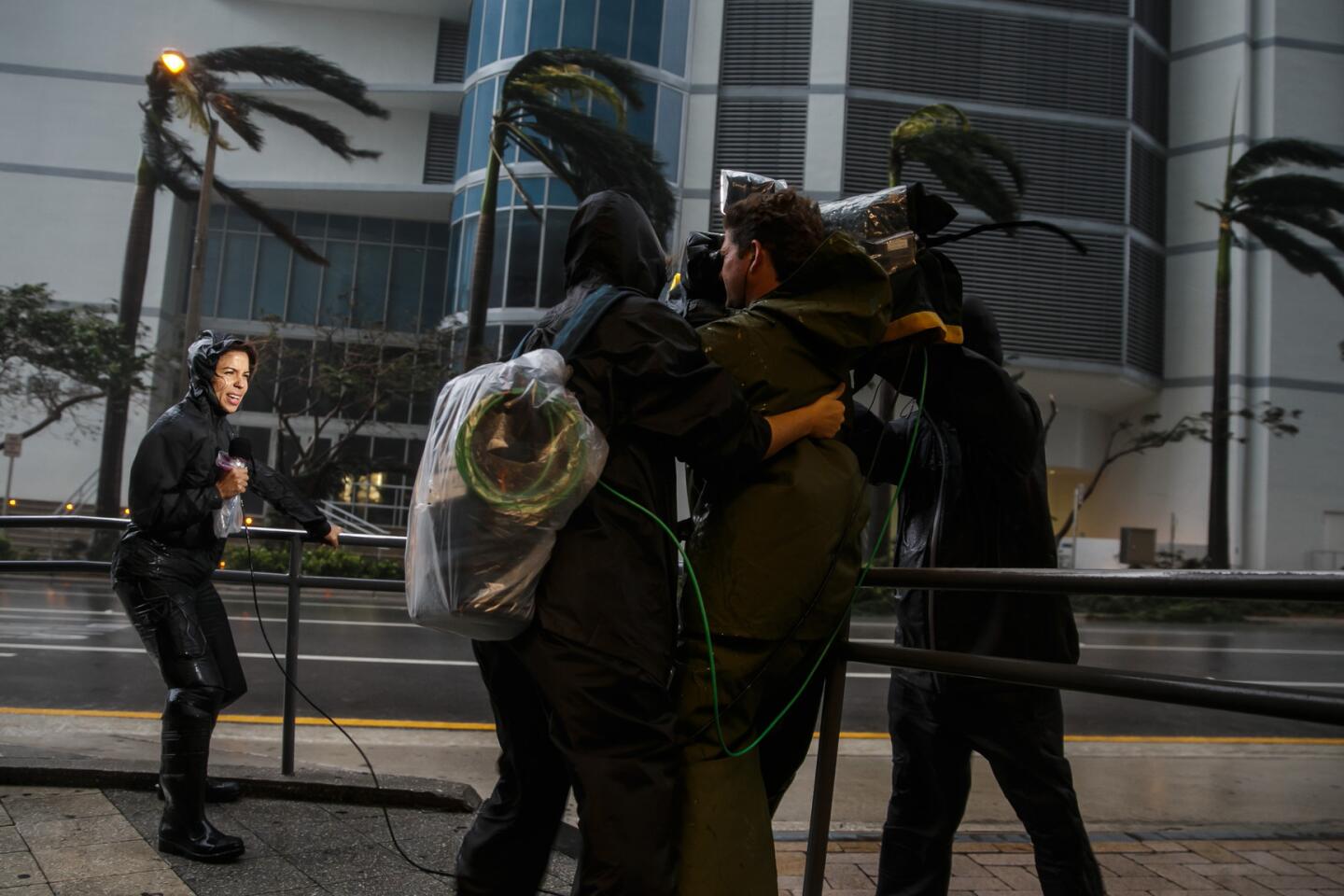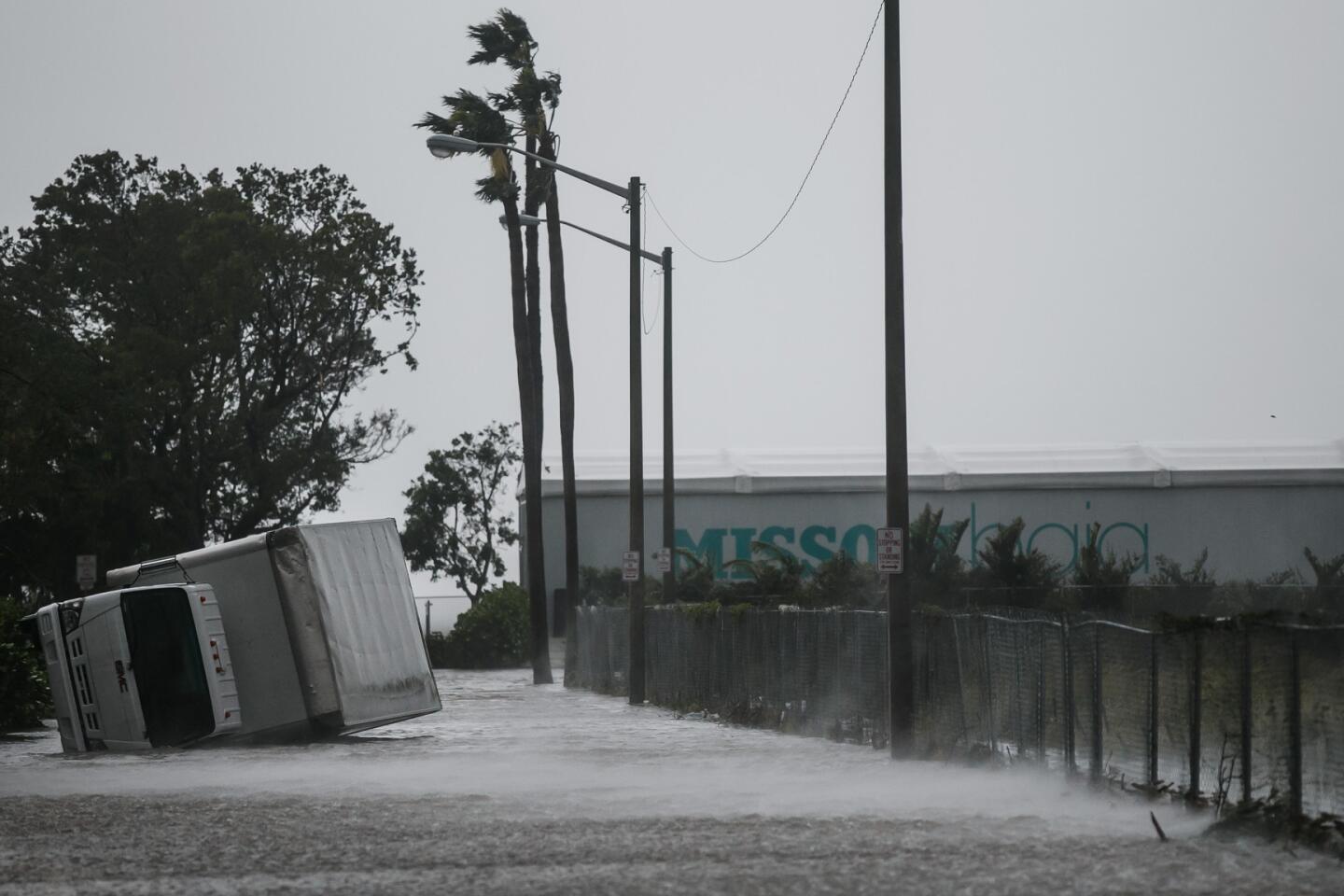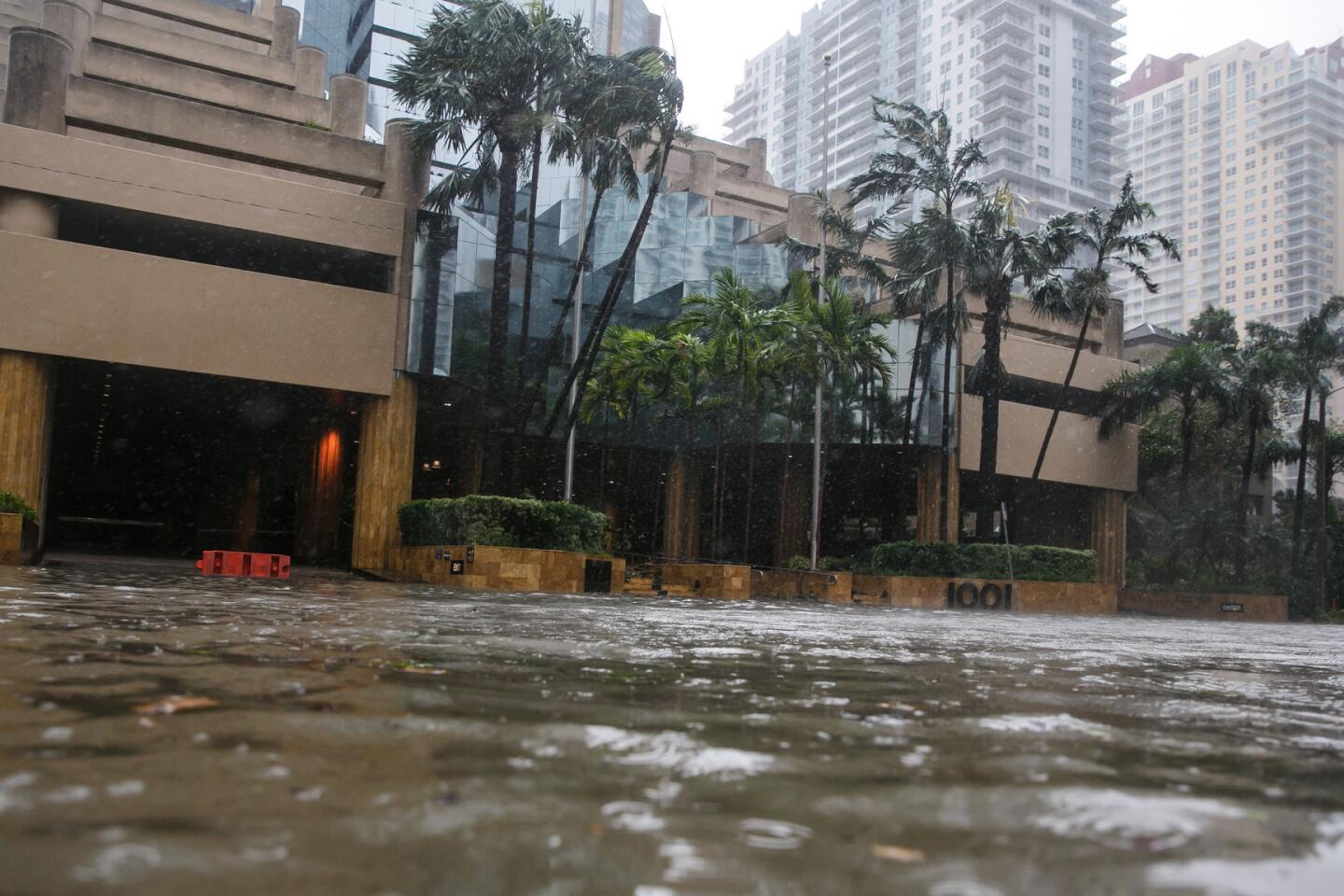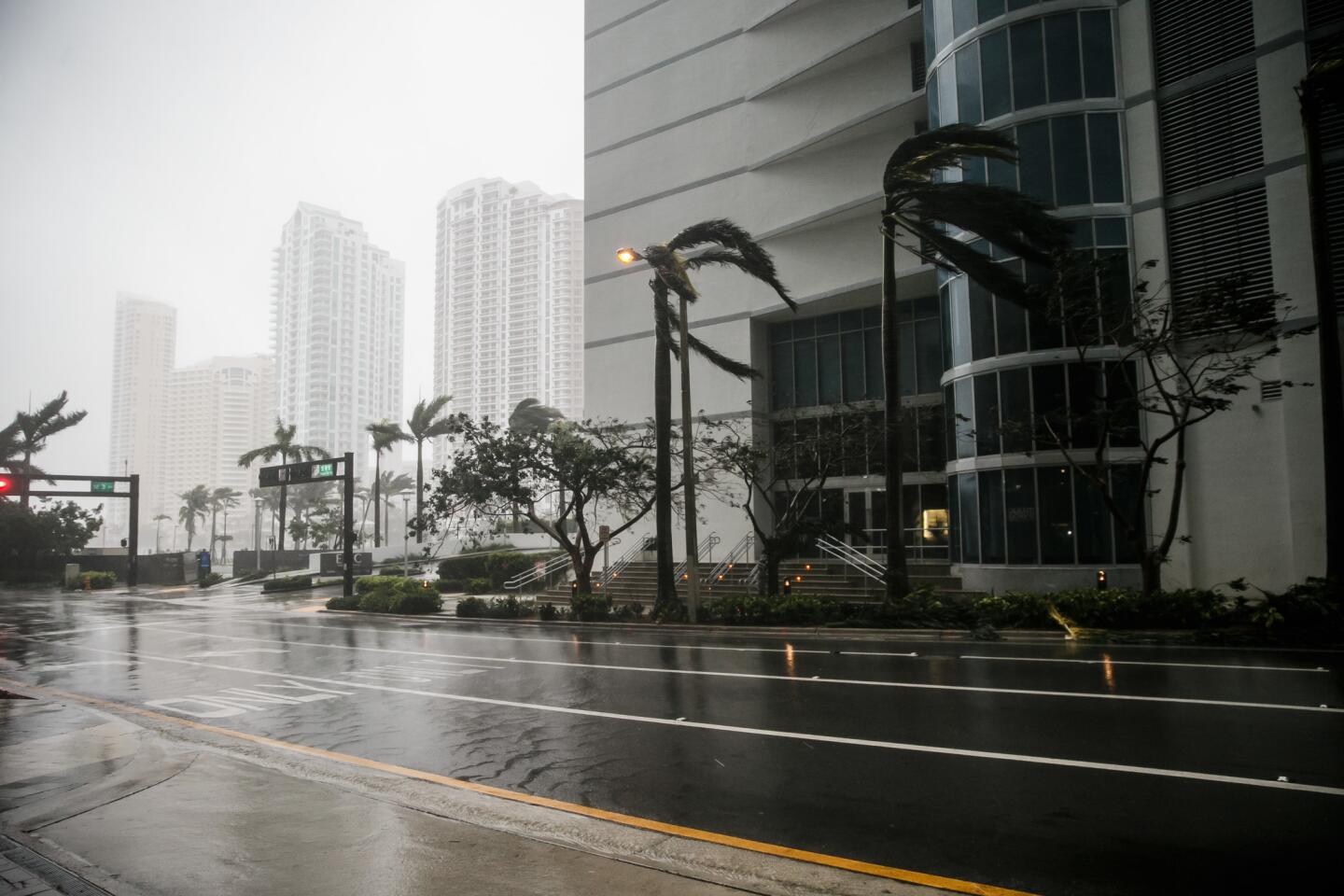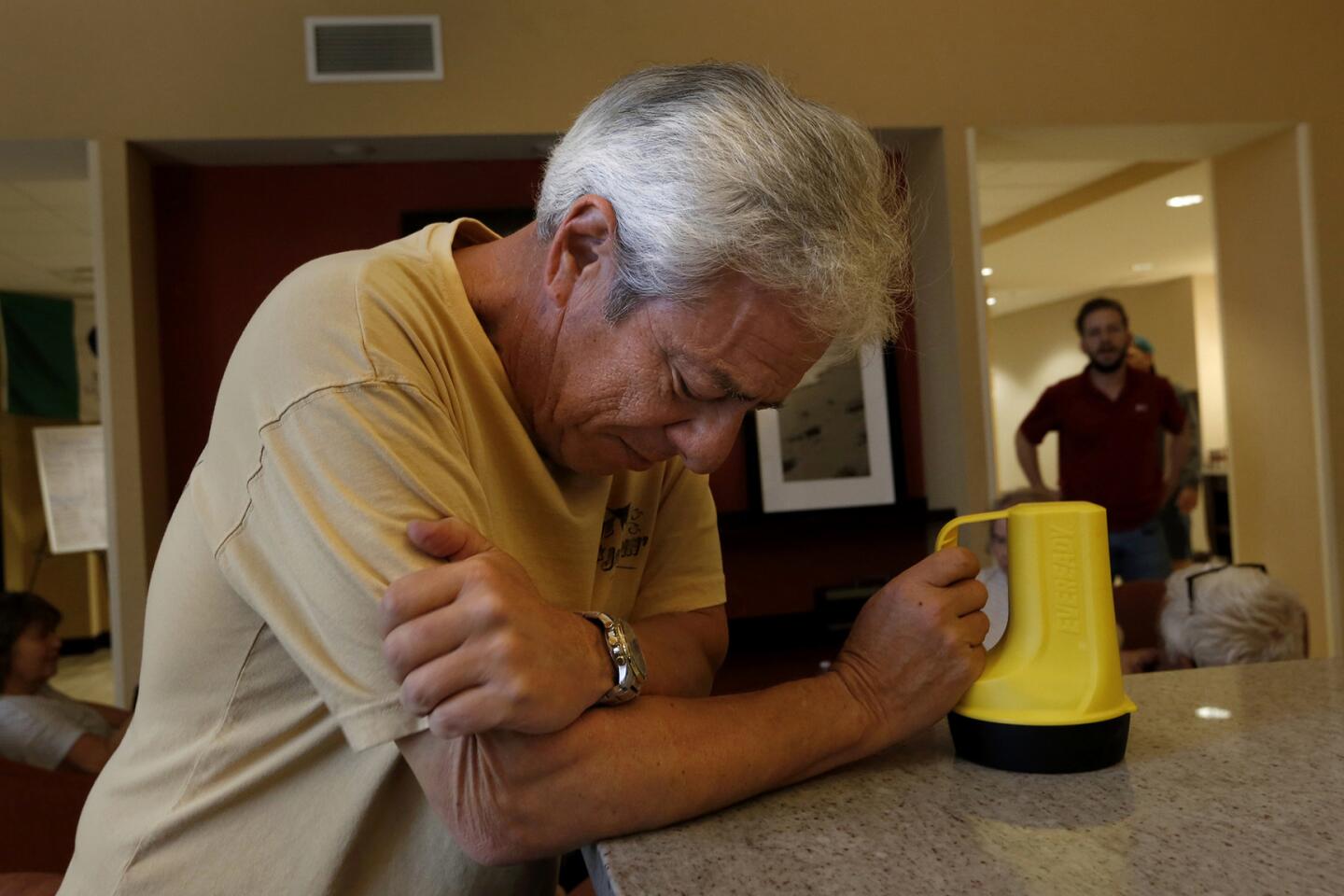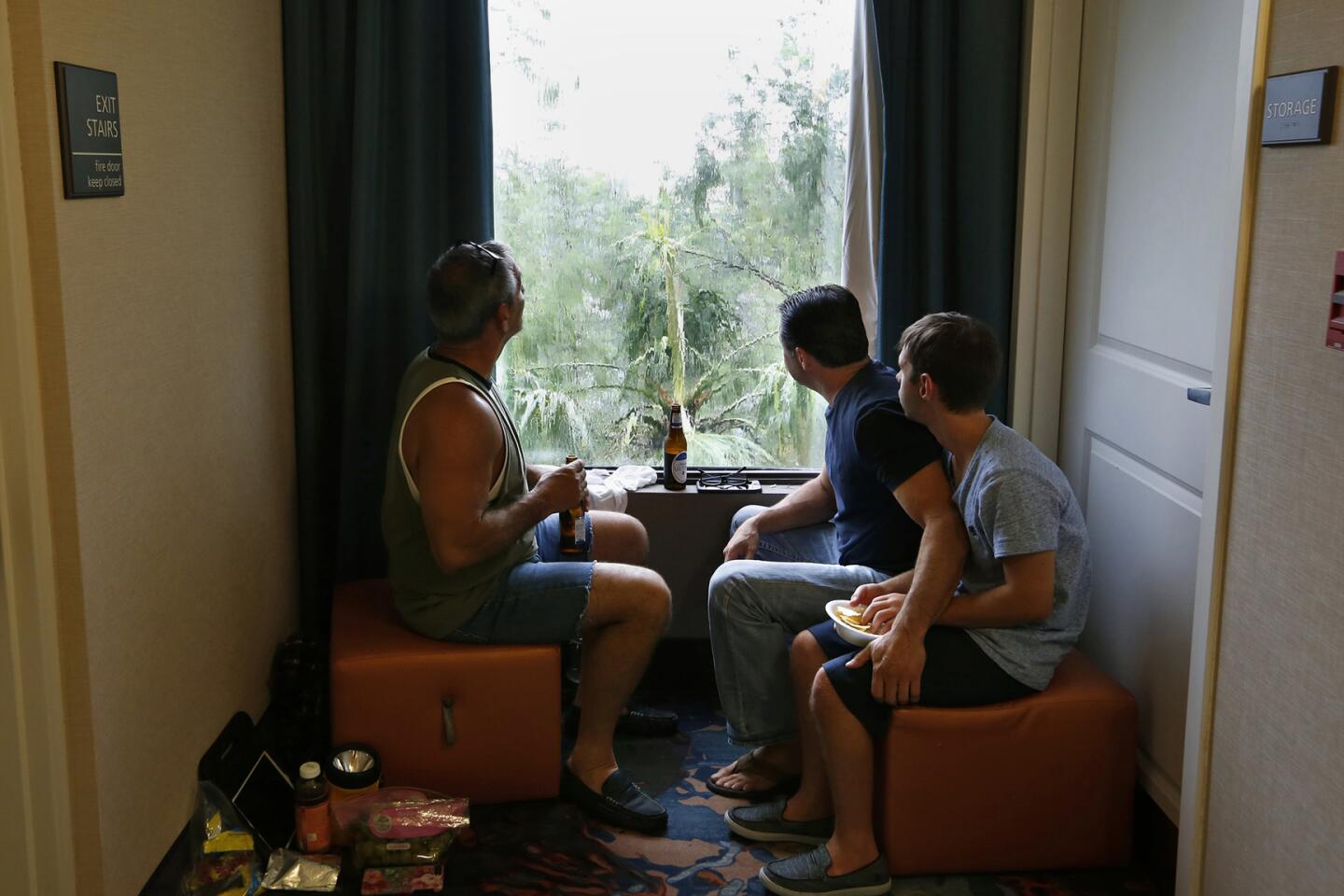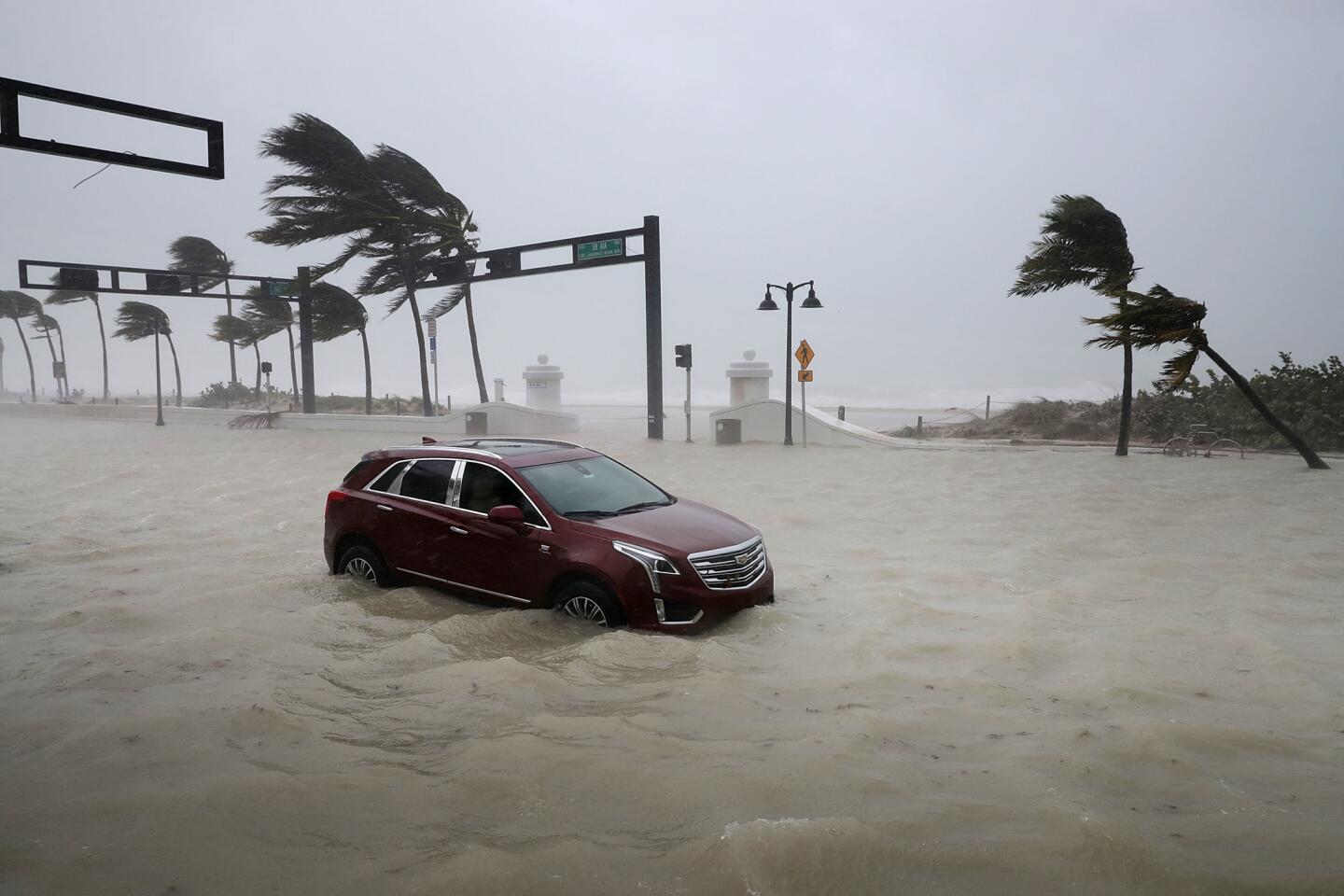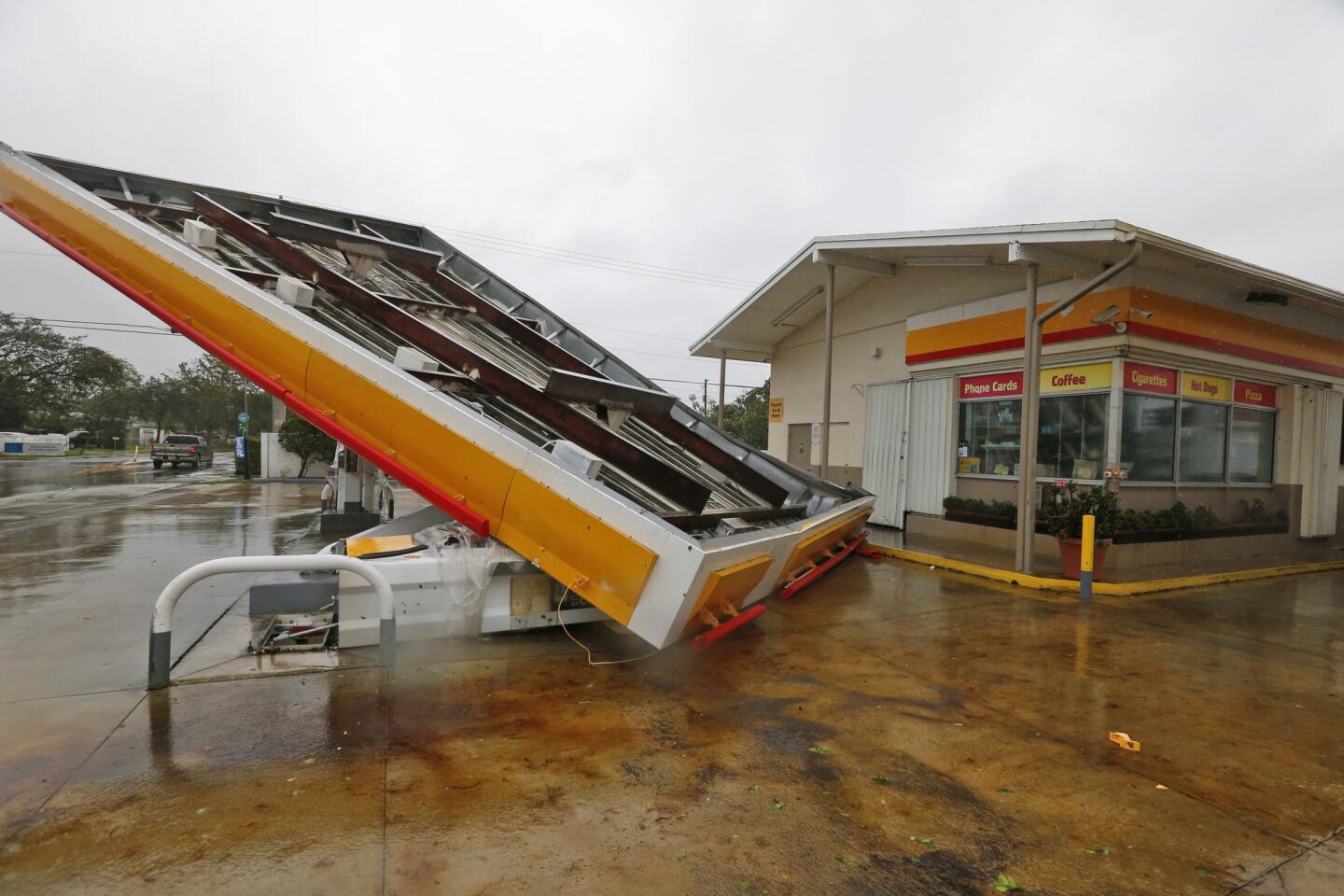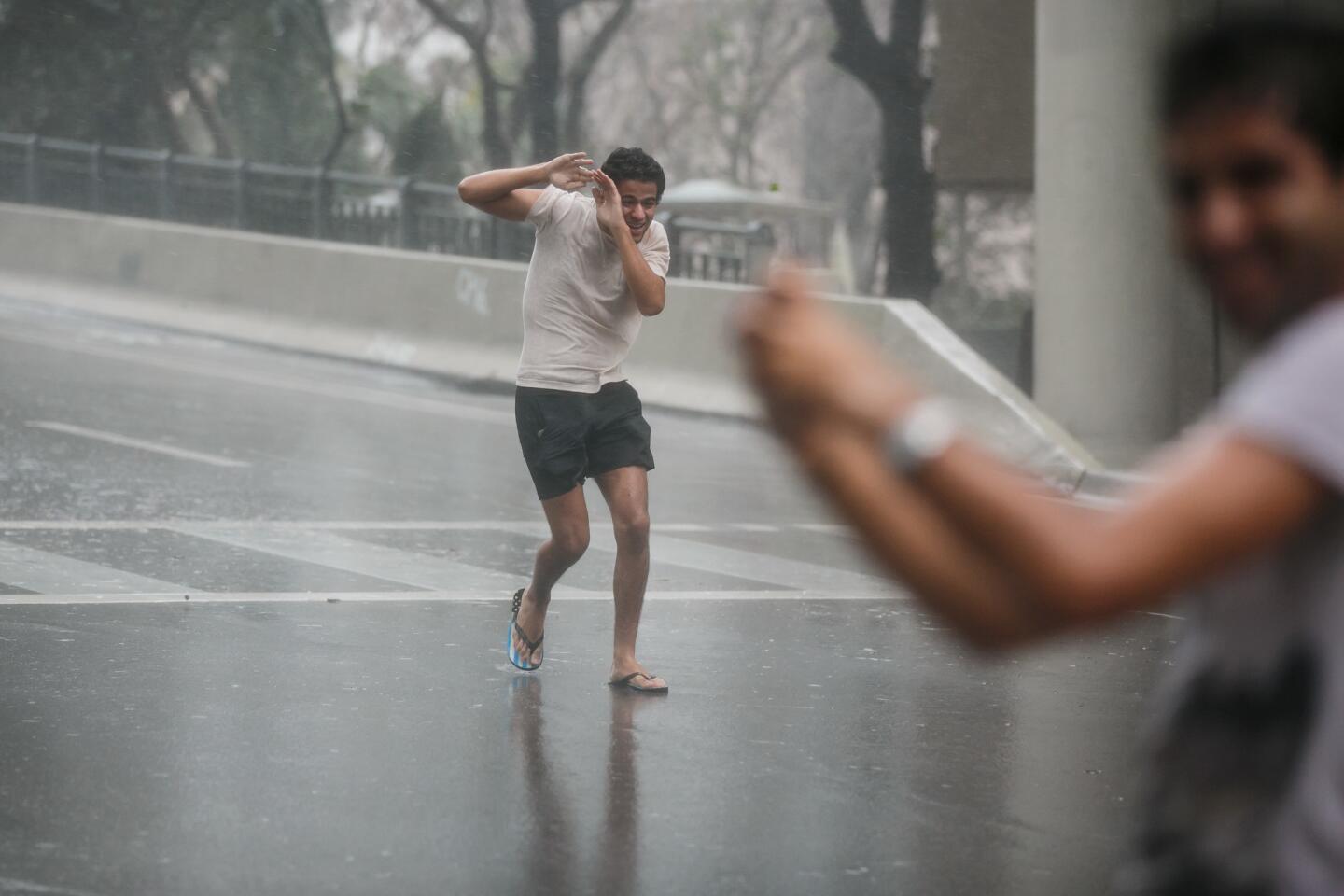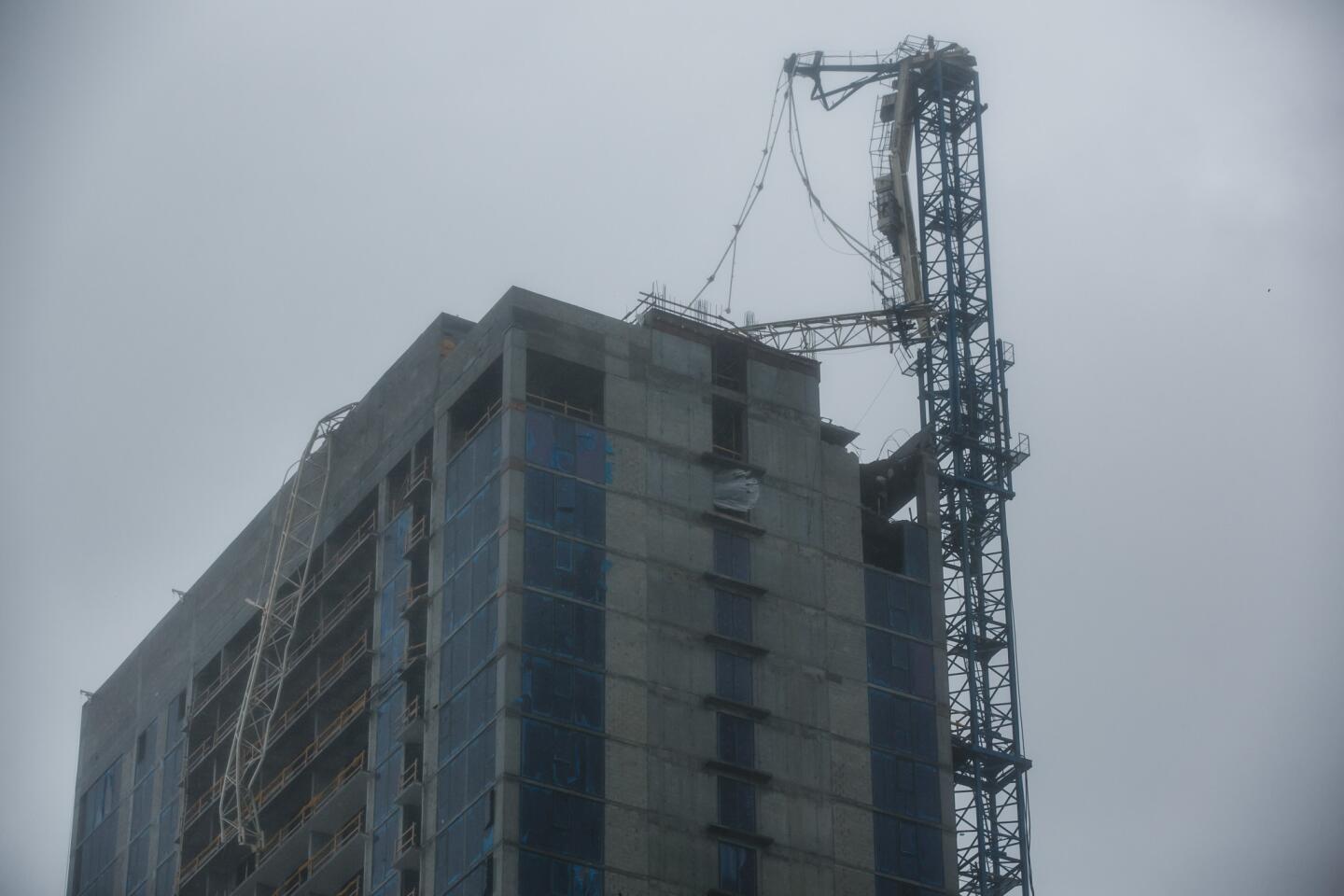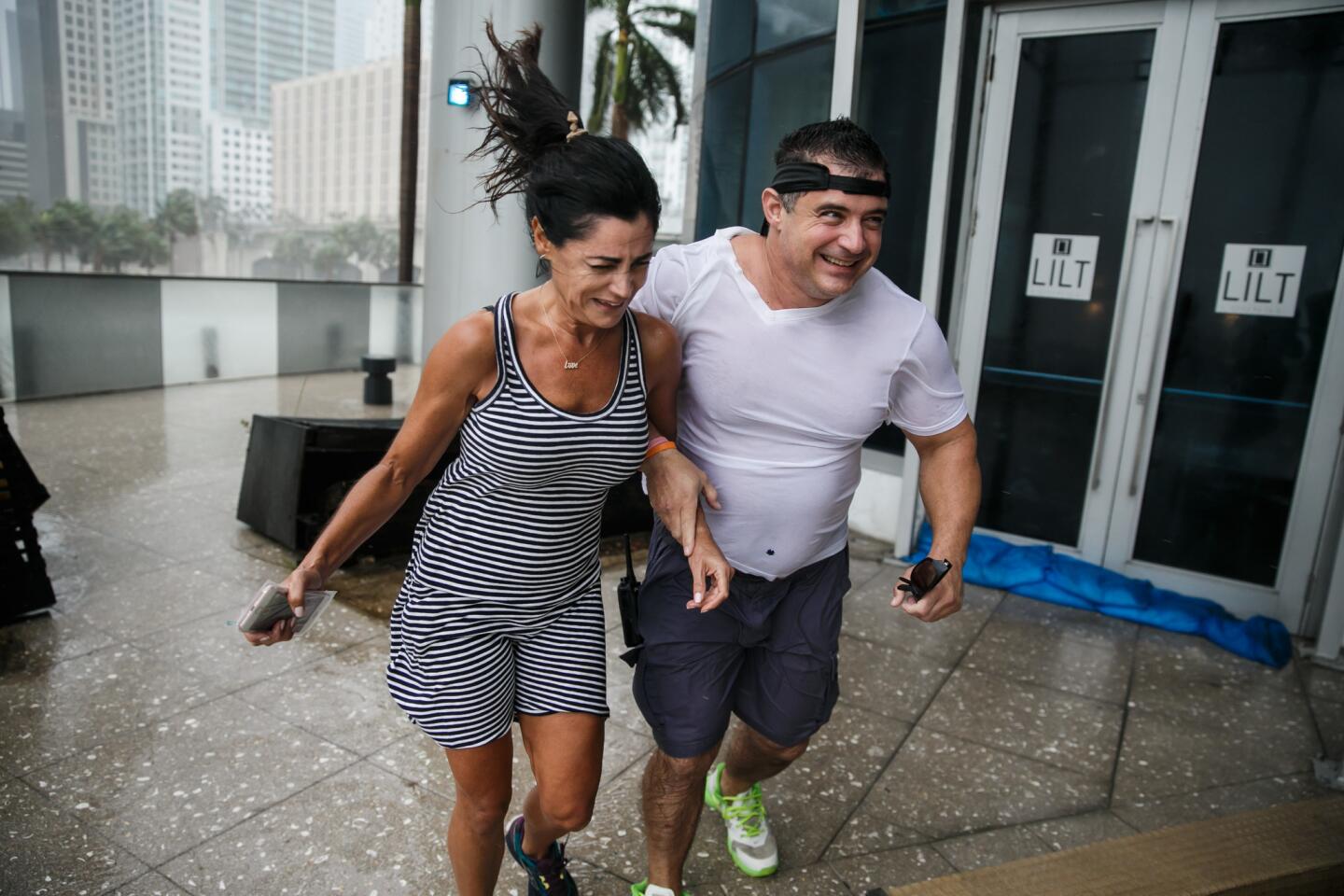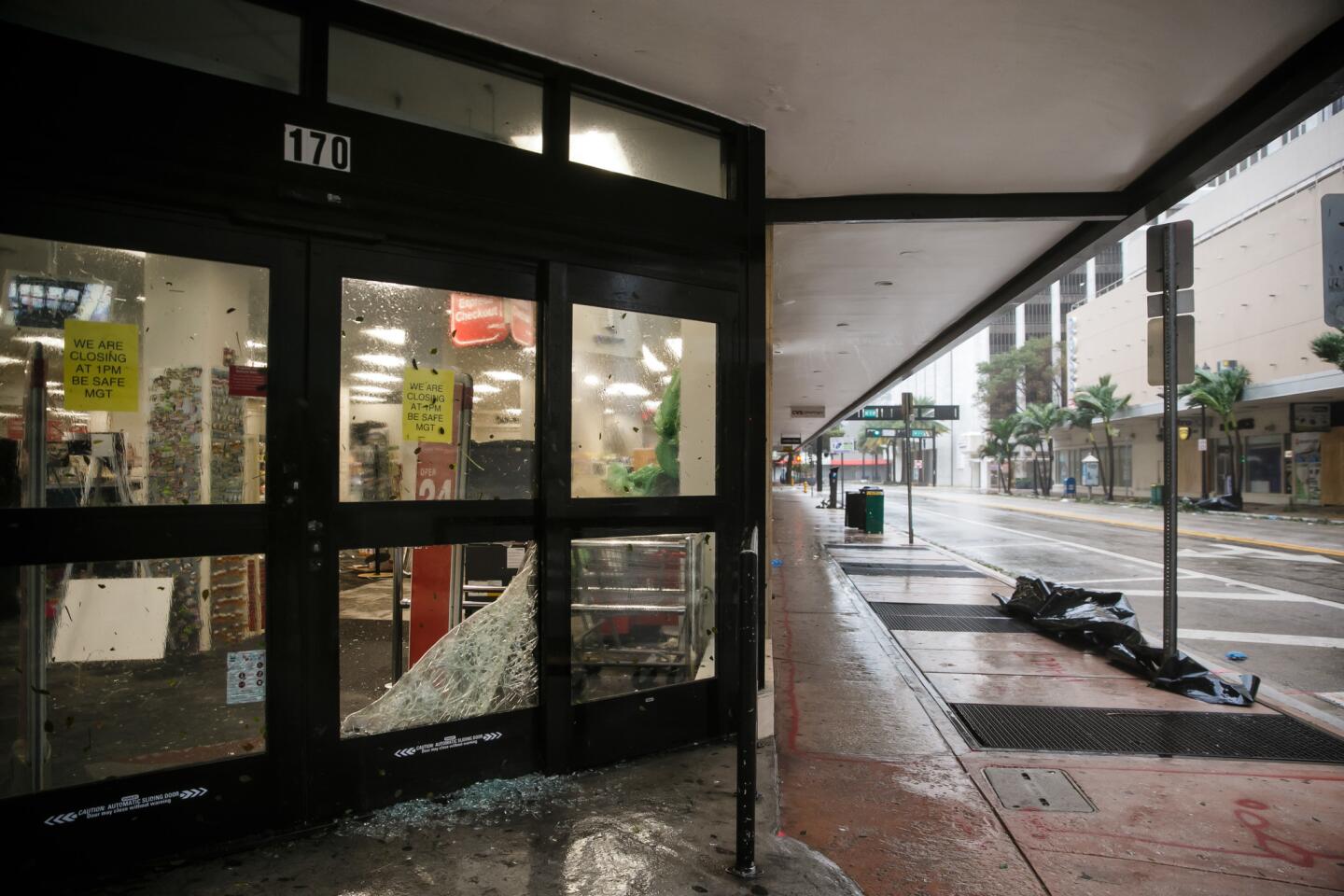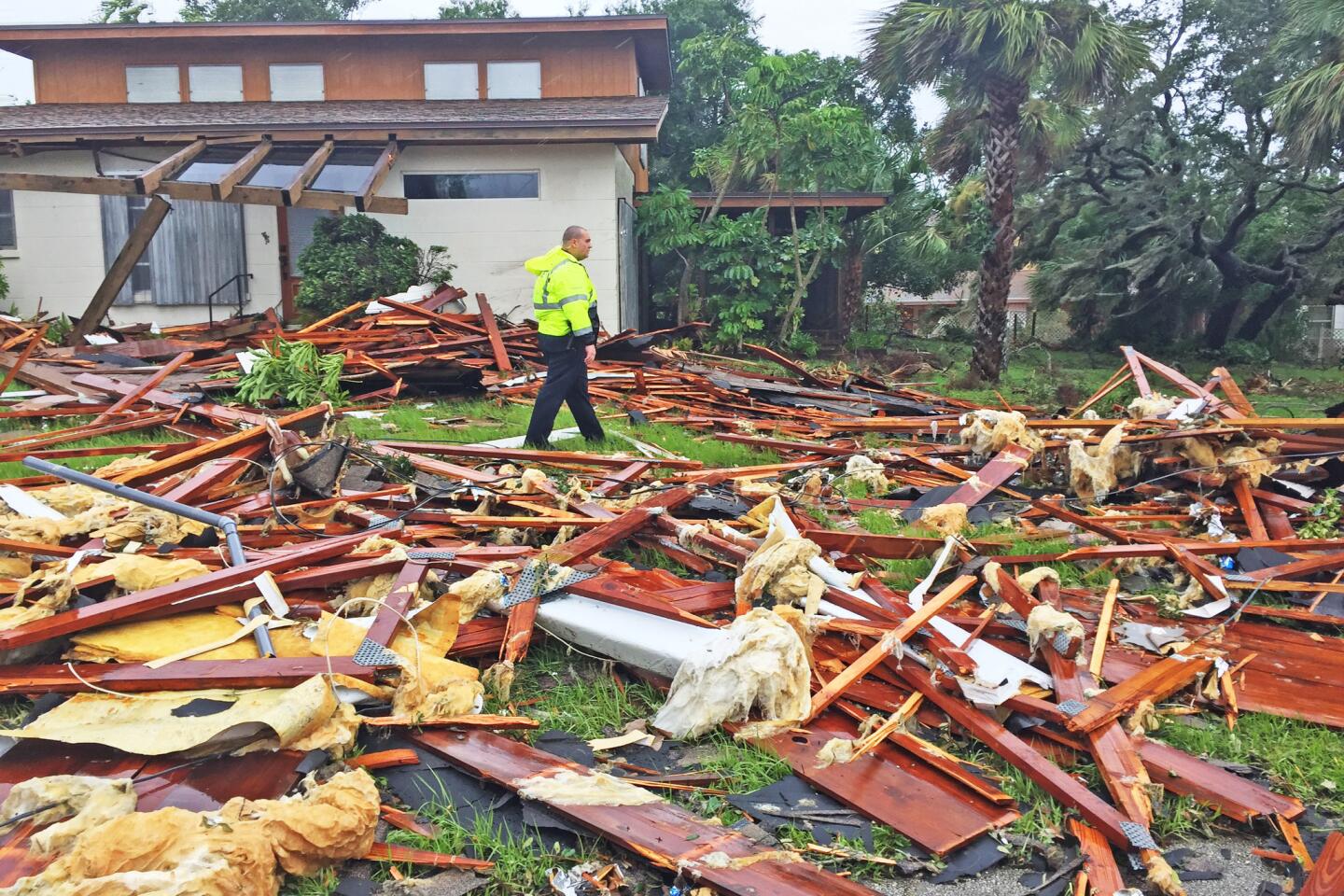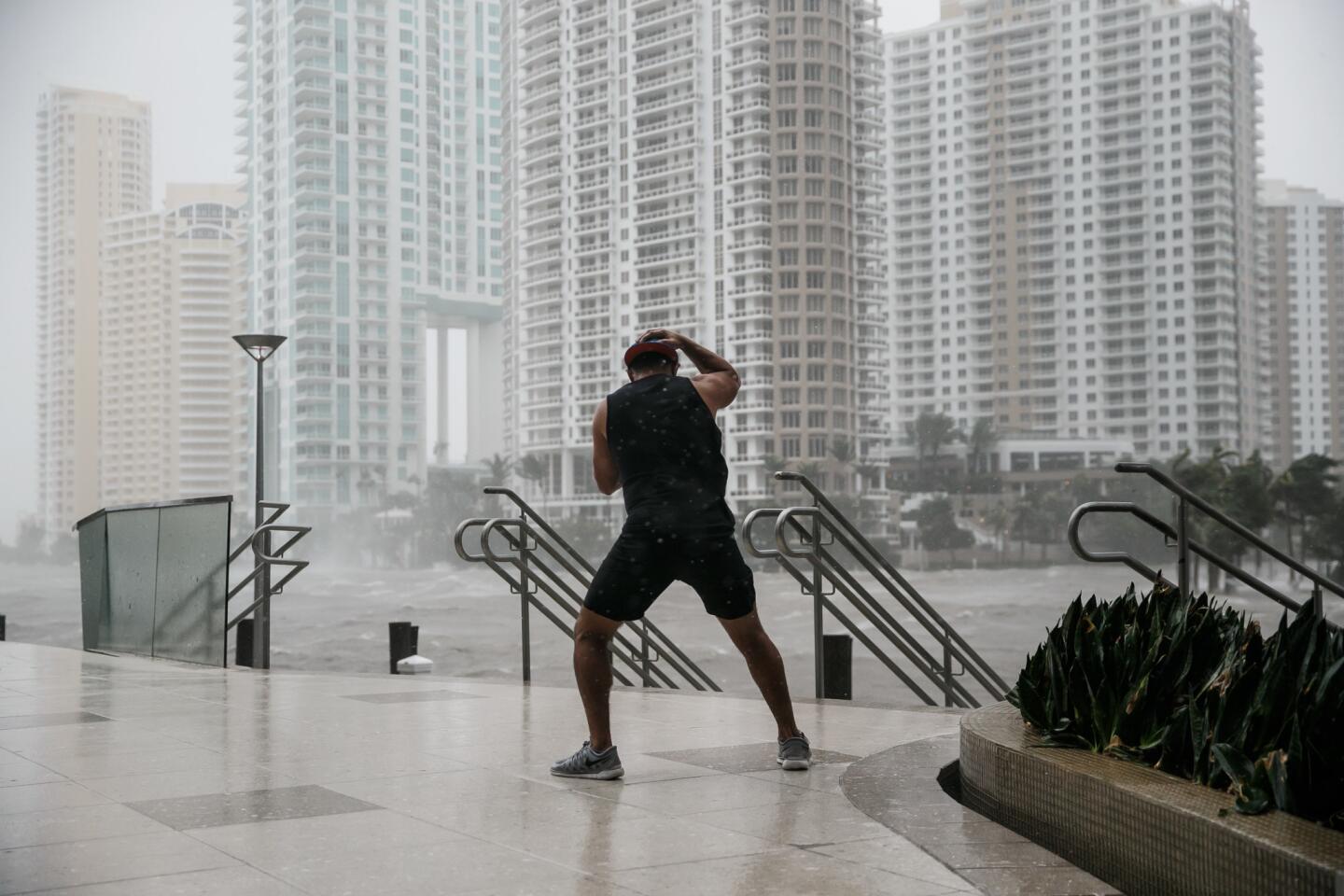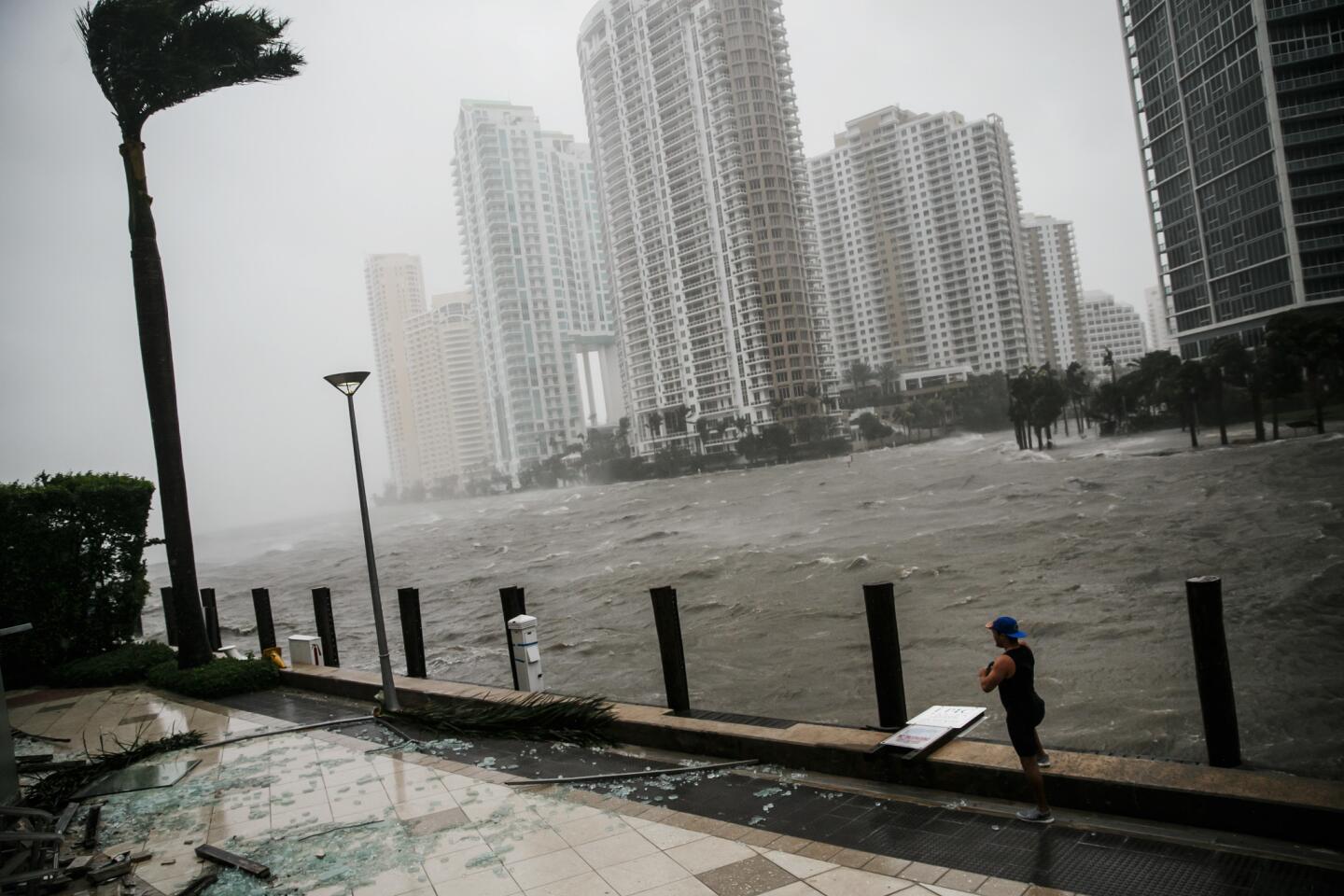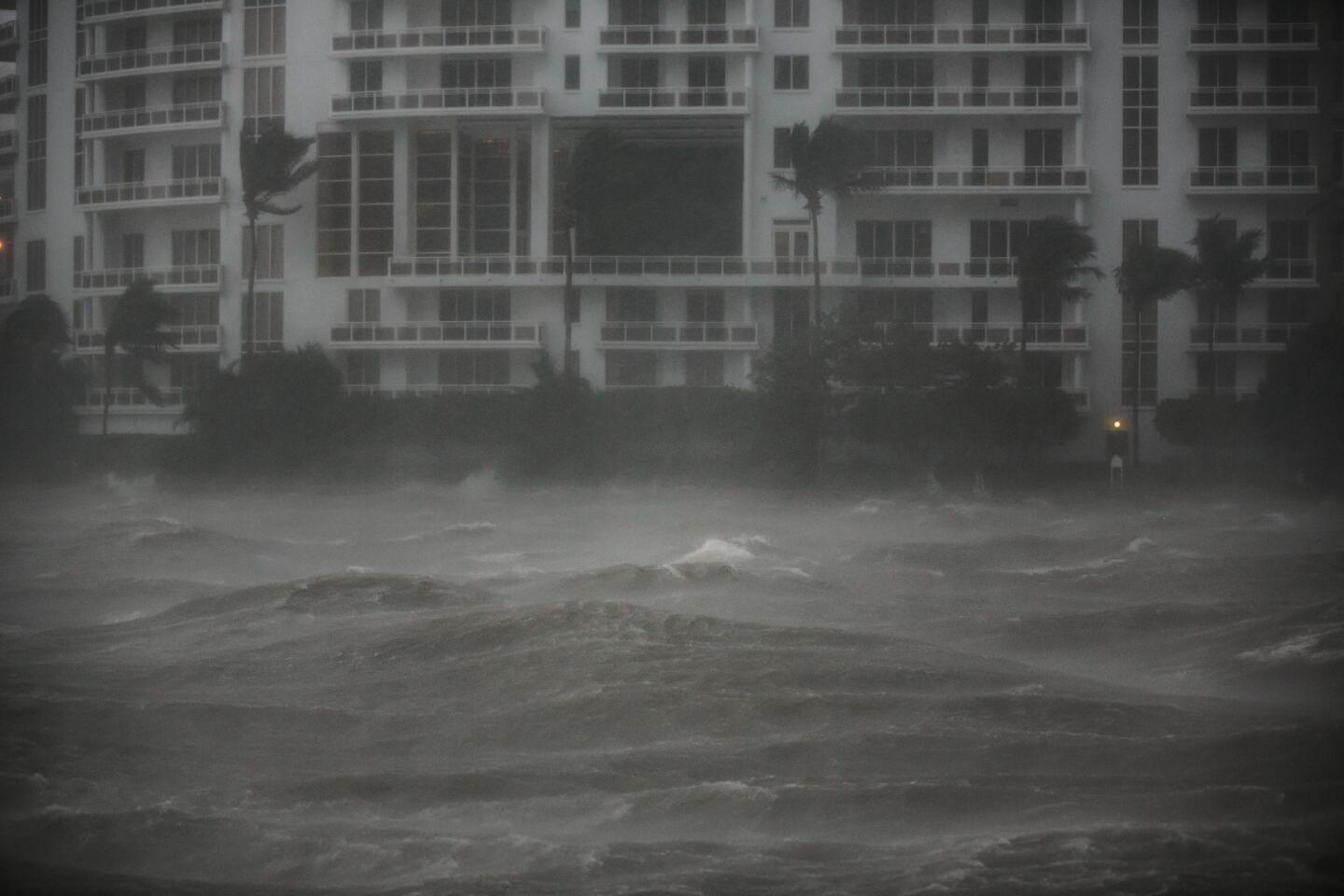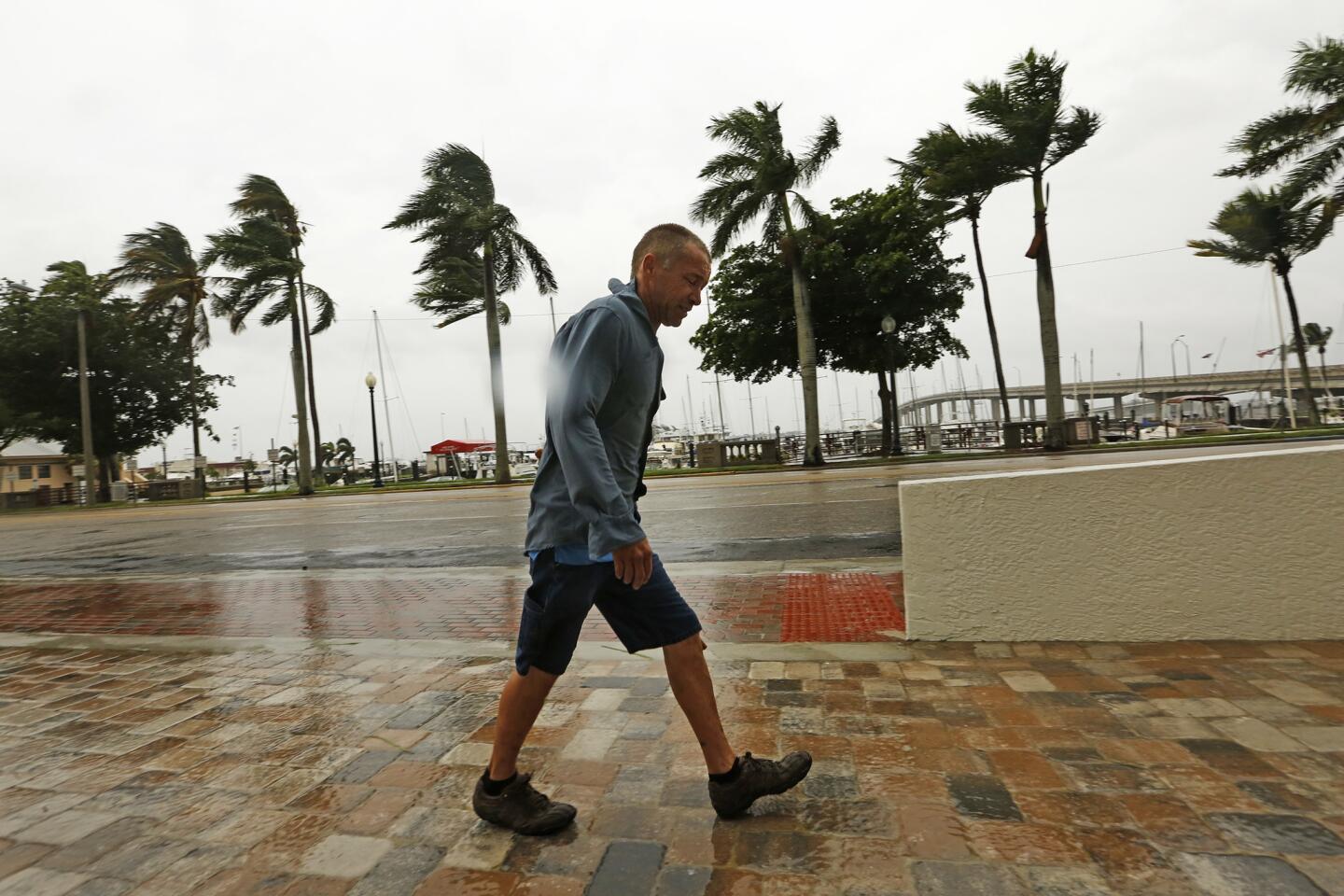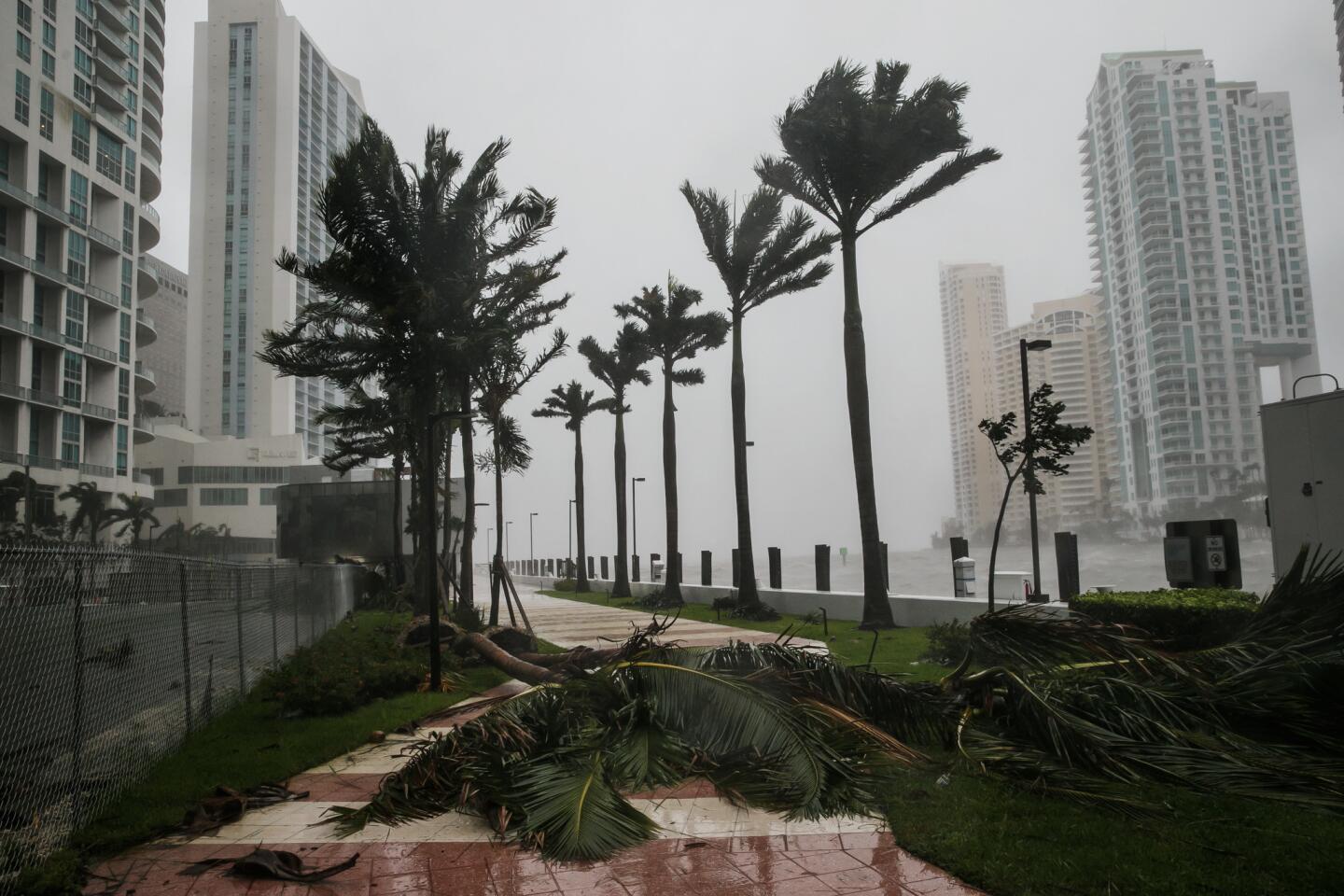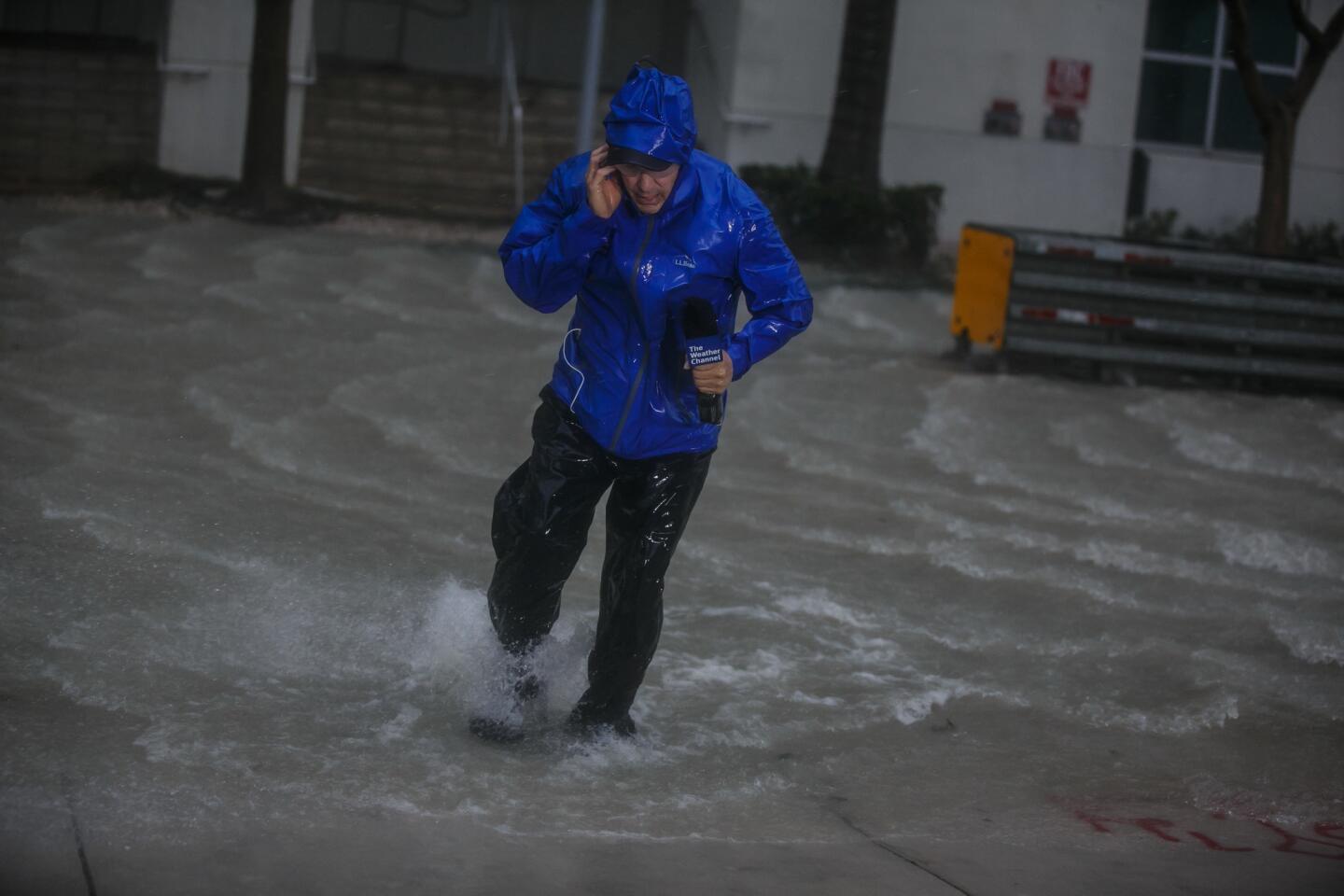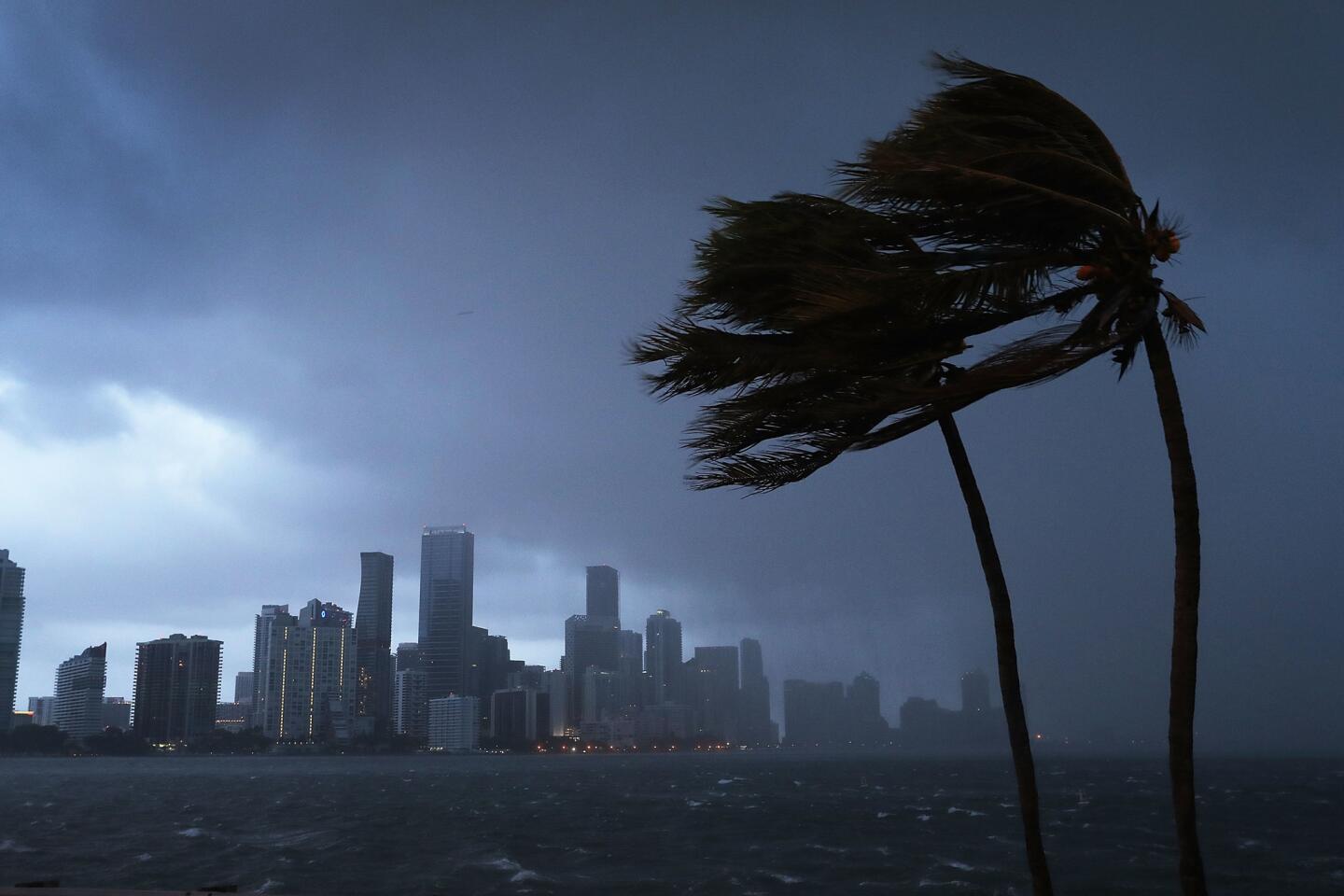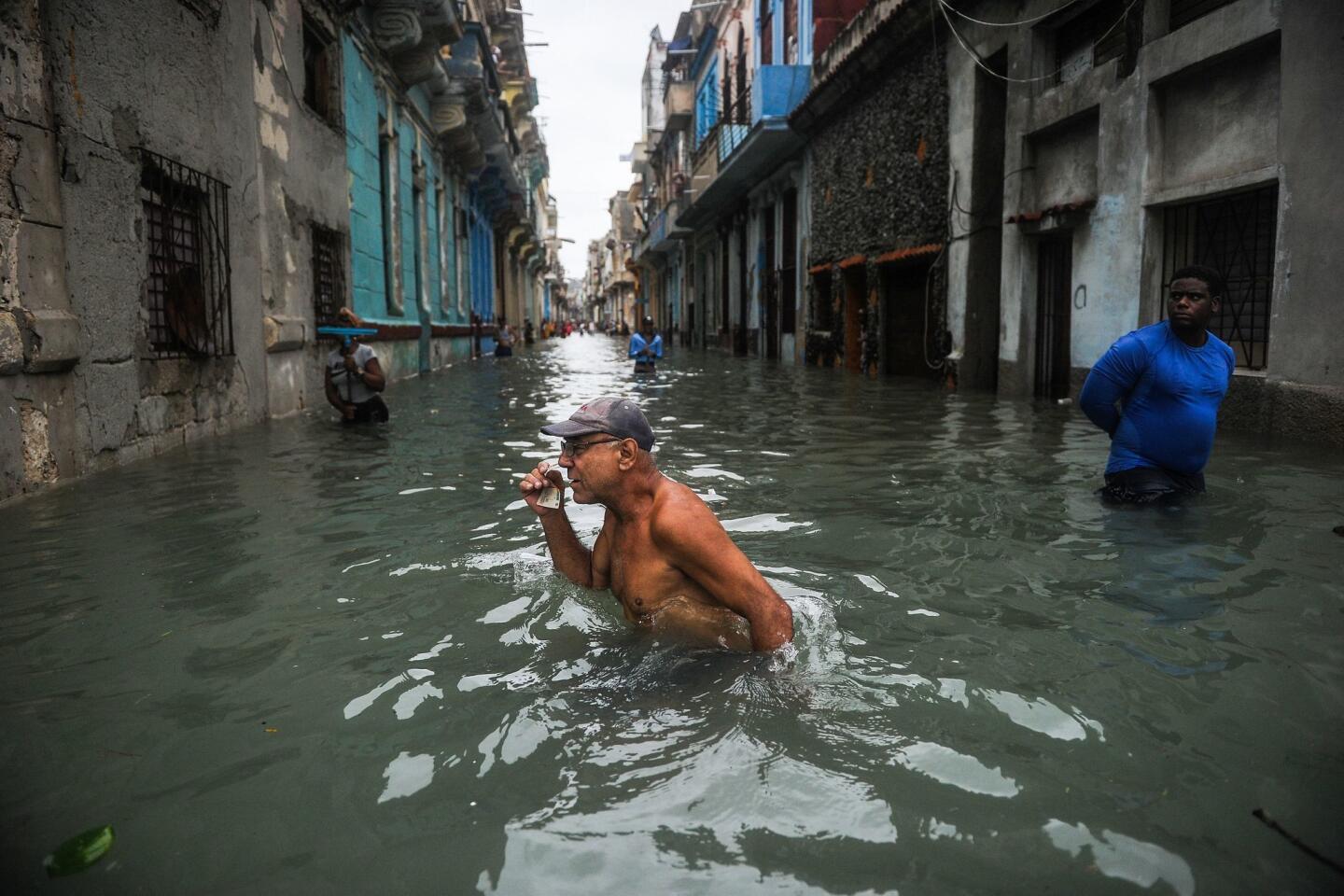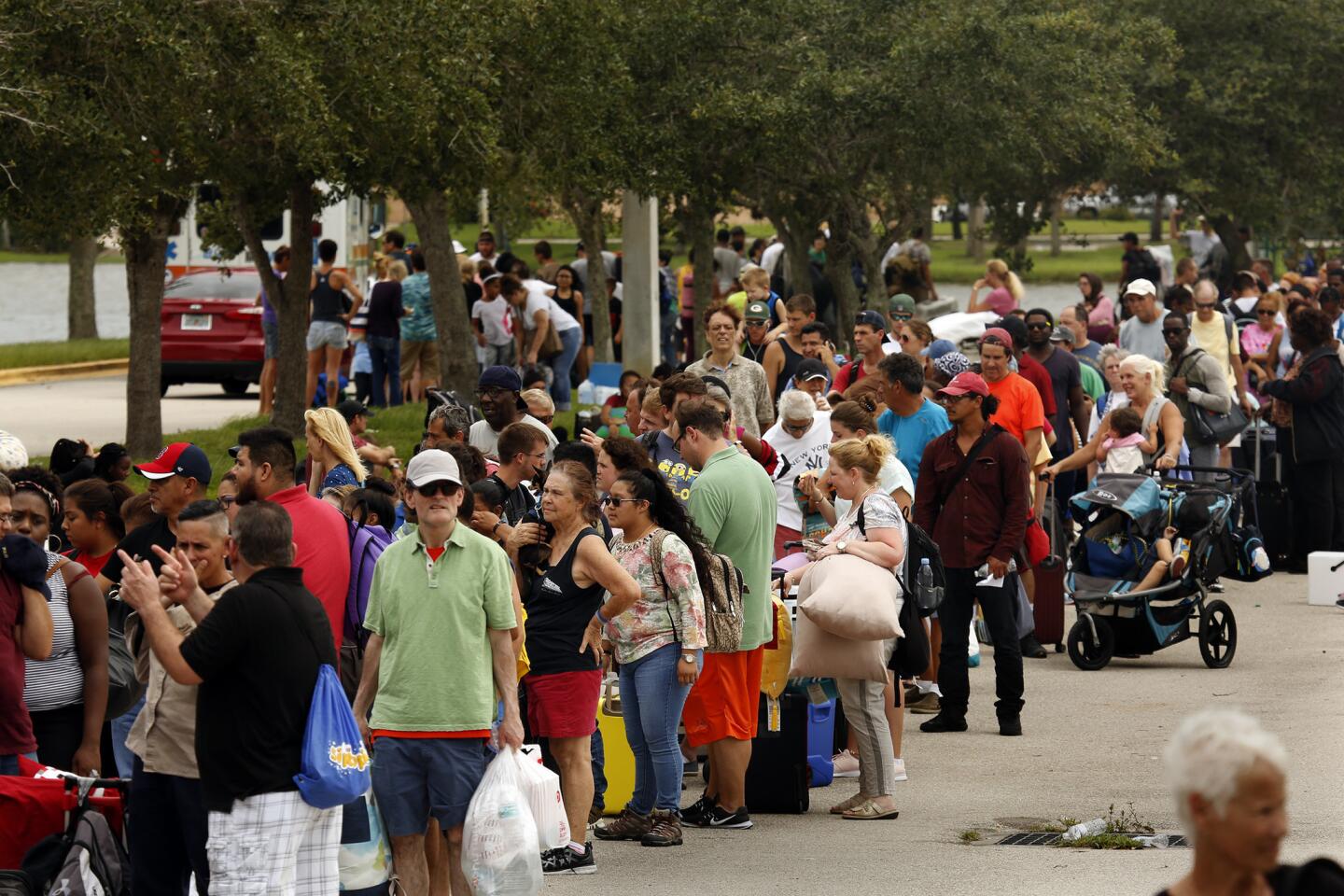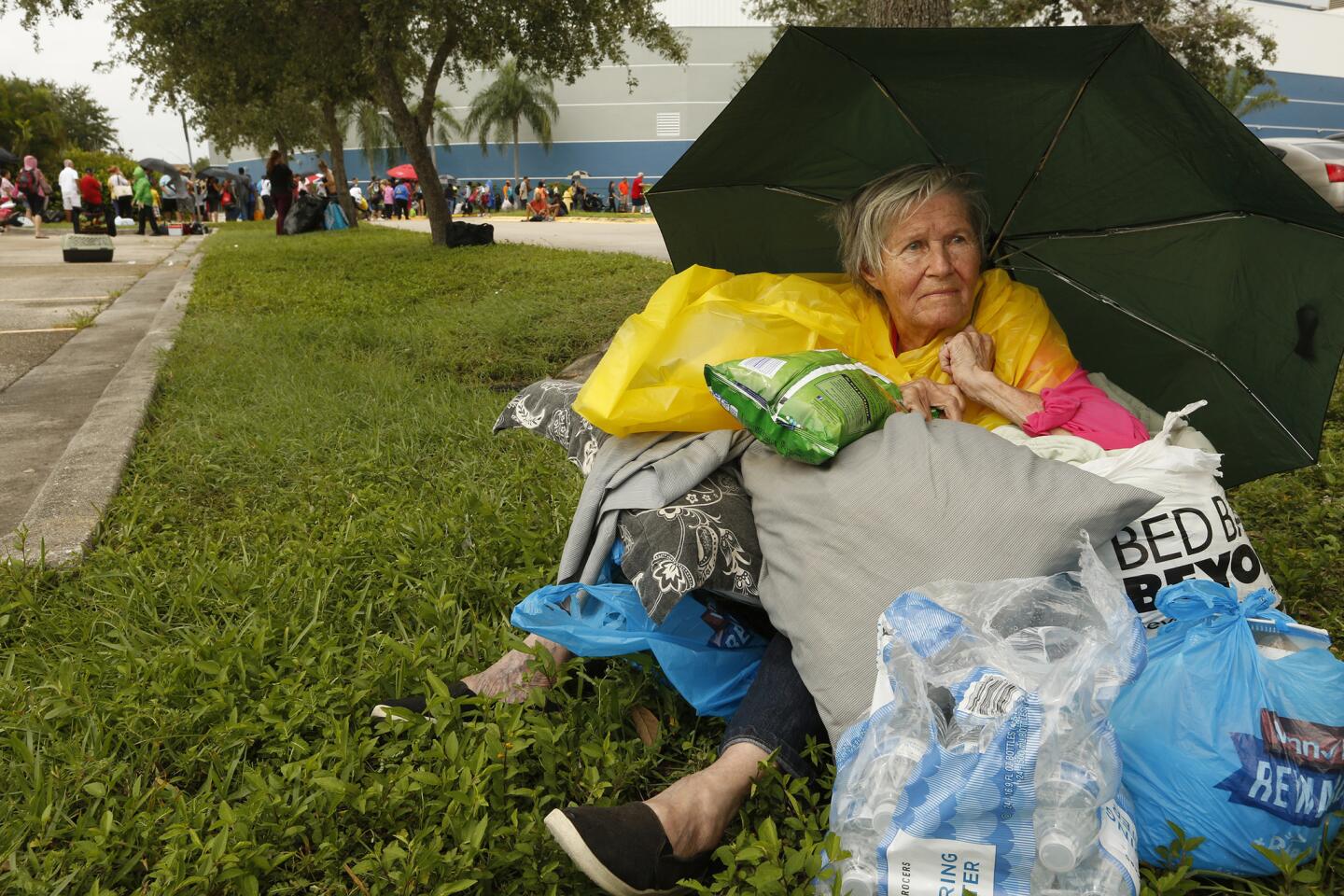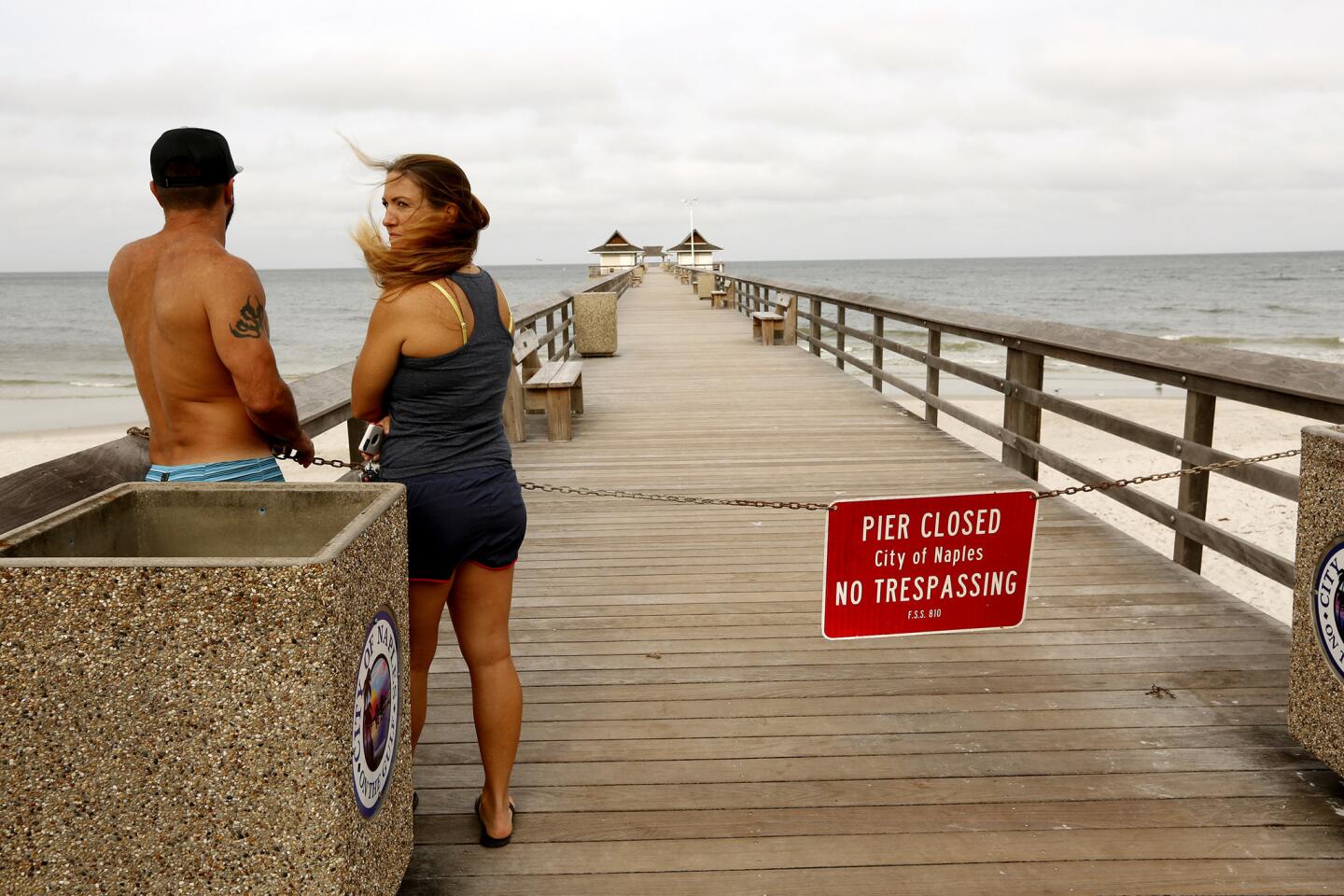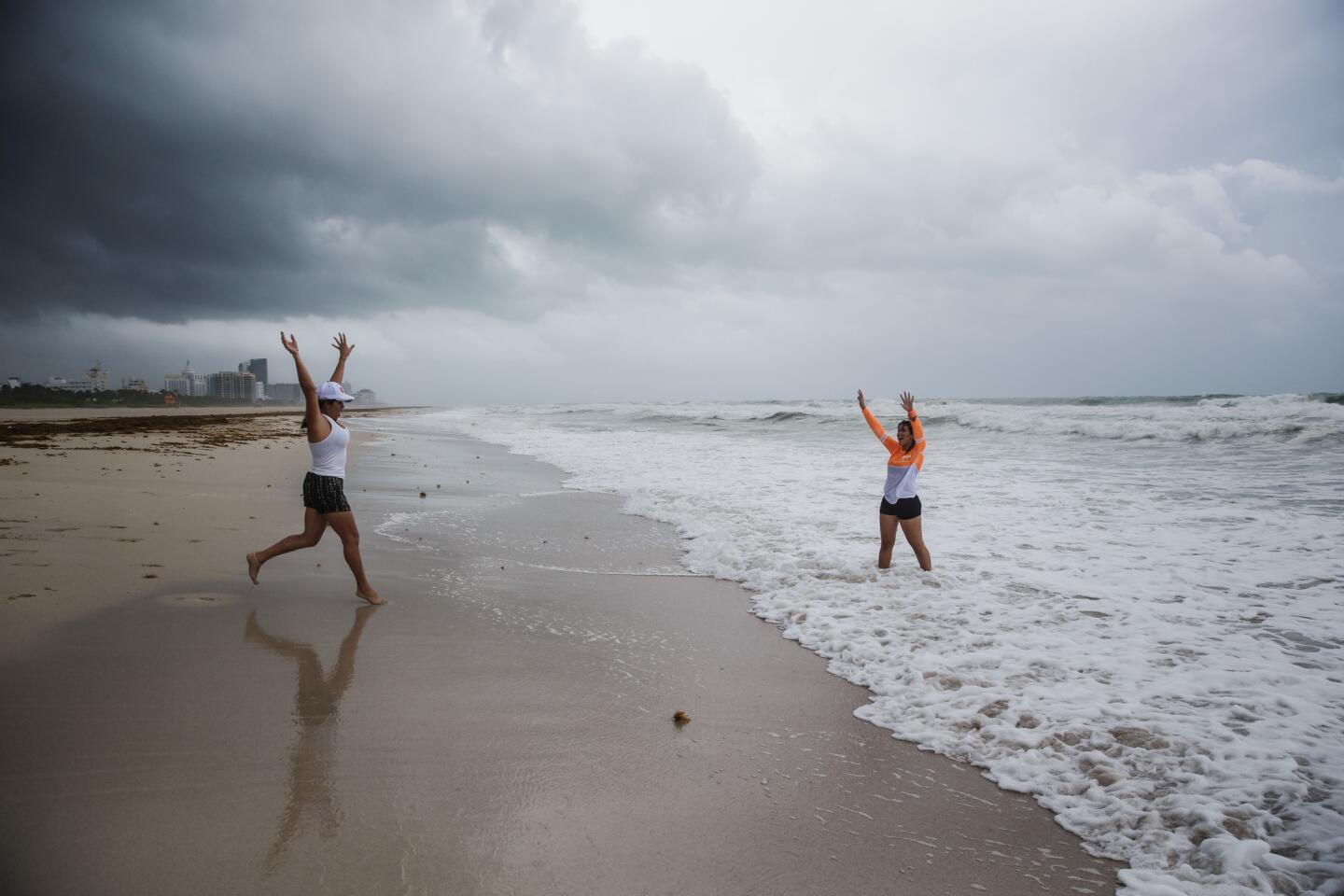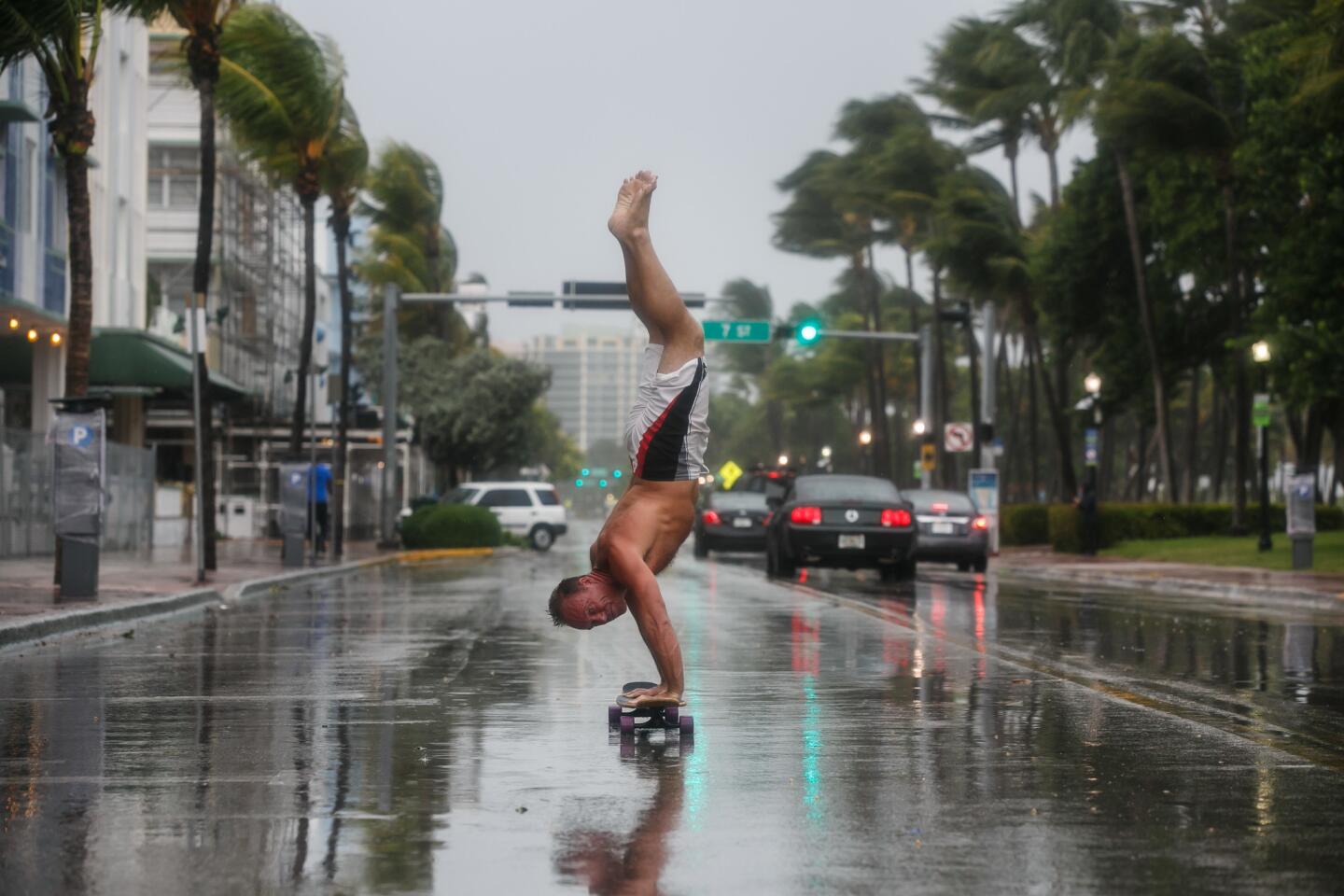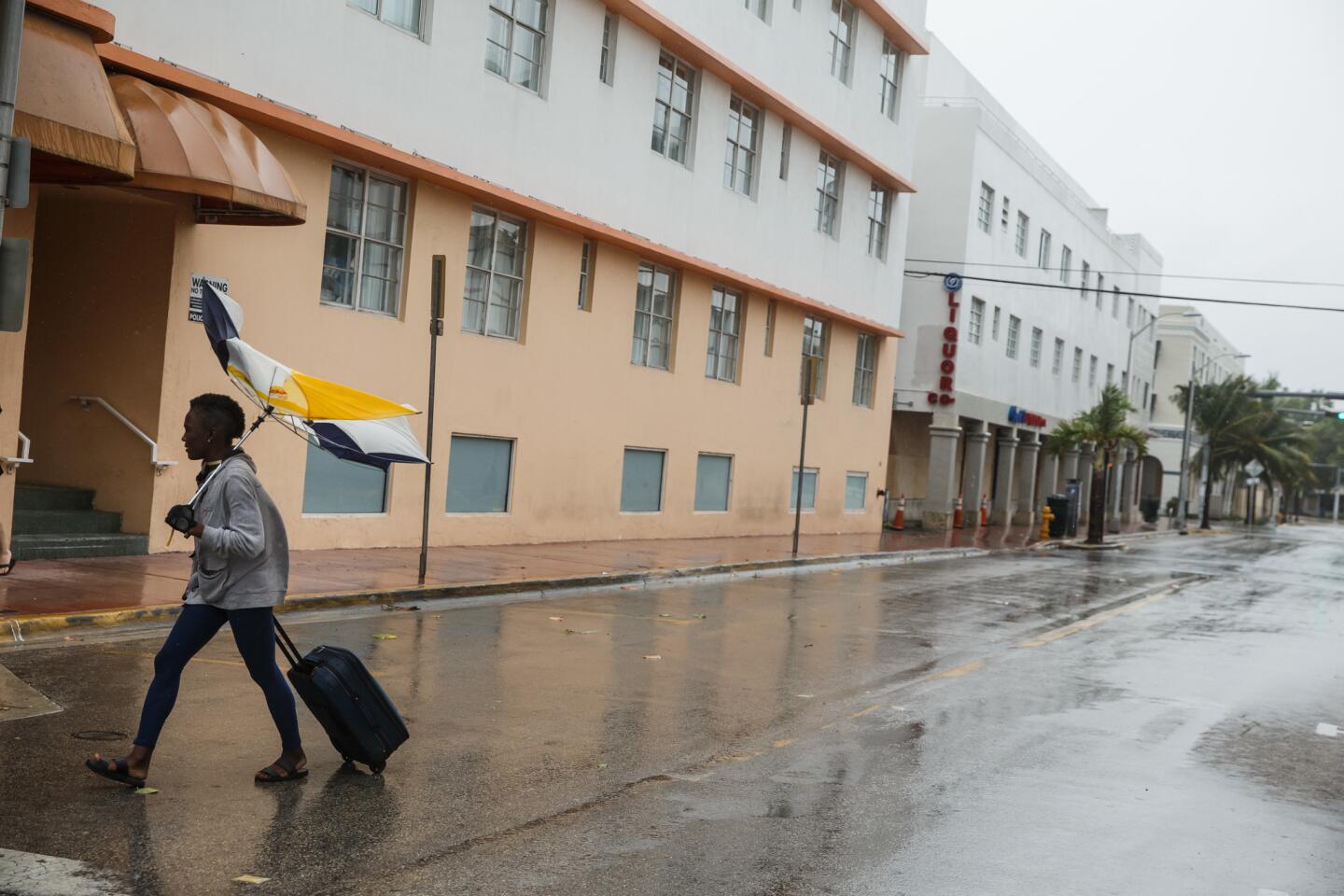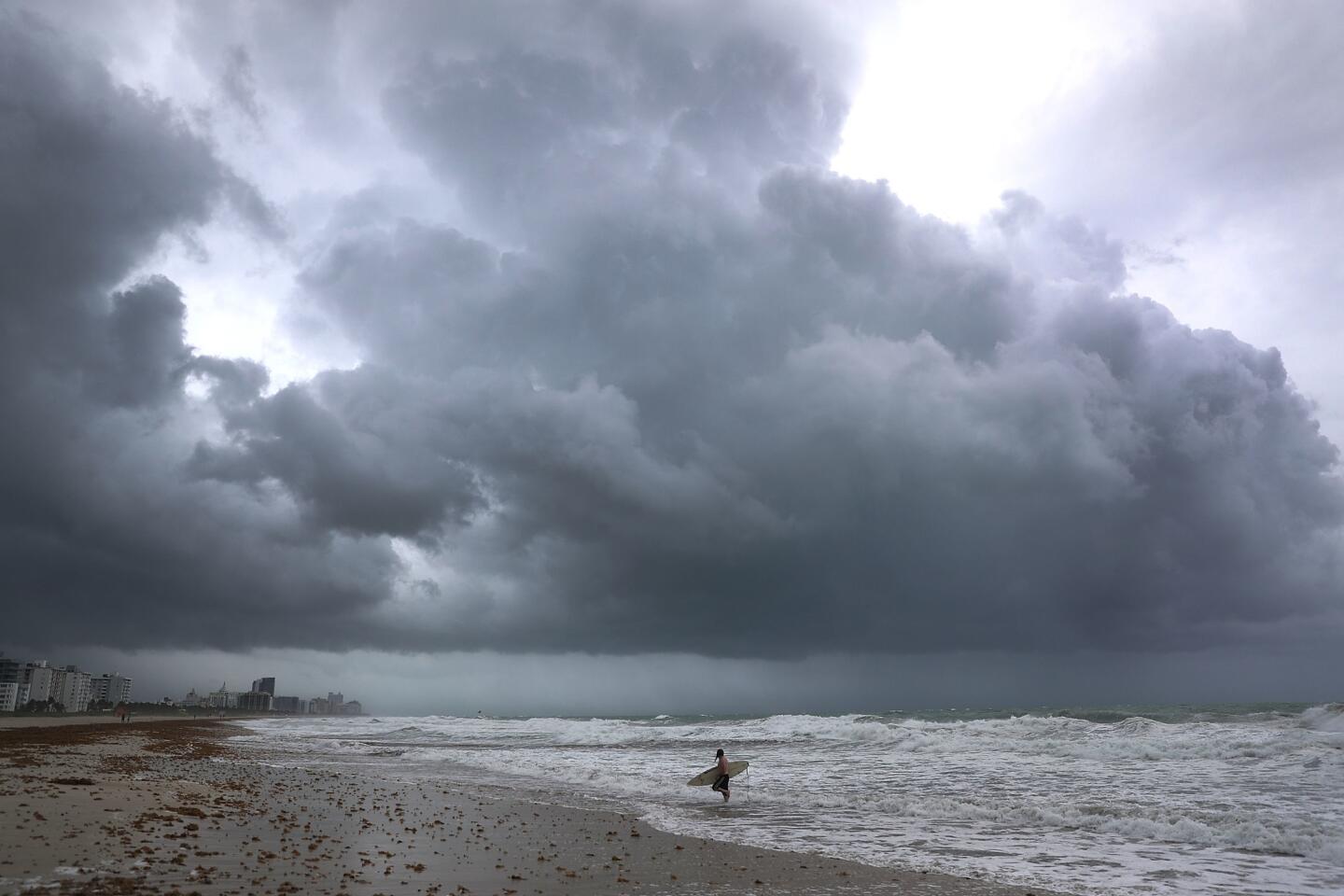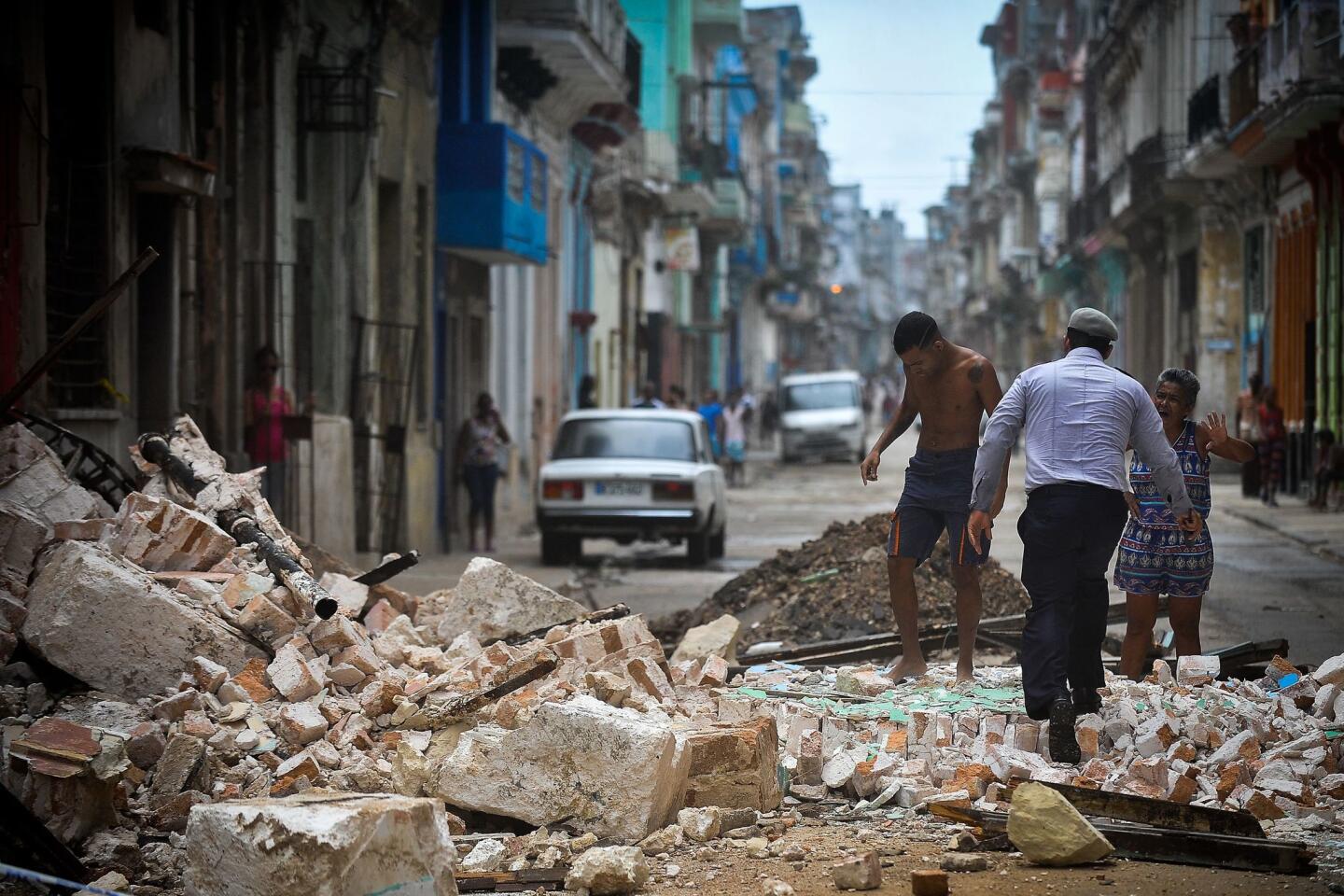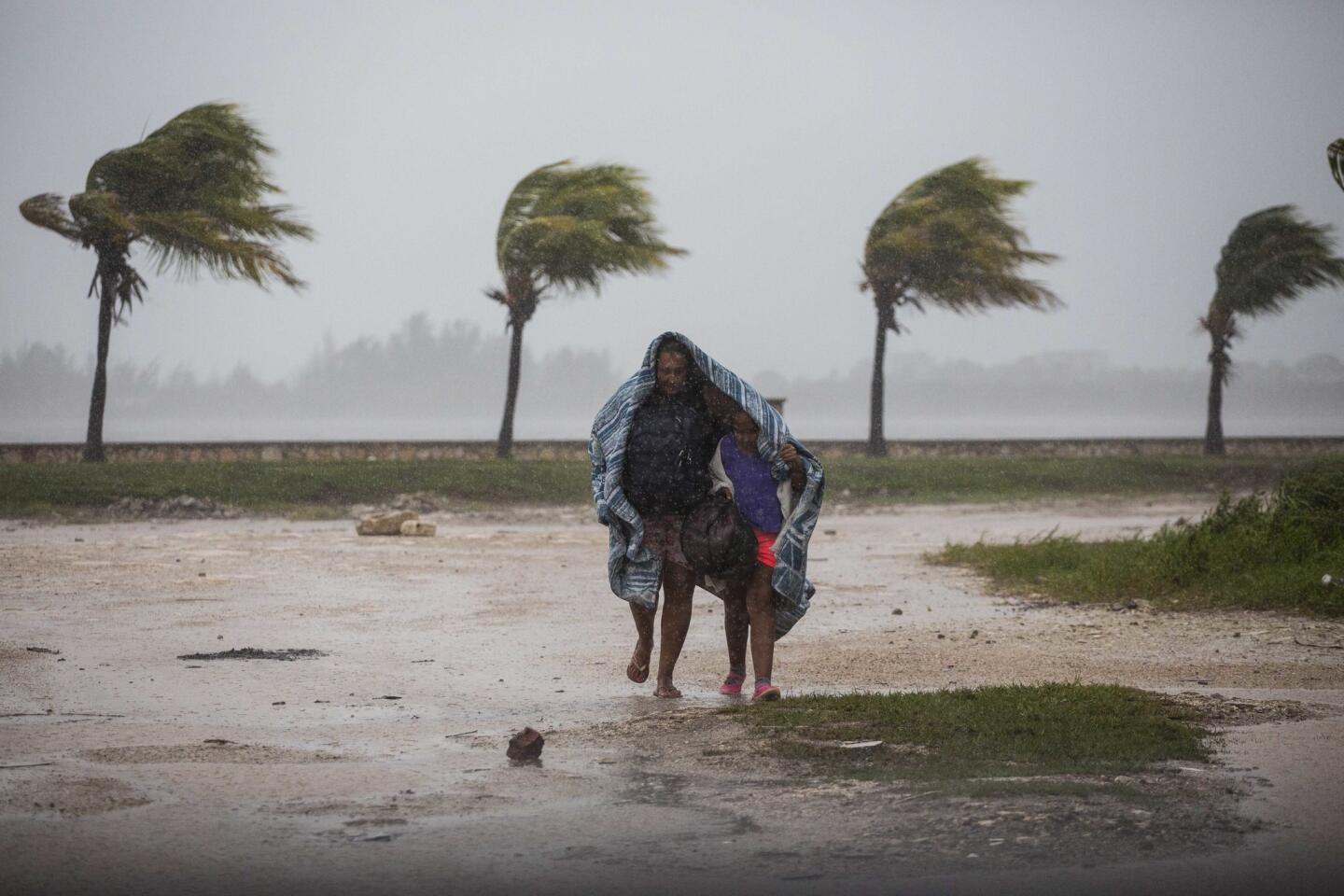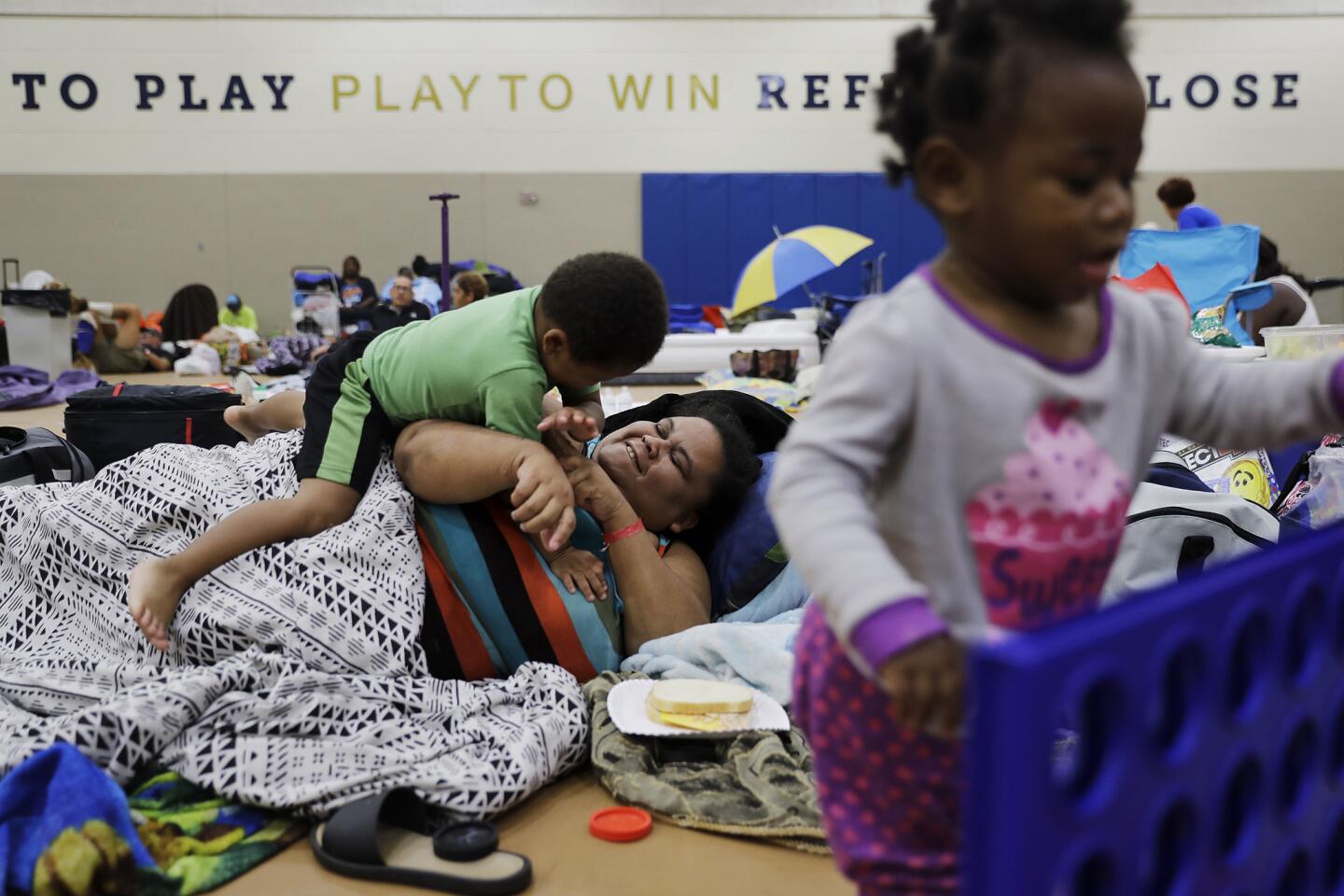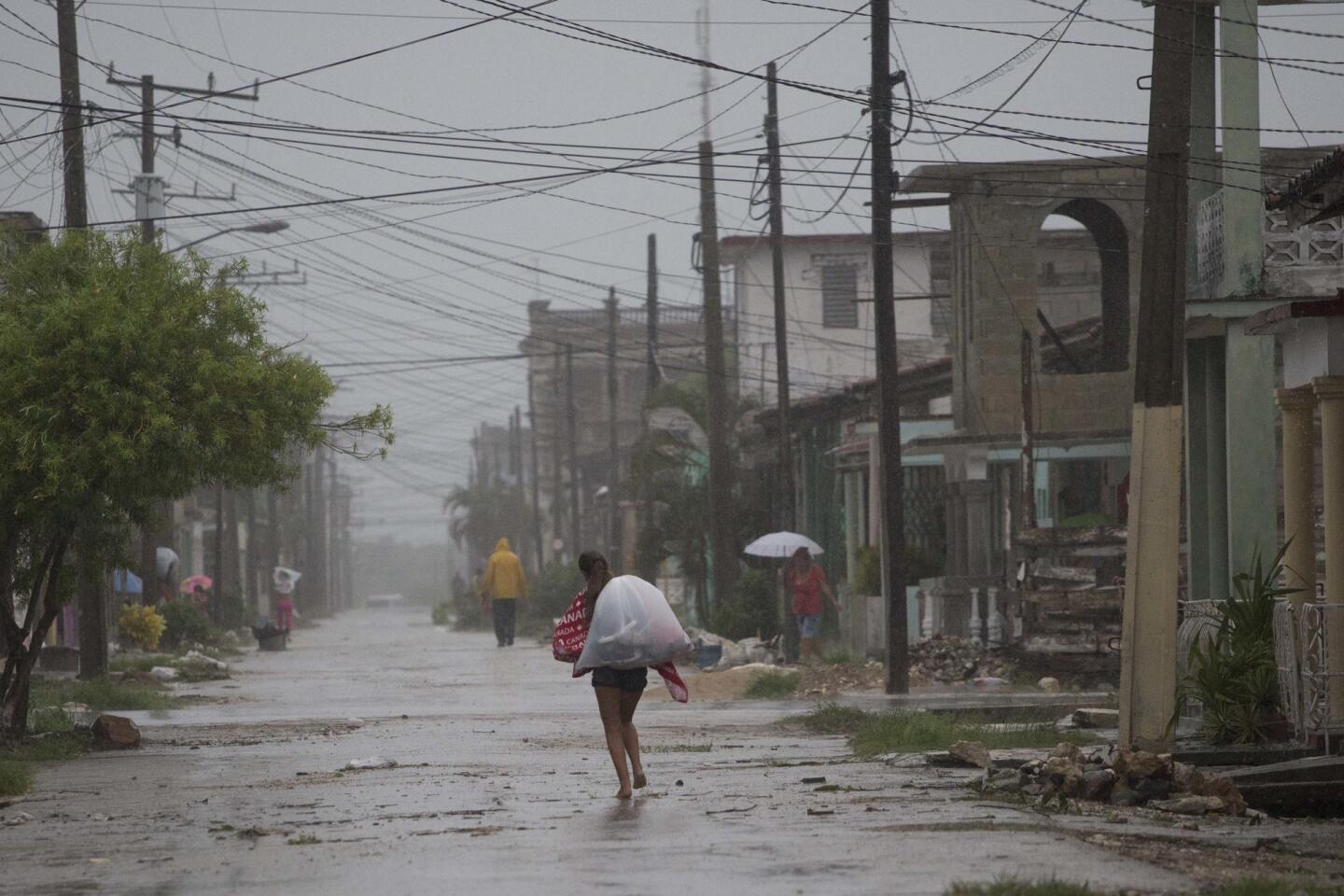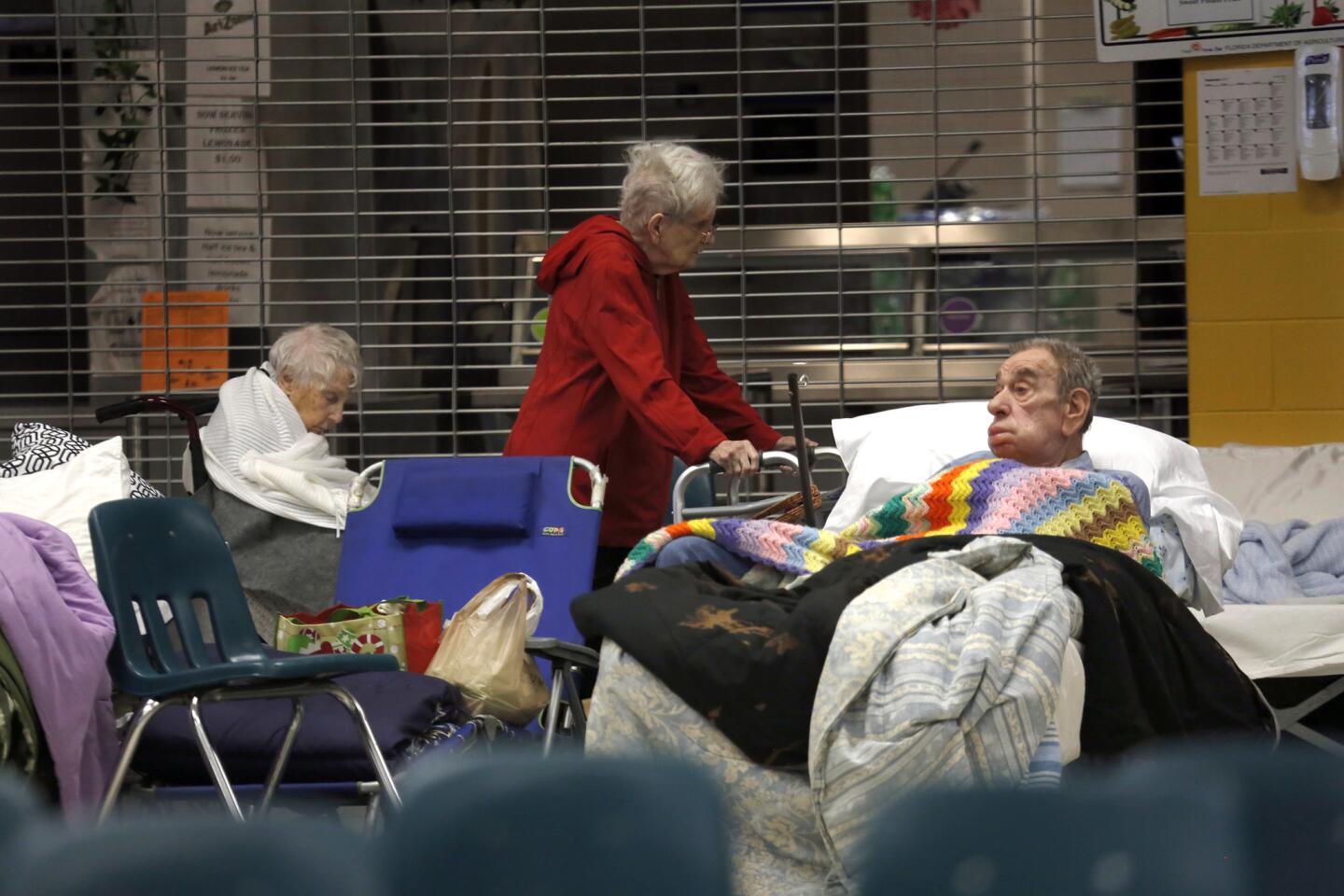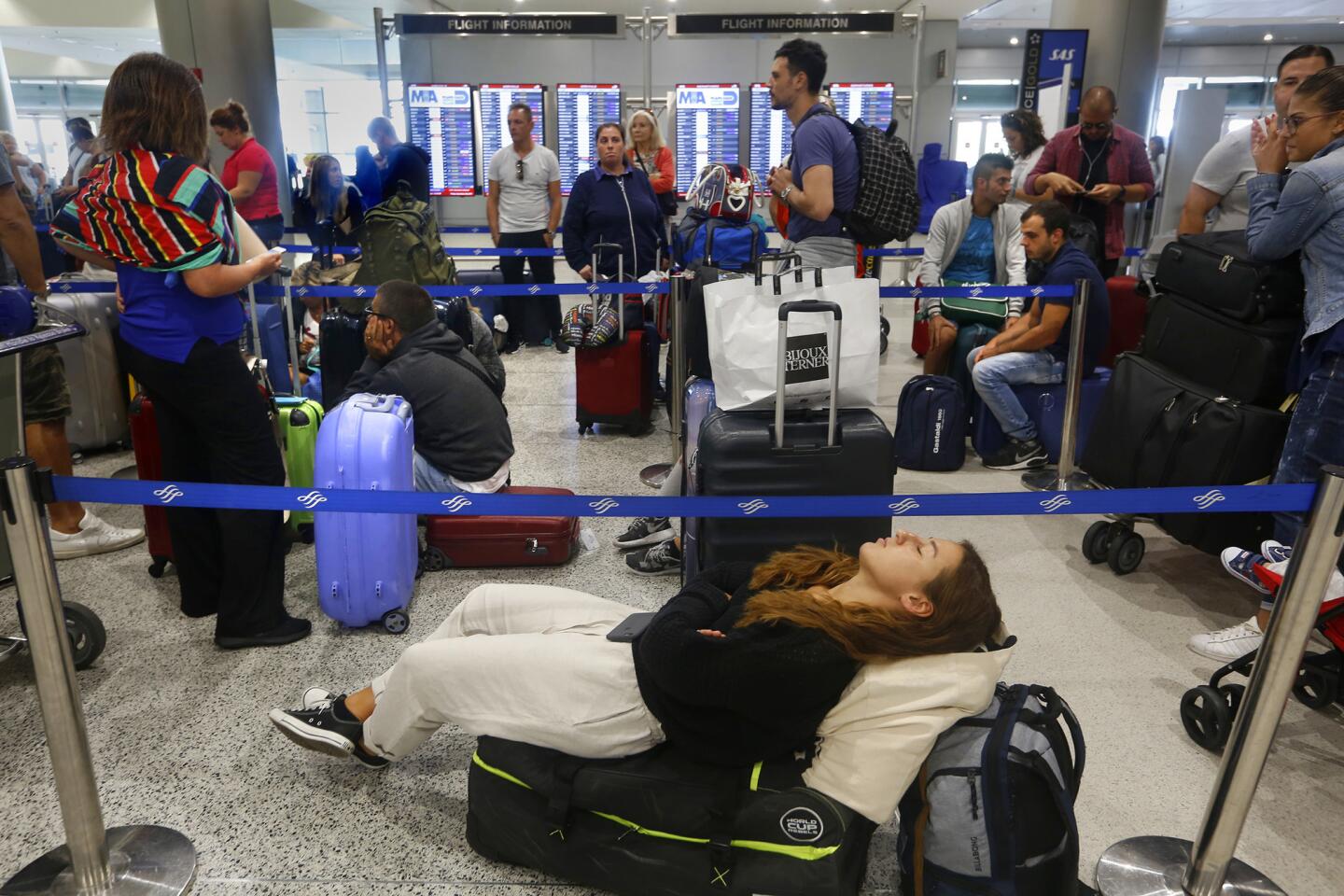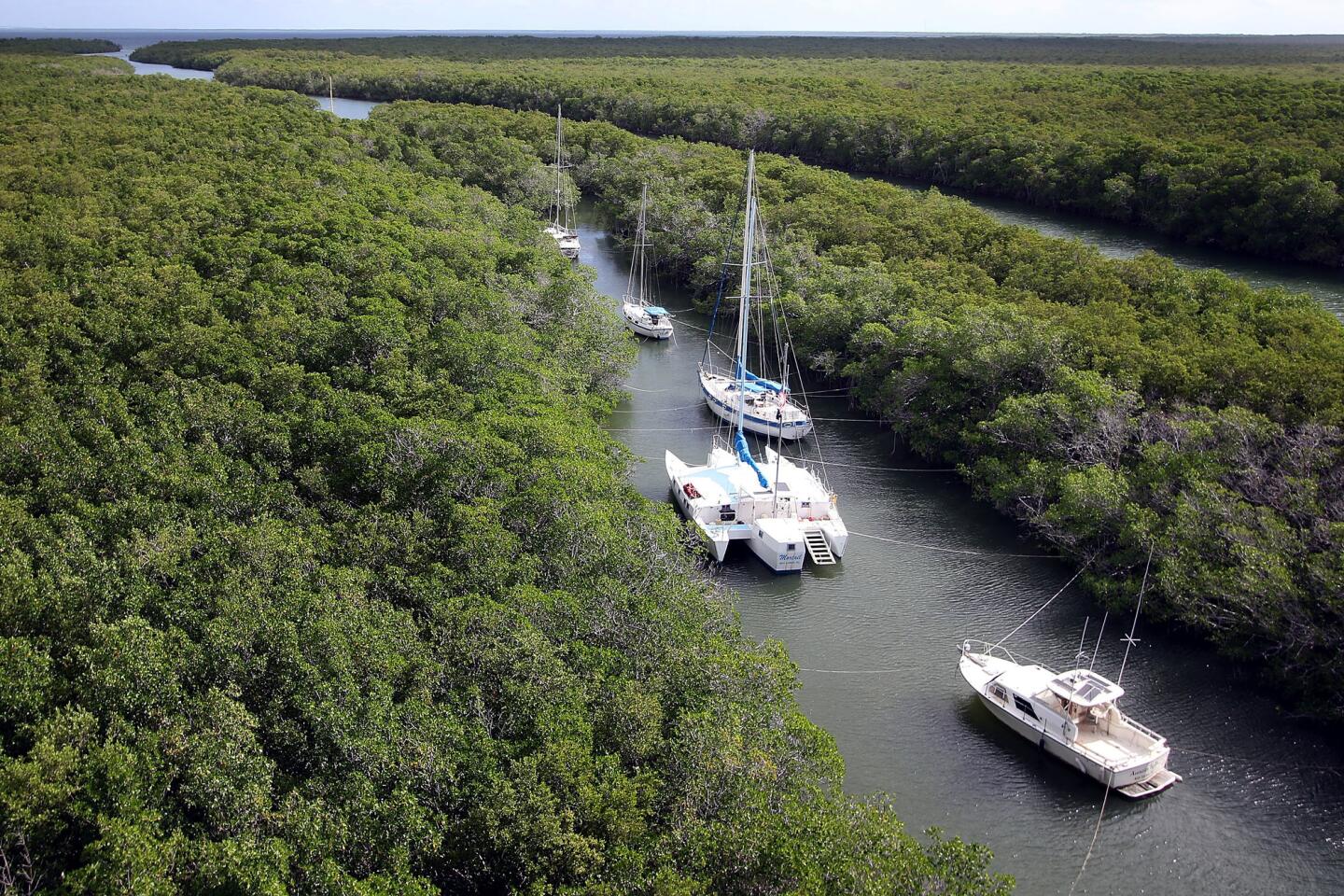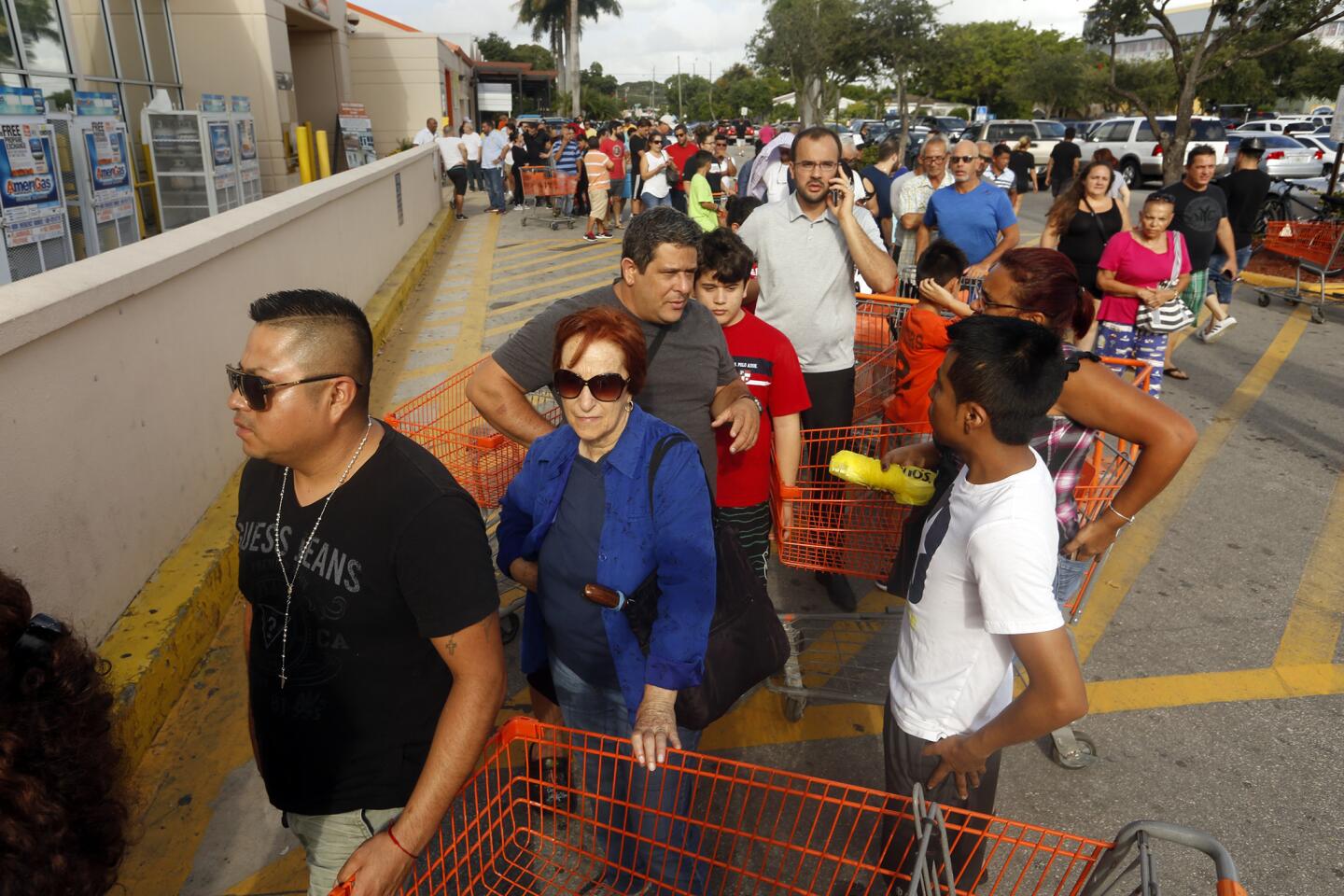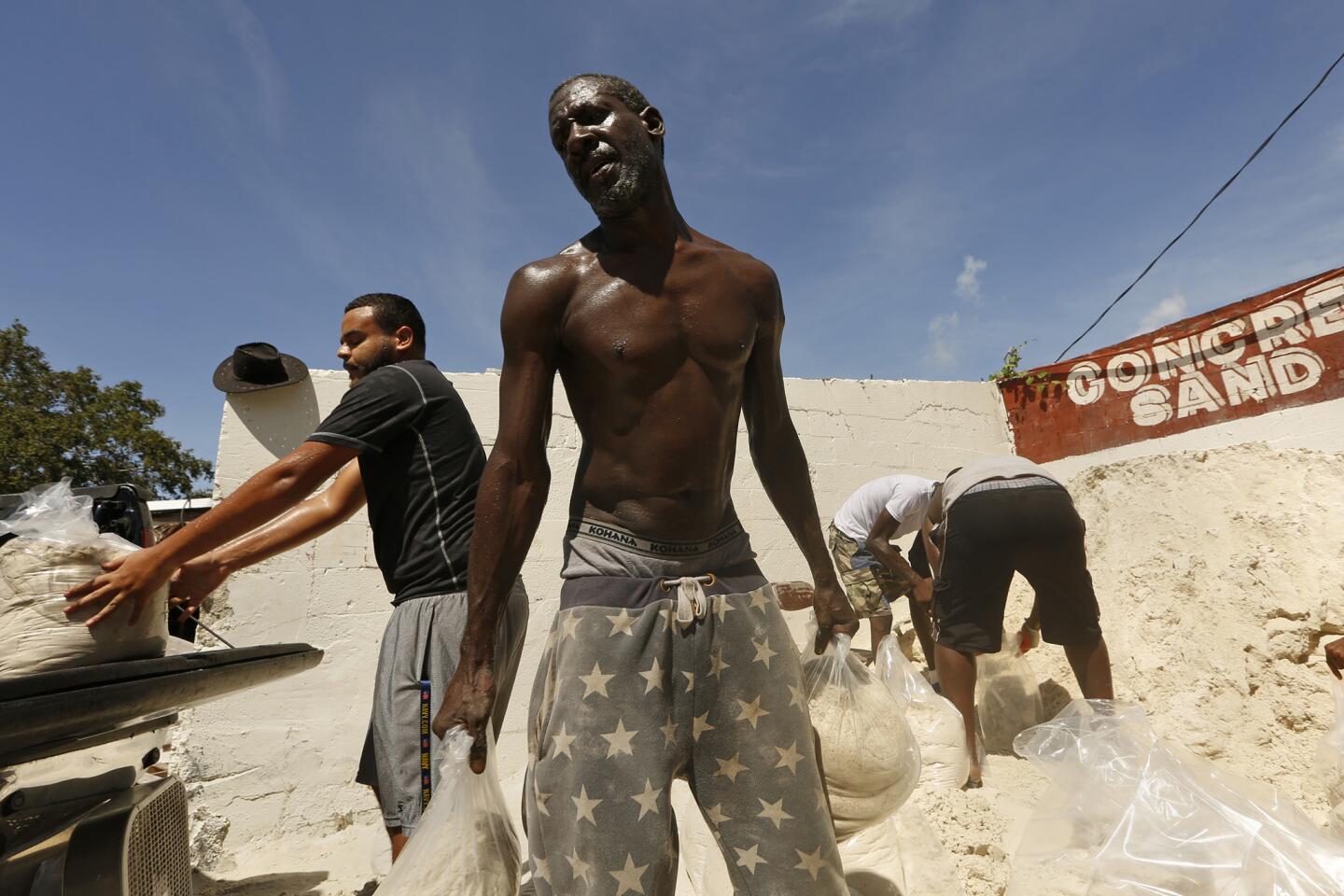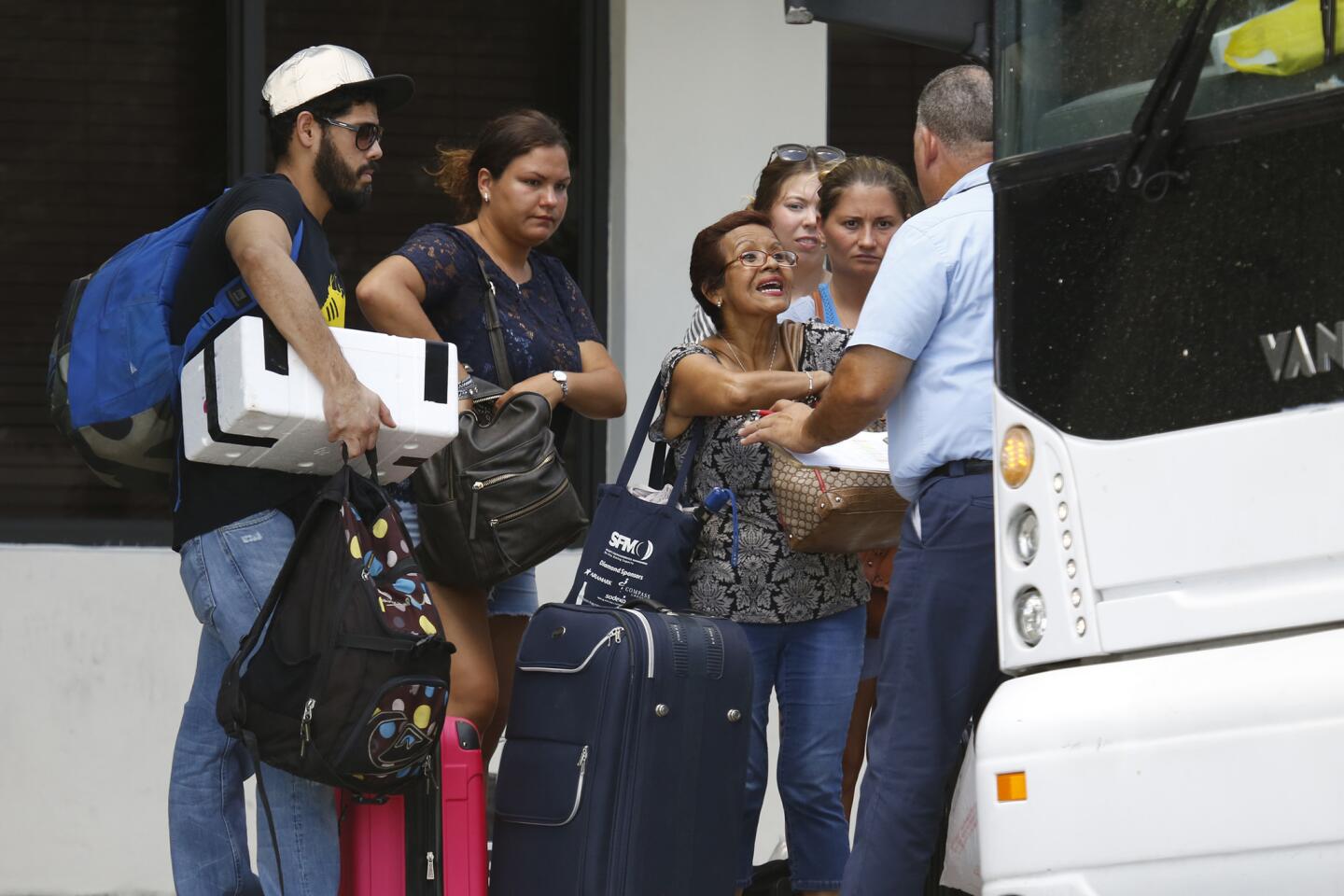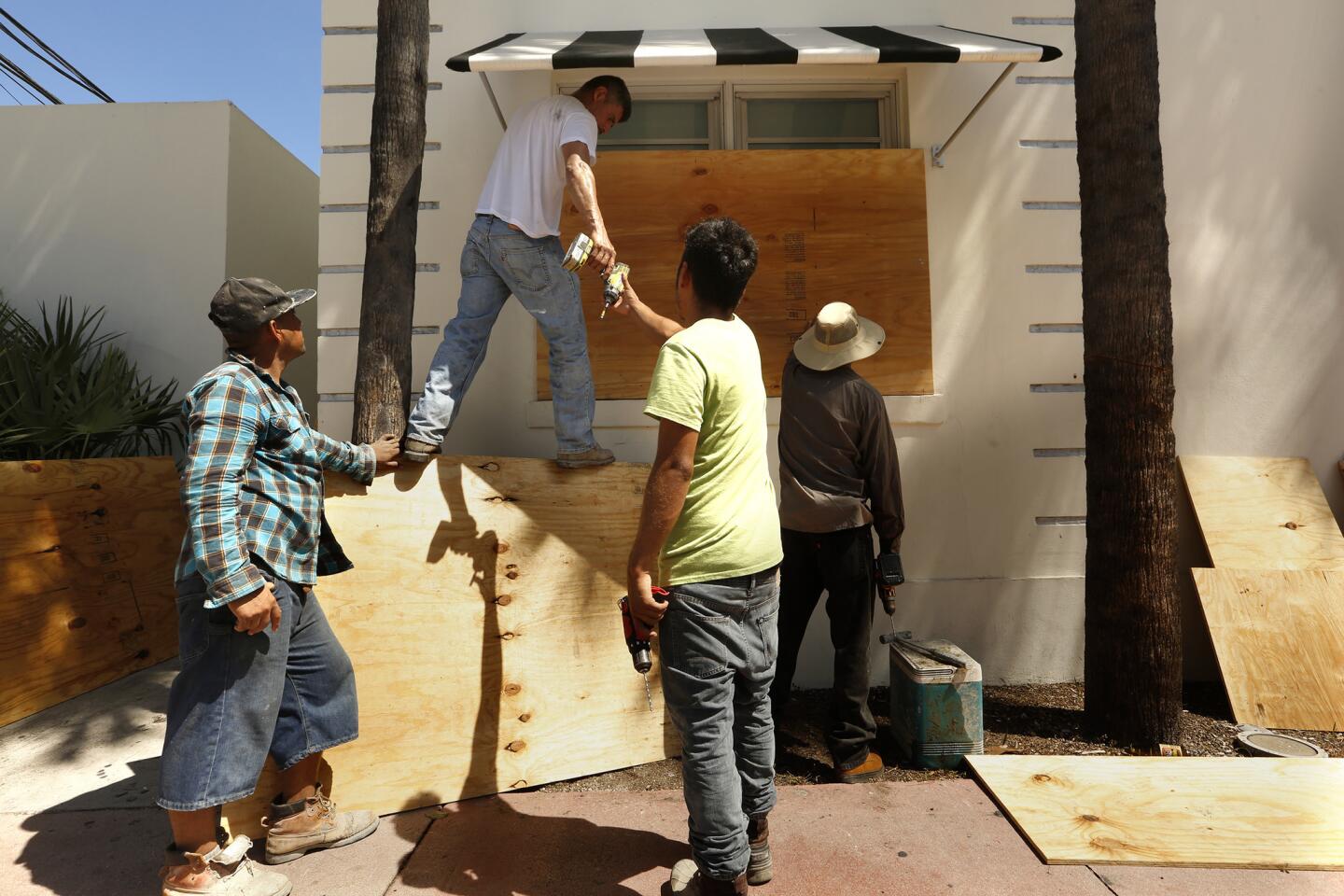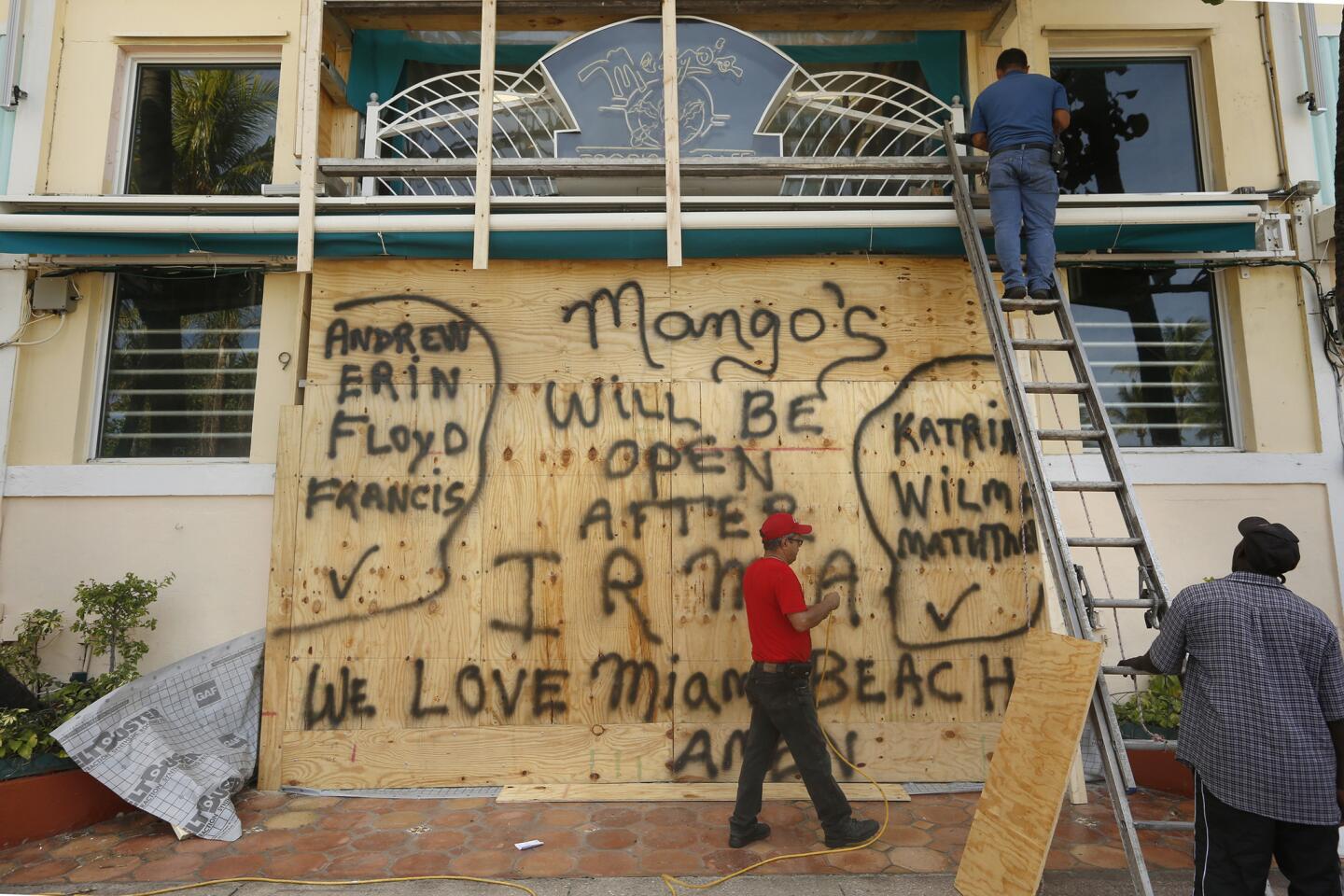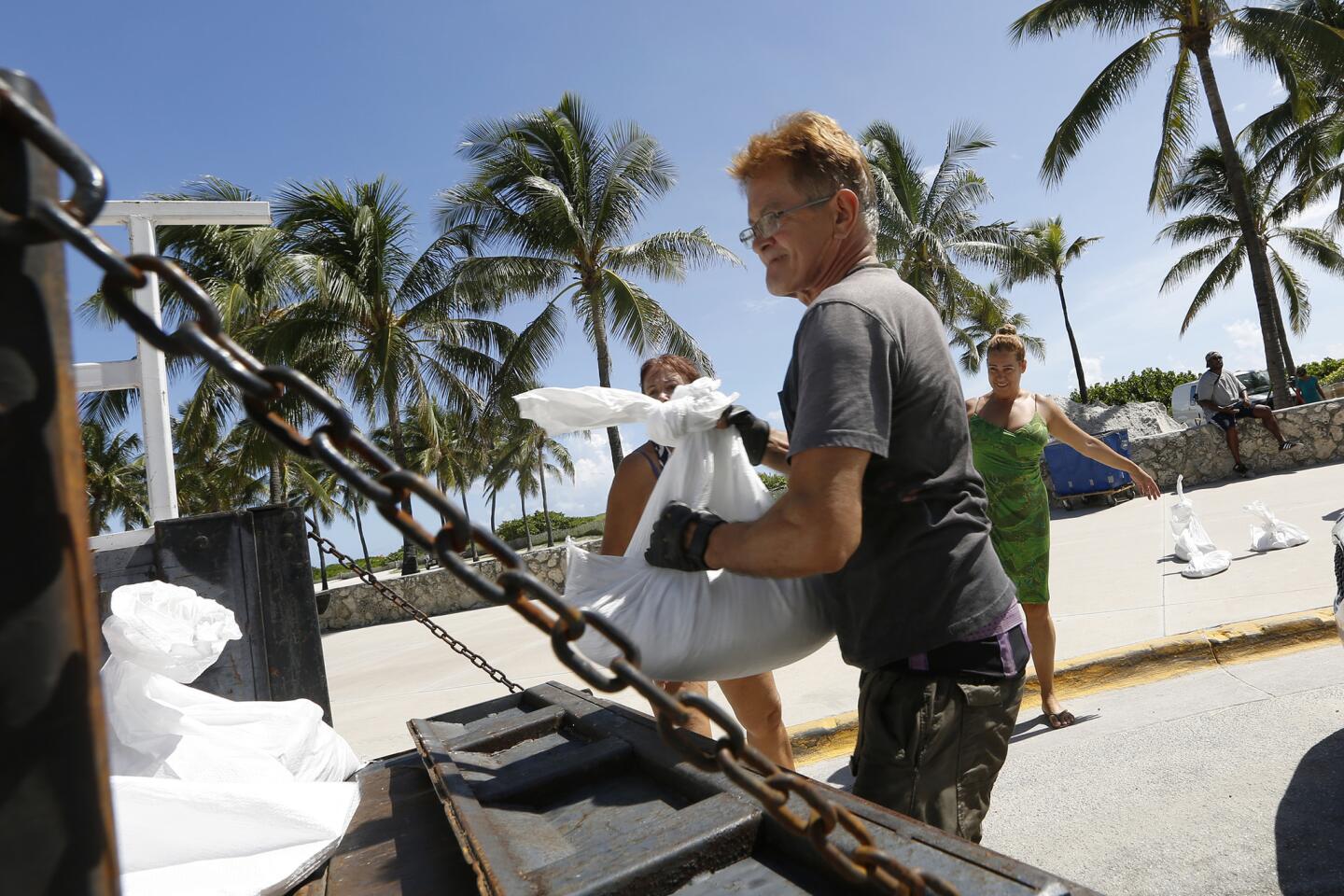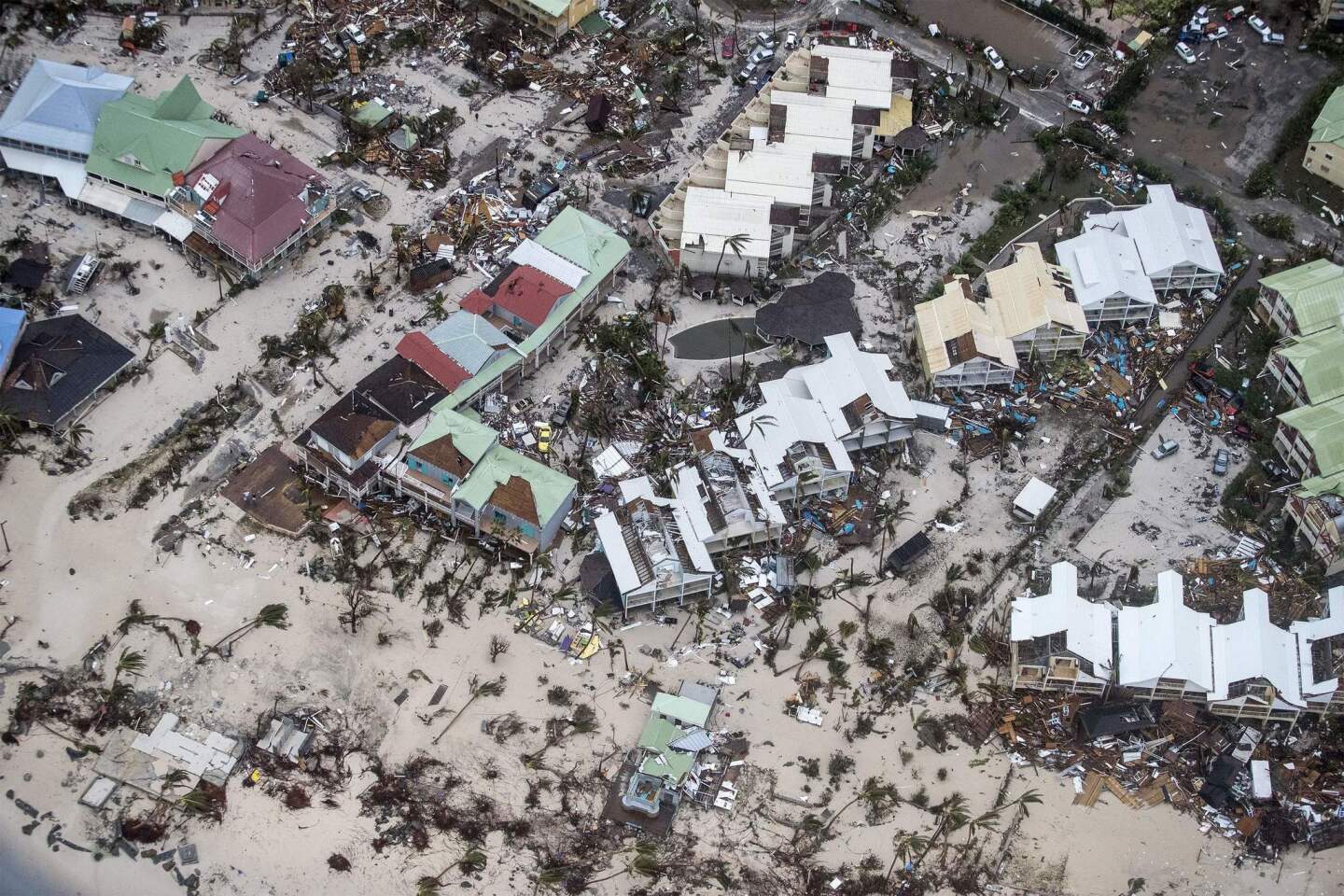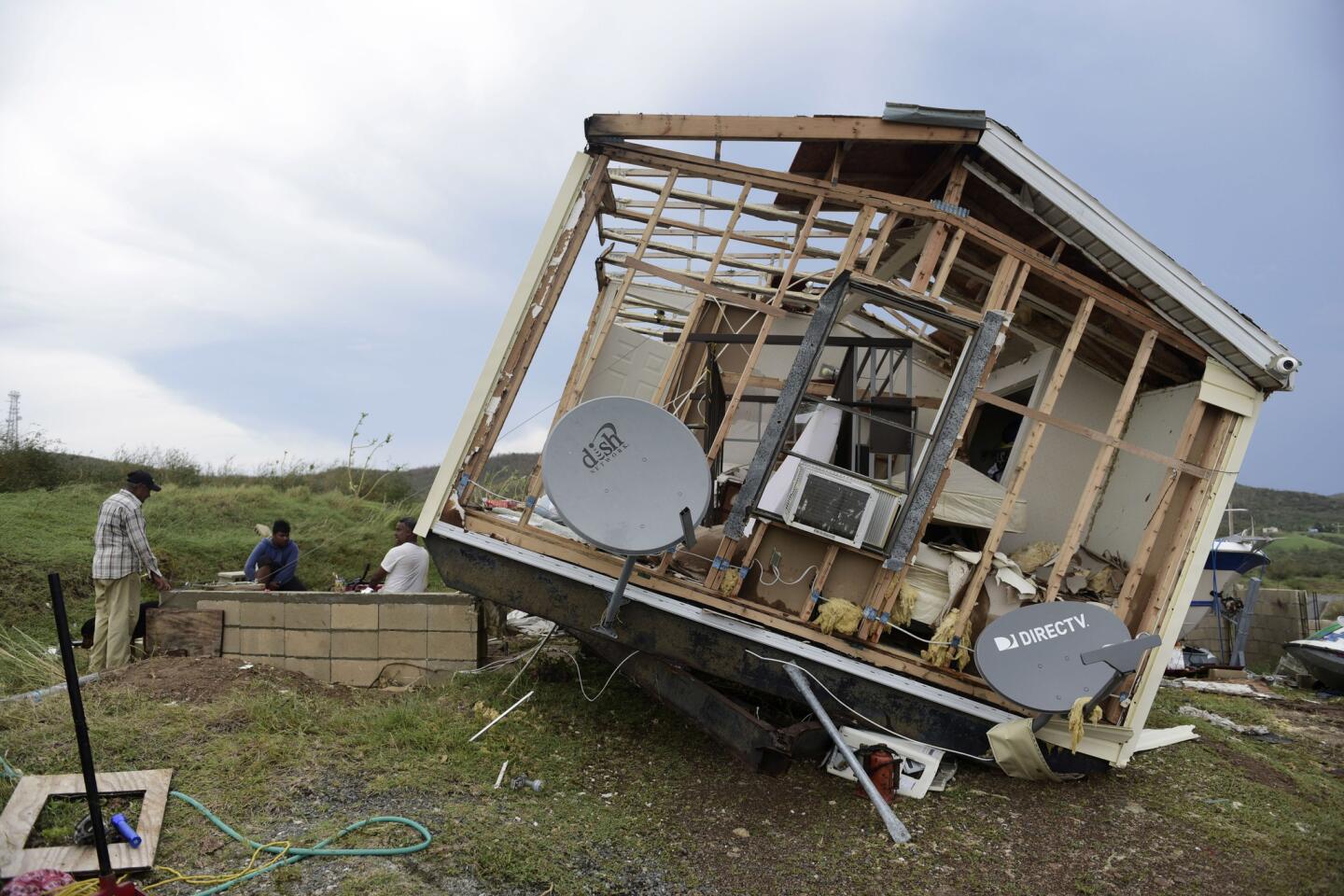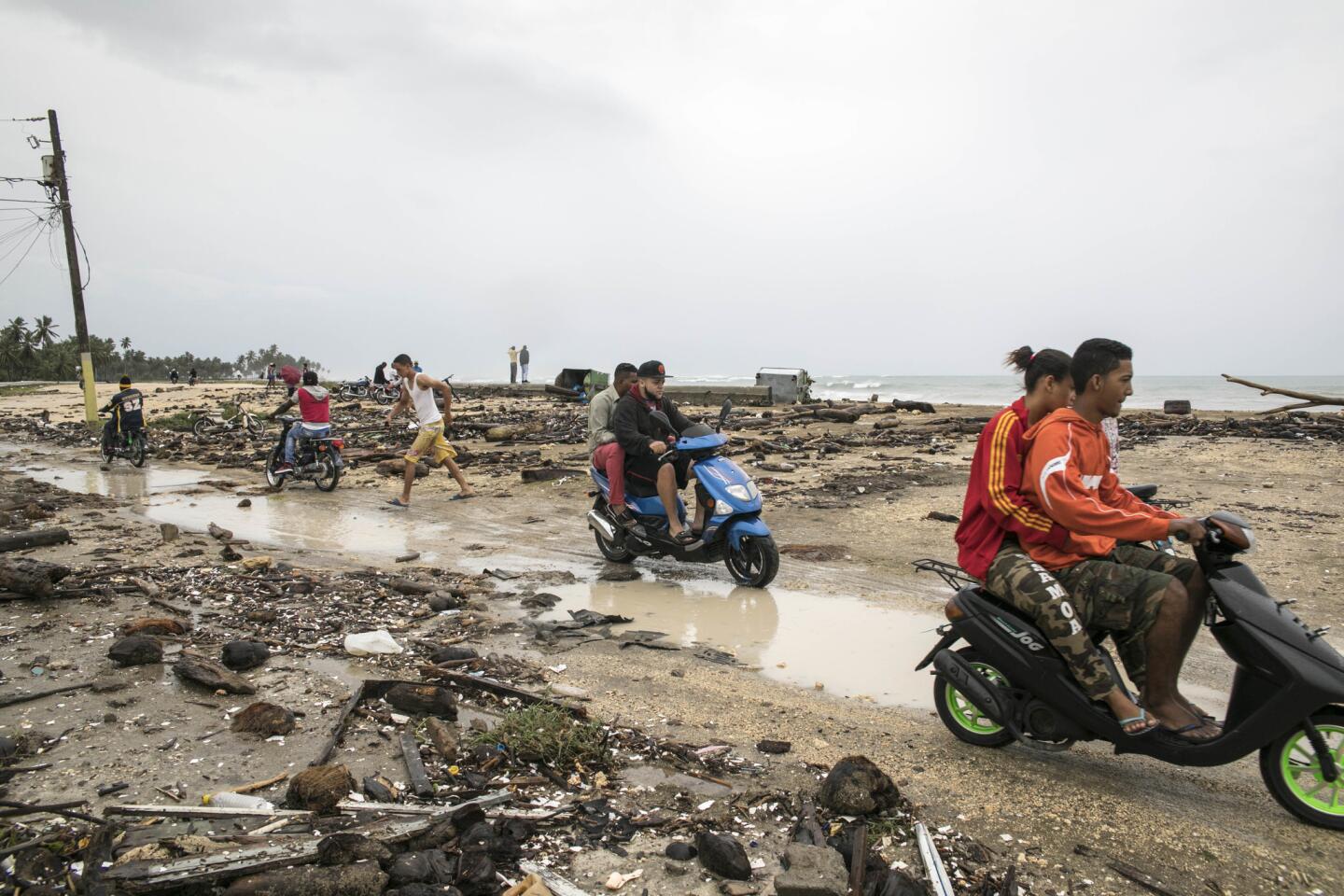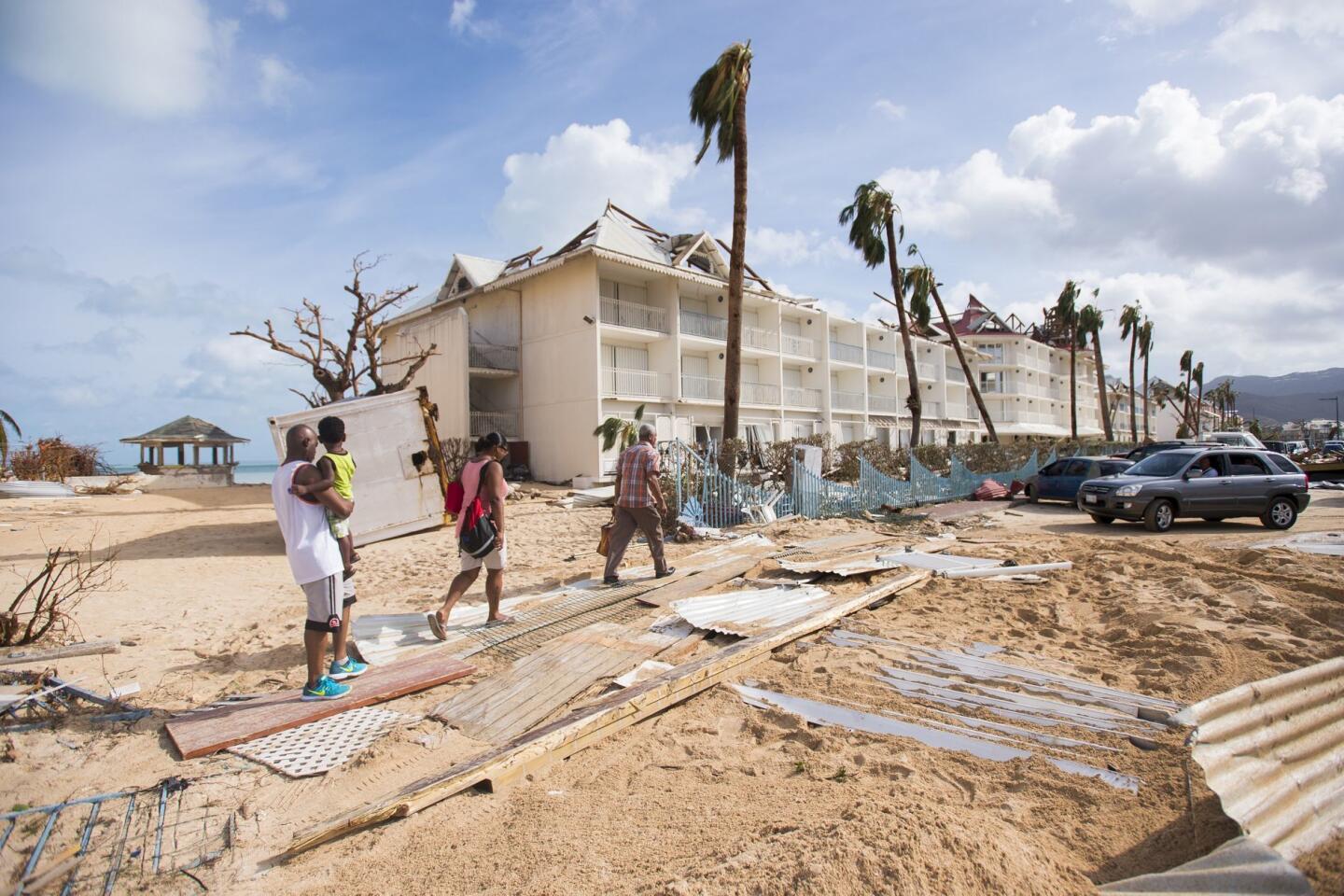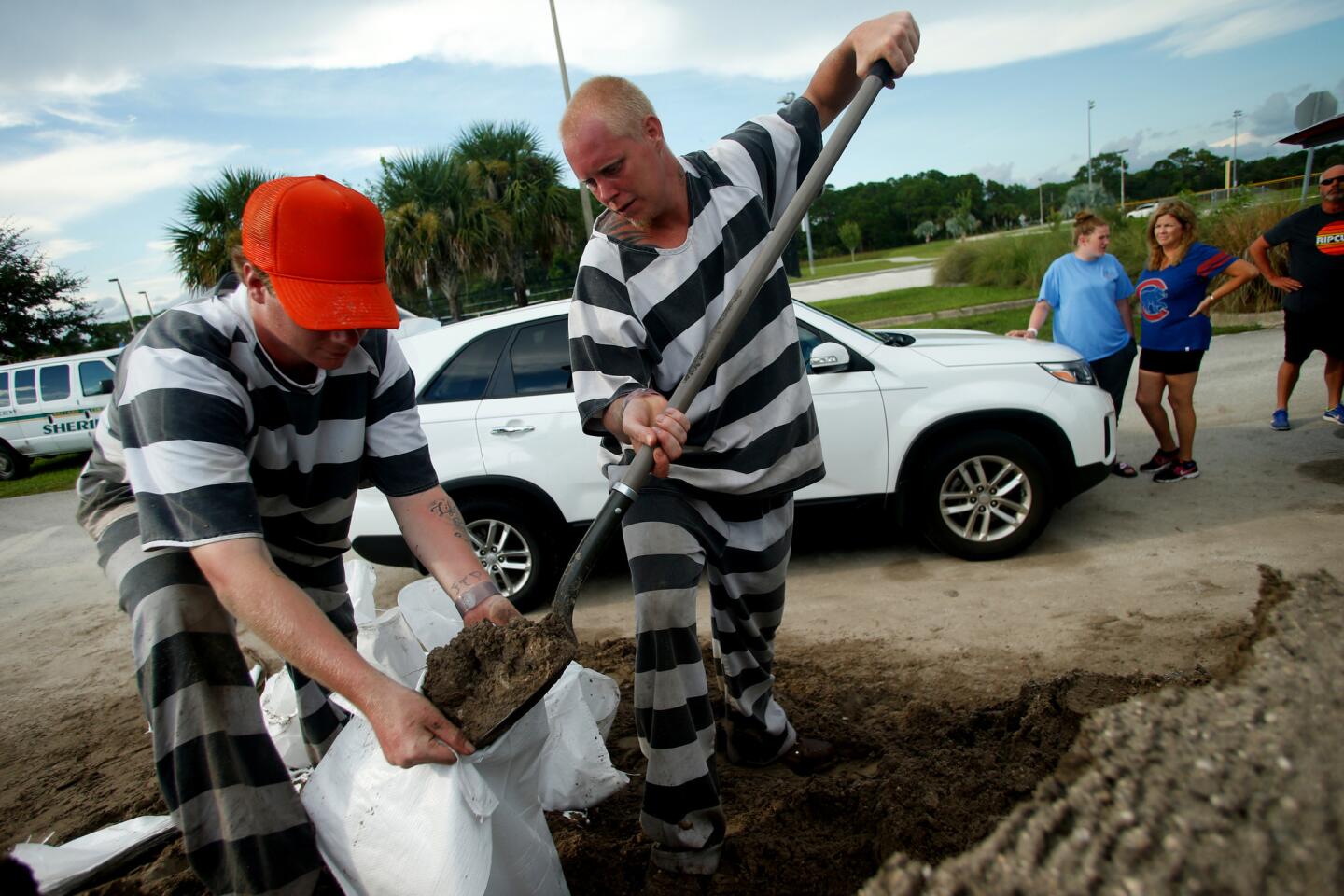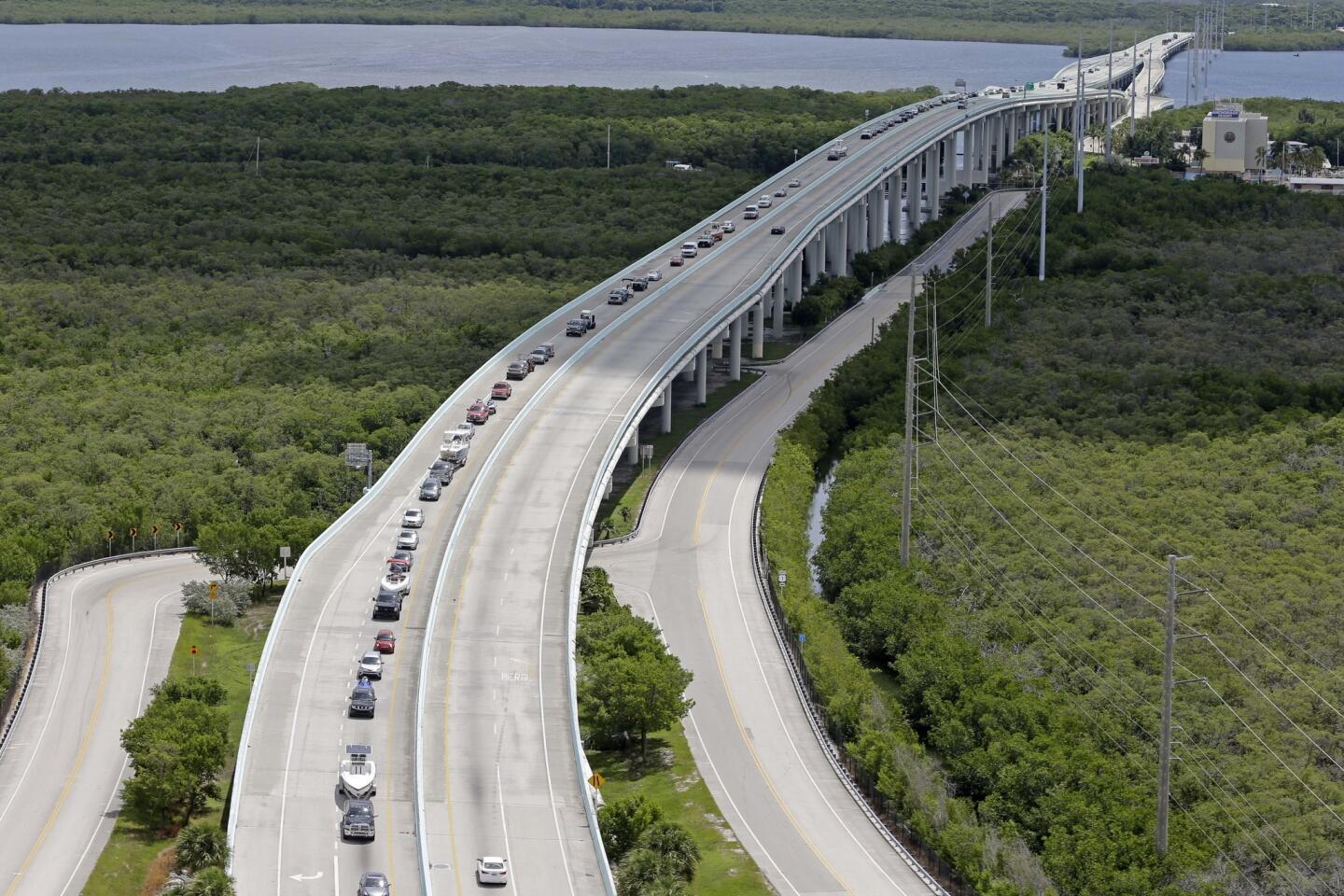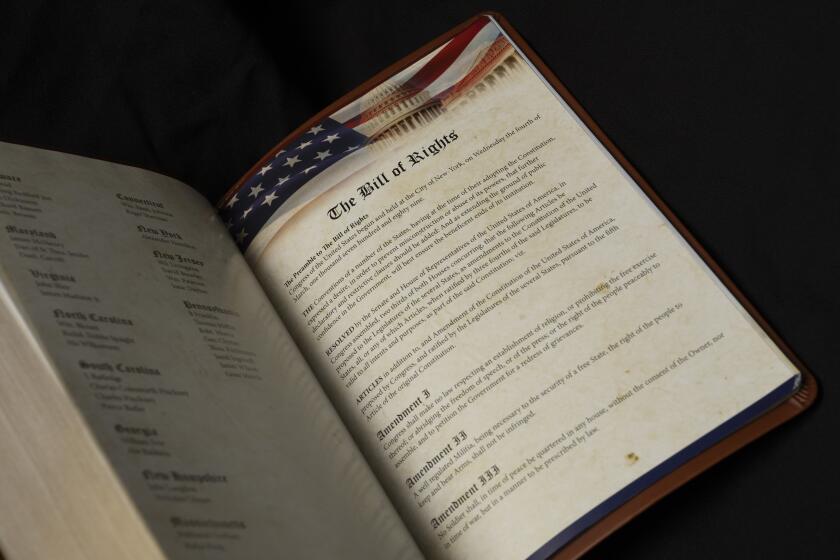Reporting from Naples, Fla. — The Florida Keys began to feel the wrath of Hurricane Irma on Saturday night as the powerful storm headed on a collision course with the western coast of Florida, which braced for a potentially devastating day of deadly winds and surging seas.
Irma was expected to unleash its full fury of 130-mph winds sometime around sunrise over Key West, with the storm picking up speed and tracking possibly toward St. Petersburg for its landfall on the mainland.
Hurricane-force gusts were already blasting the spindly islands of the Keys on Saturday night, while escalating winds, driving rain and isolated tornadoes surged across Florida on the massive storm’s leading edge.
1/79
Trailer homes at the Sea Breeze trailer park in the Florida Keys town of Islamorada were destroyed by Irma.
(Marcus Yam / Los Angeles Times) 2/79
Tom Ross inspects the damage to his three-story condominium building in Islamorada.
(Marcus Yam / Los Angeles Times) 3/79
The remains of a boat in Islamorada.
(Marcus Yam / Los Angeles Times) 4/79
Brooke Gilbert, 15, and her father, Mike Gilbert, look at the ruins of her grandparents’ condominium building in Islamorada.
(Marcus Yam / Los Angeles Times) 5/79
Laura Gilbert retrieves the mailbox from her father’s condominium in Islamorada after it was swept away during the storm.
(Marcus Yam / Los Angeles Times) 6/79
Sand and debris block access to trailer homes in Islamorada.
(Marcus Yam / Los Angeles Times) 7/79
Greg Garner embraces neighbor Linda Nettles in front of his longtime family home that lost part of its roof after Tropical Storm Irma hit Sullivan’s Island, S.C.
(Mic Smith / Associated Press) 8/79
Israel Alvarado, 25, tries to open a gate blocked by fallen tree branches to retrieve a generator in Bonita Springs.
(Carolyn Cole / Los Angeles Times) 9/79
Rescue workers help a couple evacuate their flooded home in Jacksonville.
(John Raoux / Associated Press) 10/79
Charlotte Glaze, left gives Donna Lamb a hug as she floats out some of her belongings in floodwaters in Jacksonville,.
(Dede Smith / Associated Press) 11/79
Ron Colby, 70, leaves his flooded Bonita Springs home after staying during Hurricane Irma. He said he was OK with the wind but that at 3:30 in the morning the water started to rise.
(Carolyn Cole / Los Angeles Times) 12/79
A dresser floats by Gilberto Diaz in his Bonita Springs neighborhood. Originally from Guatemala, Diaz has lived in Florida since 1994.
(Carolyn Cole / Los Angeles Times) 13/79
In Bonita Springs, floodwaters reached waist deep in some areas on Monday, flooding homes and cars.
(Carolyn Cole / Los Angeles Times) 14/79
A block from the ocean in Naples, the water was still a foot deep from storm surge. Homeowner Terry Clontz put up a “no wake” sign because people were driving by too fast, pushing water farther onto his property.
(Carolyn Cole / Los Angeles Times) 15/79
Floodwaters surround a marina in Key Largo on Monday following Hurricane Irma.
(Wilfredo Lee / Associated Press) 16/79
Mobile homes in Key Largo, Fla., lie in ruins on Monday after Hurricane Irma.
(Wilfredo Lee / Associated Press) 17/79
Floodwaters surround Gilbert’s Resort in Key Largo on Monday.
(Wilfredo Lee / Associated Press) 18/79
Kelly McClenthen returns to see the flood damage to her home with her boyfriend, Daniel Harrison, in the aftermath of Hurricane Irma in Bonita Springs, Fla.
(Gerald Herbert / Associated Press) 19/79
Terry Thompson is relieved. He rode out the storm in his home in Riverwood Estates in Naples. Although the Naples area of Florida was hit hard by Hurricane Irma, damage wasn’t nearly as bad as anticipated.
(Carolyn Cole / Los Angeles Times) 20/79
A woman leaves her flooded home the morning after Hurricane Irma swept through the area in Fort Myers, Florida.
(Spencer Platt / Getty Images) 21/79
People tend to a car that flipped over on Cape Coral Parkway during Hurricane Irma, in Cape Coral.
(Gerald Herbert / AP) 22/79
A man clears the drain next to his house in Estero, Fla., during the lull in winds as the eye of the hurricane passes over.
(Carolyn Cole / Los Angeles Times) 23/79
Evacuees use flashlights so others can maneuver around the stairway at Hampton Inn and Suites in Estero, Fla.
(Carolyn Cole / Los Angeles Times) 24/79
Guests gather in the lobby of Hampton Inn and Suites in Estero, Fla., to watch the hurricane gusts.
(Carolyn Cole / Los Angeles Times) 25/79
Darla Talia Ferro, 40, and her two parakeets ride out Hurricane Irma in the lobby of Hampton Inn and Suites in Estero, Fla.
(Carolyn Cole / Los Angeles Times) 26/79
John Krowzow, 74, wades in floodwater to check out his homes in Corkscrew Woodlands, a park with 640 senior mobile home units in Estero, Fla.
(Carolyn Cole / Los Angeles Times) 27/79
Peter Moodley wades through floodwater in downtown Miami.
(Marcus Yam / Los Angeles Times) 28/79
Two men walk through a downed tree as Hurricane Irma’s full force strikes Miami.
(Marcus Yam / Los Angeles Times) 29/79
A woman films the damage from a house whose roof was blown off near downtown Miami.
(Marcus Yam / Los Angeles Times) 30/79
A vehicle drives through debris caused by Hurricane Irma, in Miami.
(Marcus Yam / Los Angeles Times) 31/79
Weather reporters in downtown Miami jump and cling on to illustrate the force of the winds caused by Hurricane Irma.
(Marcus Yam / Los Angeles Times) 32/79
Weather reporters do a stand-up as the force of the winds caused by Hurricane Irma hit Miami.
(Marcus Yam / Los Angeles Times) 33/79
A cargo truck is tipped over by the wind caused by Hurricane Irma in Miami.
(Marcus Yam / Los Angeles Times) 34/79
Storm surge floods the Brickell neighborhood of Miami.
(Marcus Yam / Los Angeles Times) 35/79
Streets are empty in downtown Miami as the wind picks up speed during Hurricane Irma’s approach.
(Marcus Yam / Los Angeles Times) 36/79
Maria Koenig, 63, of Estero, Fla., and her dog, Baeley, sit by the window at their Estero hotel so Maria can keep an eye on the storm on Sunday.
(Carolyn Cole / Los Angeles Times) 37/79
Glen Sinatra, 69, from Naples, says he feels lucky to be at a hotel in Estero instead of a shelter. He’s nervous about the storm and says he’s trying not to worry his children about the conditions.
(Carolyn Cole / Los Angeles Times) 38/79
Jimmy Alfano, of Ft. Myers, holds onto Alec Hoskins who is autistic, while watching the storm gusts through the window of their Estero hotel with Frank Pairs.
(Carolyn Cole / Los Angeles Times) 39/79
A car sits abandoned in storm surge along North Fort Lauderdale Beach Boulevard as Hurricane Irma hits the southern part of the state.
(Chip Somodevilla / Getty Images) 40/79
The metal canopy at a gasoline station is overturned by high winds brought on by Hurricane Irma.
(Wilfredo Lee / Associated Press) 41/79
Youssef Ezzou, left, and Fadel Beznbachir roam outside to check out the conditions in Miami as Hurricane Irma nears the mainland.
(Marcus Yam / Los Angeles Times) 42/79
A construction crane whose arm broke off towers over a building as high wind blows through downtown Miami on Sunday.
(Marcus Yam / Los Angeles Times) 43/79
A man and woman run to safety in Miami as winds from Hurricane Irma bear down on Sunday.
(Marcus Yam / Los Angeles Times) 44/79
Storefronts in Miami are damaged as Hurricane Irma’s winds hit Miami.
(Marcus Yam / Los Angeles Times) 45/79
Dustin Terkoski, Palm Bay Police officer surveys the scene after a possible tornado touched down at Palm Pam Bay Estates.
(Red Huber / Orlando Sentinel) 46/79
A man braces against the wind by the Miami River on Sunday as water levels surge.
(Marcus Yam / Los Angeles Times) 47/79
A man stands by the Miami River as the water level surges on Sunday.
(Marcus Yam / Los Angeles Times) 48/79
The waves on the Miami River begin to surge Sunday as winds pick up speed upon Hurricane Irma’s approach.
(Marcus Yam / Los Angeles Times) 49/79
Brian Williams, of Maryland, fights the winds in downtown Fort Myers.
(Carolyn Cole / Los Angeles Times) 50/79
Trees fall as winds pick up speed early Sunday as Hurricane Irma approaches Miami.
(Marcus Yam / Los Angeles Times) 51/79
A TV reporter braces against the wind as Hurricane Irma approaches Miami.
(Marcus Yam / Los Angeles Times) 52/79
The outer bands of Hurricane Irma start to reach Florida on Saturday, with clouds over the Miami skyline.
(Joe Raedle / Getty Images ) 53/79
People wade through a flooded street in Havana after Hurricane Irma battered central Cuba.
(YAMIL LAGE / AFP/Getty Images) 54/79
Thousands wait Saturday to enter a storm shelter set up at Germain Arena in Estero, Fla., south of Fort Myers.
(Carolyn Cole / Los Angeles Times) 55/79
Jean Turner, 79, waits to get into a shelter with a few of her belongings as rain begins to fall Saturday in Estero, Fla.
(Carolyn Cole / Los Angeles Times) 56/79
Sherri Bourdo, 32, and Anthony Guidry, 40, look out over the water in Naples, Fla, in advance of the arrival of Hurricane Irma.
(Carolyn Cole / Los Angeles Times) 57/79
Lisette Toroella and Tatiana Morera play on the beach as storm clouds approach in Miami Beach.
(Marcus Yam / Los Angeles Times) 58/79
Adam Todd, does a handstand while skateboarding down a virtually empty Ocean Drive in Miami Beach.
(Marcus Yam / Los Angeles Times) 59/79
Abby Jenkins walks against the wind with her luggage and umbrella to get to safety, in Miami Beach.
(Marcus Yam / Los Angeles Times) 60/79
James Sampero surfs in the churning ocean as Hurricane Irma approaches.
(Joe Raedle / Getty Images) 61/79
Cubans wade through the rubble from a collapsed building in Havana on Saturday.
(Yamil Lage / AFP/Getty Images) 62/79
A woman and child use a blanket as protection from wind and rain as they walk in Caibarien, Cuba. Hurricane Irma battered Cuba on Saturday with deafening winds and unremitting rain, pushing seawater inland and flooding homes before turning toward Florida.
(Desmond Boylan / Associated Press) 63/79
Annette Davis plays with her son Darius, 3, while staying at a shelter in Miami on Saturday after evacuating from their home in Florida City ahead of Hurricane Irma.
(David Goldman / Associated Press) 64/79
Residents walk through rain brought on by Hurricane Irma in Caibarien, Cuba. The powerful storm battered Cuba on Saturday and continued its march toward Florida.
(Desmond Boylan / Associated Press) 65/79
Palmetto Ridge High School is a shelter for people with special needs near Naples, Fla. Many seniors plan to ride out the storm there.
(Carolyn Cole / Los Angeles Times) 66/79
Francesca DeLuca, age 20, will be waiting for 10 hours for her flight back to Milan, Italy. She had been visiting a friend in Miami by herself, but the area where she was staying is under mandatory evacuation. At Miami International Airport, the last flights will be this afternoon with the airport closing tonight at 6pm. Most travelers are taking flights to anywhere they can find.
(Carolyn Cole / Los Angeles Times) 67/79
Boats that can’t be evacuated are tied off in canals to protect them from Hurricane Irma on in Key Largo, Florida. The entire Florida Keys are under a mandatory evacuation notice as Hurricane Irma approaches the low-lying chain of islands south of Miami.
(Marc Serota / Getty Images) 68/79
Hundreds wait in line on Friday at Home Depot in Miami to get supplies line sheets of plywood, and anything else they can find, to board up their homes. Police were on the scene to keep things orderly.
(Carolyn Cole / Los Angeles Times) 69/79
In the Little Haiti neighborhood of Miami, Fritz Drinks, whose family is from Haiti, helps load sandbags at Little Haiti Hardware and Lumber. Many people in the area are refusing to evacuate in advance of Hurricane Irma.
(Carolyn Cole / Los Angeles Times) 70/79
In downtowm Miaimi, people wait to get on a bus headed to Orlando under a mandatory evacution plan. Preparations are underway for Hurricane Irma as the storm makes its way toward Florida.
(Carolyn Cole / Los Angeles Times) 71/79
Stores are boarded up in Miami Beach in advance of Hurricane Irma.
(Carolyn Cole / Los Angeles Times) 72/79
Preparations for Hurricane Irma are underway in Miami Beach as the storm makes its way toward Florida.
(Carolyn Cole / Los Angeles Times) 73/79
Genaro Dacosta, 65, of Miami Beach loads sandbags in advance of Hurricane Irma. He says he can’t evacuate the area because he has a monkey.
(Carolyn Cole / Los Angeles Times) 74/79
An aerial photograph taken and released by the Dutch Department of Defense on Wednesday shows damage from Hurricane Irma in Philipsburg, St. Maarten.
(Gerben van Es / AFP/Getty Images) 75/79
Juan Negron, third from left, prepares to start up a power generator in front of what’s left of his damaged property in Culebra, Puerto Rico, after the passage of Hurricane Irma.
(Carlos Giusti / Associated Press) 76/79
Residents come out to survey the damage caused by Hurricane Irma in Nagua, Dominican Republic.
(Tatiana Fernandez / Associated Press) 77/79
People on Thursday look over damage from Hurricane Irma on a sand-covered street of Marigot, near the Bay of Nettle, on the island of St. Maarten.
(Lionel Chamoiseau / AFP/Getty Images) 78/79
Inmate trustees from the Brevard County Jail fill sandbags for Meritt Island, Fla., residents in advance of Hurricane Irma.
(Brian Blanco / Getty Images) 79/79
Motorists leave Key Largo, Fla., ahead of Hurricane Irma.
(Alan Diaz / Associated Press) Miami, which on Friday had launched a massive evacuation in anticipation of a direct hit, was breathing easier as the storm tracked west — yet Irma’s 350-mile-wide girth meant the city was still in for 90-mph winds and a storm surge of 3 to 6 feet.
Nearly 7 million people were advised to evacuate. Many of those on the west coast were unable to flee because, with the storm’s change of direction, the warning came too late.
And the storm continued to perplex: News early in the day that it would charge toward Naples and Fort Myers changed by Saturday night to suggest it would track northward offshore in the Gulf of Mexico for a time and make landfall farther north, near St. Petersburg and Tampa.
The storm also gained power as it inched northward, and by early Sunday regained its designation as a Category 4 hurricane.
State transportation officials allowed cars to use the shoulders traveling the bumper-to-bumper highway out of Tampa; in Naples and Fort Myers, where many buildings weren’t constructed to withstand the expected storm surge, people fled to crowded shelters by the thousands.
“The storm is here,” Gov. Rick Scott said. “Hurricane Irma is now impacting our state. … This is a deadly storm and the state has never seen anything like it.”
The massive movement of water onto ordinarily dry land that is expected could have life-threatening consequences, state and federal officials warned.
“There is a serious threat of significant storm-surge flooding along the entire west coast of Florida and this has increased to 15 feet above ground level,” Scott said. “Fifteen feet is devastating and will cover your house.”
The National Weather Service warned that the storm was so large that hurricane-force winds could be expected throughout south and central Florida — no matter which side of the state one was on.
“This is as real as it gets,” the service said in a statement.
Landfall on Florida’s west coast would bring winds of about 120 mph, the National Weather Service said late Saturday night.
People along Florida’s western coast spent the day scrambling for shelter.
Near Naples, people waited in an hours-long line to get inside the Germain Arena in Estero, which had become a 7,500-bed shelter. Many of them had avoided such shelters in previous storms and would not have been there Saturday if their neighborhoods hadn’t abruptly been evacuated.
The evacuation zone grew so large by Saturday morning that even those who had made arrangements to stay in hotels were sent to shelters because the hotels were being evacuated.
Staying at home was out of the question for Elizabeth and John Simler, whose house is built on land about 5 feet above sea level on Sanibel Island, with its stilts boosting the home an additional 10 feet.
They had prepared, they thought.
“We had a very fine hotel reservation,” said Elizabeth, 57. “We did not expect to be in this line [at the shelter].”
The hotel alerted them only hours before that guests were being turned away.
Lou Fusco bailed on his hotel before it could bail on him.
Hurricane Irma has strengthened as it heads toward Florida’s Gulf Coast. (Sept. 10, 2017)
“They said if there is a forced evacuation, you will have to leave,” he said. “So I said, ‘If that happens, then where the hell am I going to go?’”
Even in Miami, residents were worried about what possible 90-mph winds would do to the city.
In downtown Miami Beach, Jose Toledo, a 27-year-old sound design engineer, said he was moving out of his ninth-floor apartment along the waterfront because it didn’t have shutters.
“We’re going to stay in my office because it’s safer there,” he said while emerging for a few last-minute supplies. “The construction down here isn’t good. I’m worried about things flying off the buildings ... and you’ve got all these construction sites with loose stuff on the ground. It could be dangerous for sure.”
About 75,000 people were registered at shelters by Saturday night.
As the first heavy winds blew in, there were reports of electrical transformers exploding and downed trees.
As of Saturday night, almost 200,000 homes had lost power, and officials have predicted that total outages could reach 4 million before Irma heads into Georgia on Monday.
Hurricane warnings were issued along the east and west coasts of Florida, with hurricane watches pending in Georgia and lower South Carolina. Tropical storm watches were declared along the Florida Panhandle and mid-coastal South Carolina.
Seven counties in South Florida were under a tornado watch; a full-out warning was issued in the Miami-Dade County area after two tornadoes were spotted there. More counties were expected to be added as the initial bands from the storm reached those areas.
Several cities, including Miami, were imposing nighttime curfews as the storm approached. Most central Florida counties planned to do the same Sunday night.
Every major airport in Florida was closed with the exception of Tallahassee and Pensacola. Tallahassee planned to shut down Monday.
Saturday’s urgency was foreshadowed by the damage done to Cuba on Friday and Saturday and other Caribbean islands earlier in the week. The death toll was at least 25.
Cuba’s meteorological agency reported that Irma came ashore Friday night in central Camaguey province, home to the country’s third-largest city, with winds so strong they destroyed measurement instruments.
Hurricane-strength winds were later recorded in the northern half of Camaguey. Irma was the first Category 5 hurricane to hit the province in 85 years, according to a state media radio station. Damage was reported across the province, the station said: roofs torn off, trees downed and power disconnected.
In the province of Holguin, some families took shelter in caves to ride out the storm.
Full coverage of Hurricane Irma »
“No one wants to leave the house, only silence is interrupted by gusts of wind and rain,” Yoani Sanchez, who runs a Havana-based digital news service, 14ymedio, tweeted about the situation in Camaguey.
Sanchez posted photos of people crowding the streets of Havana to pray. She reported that supplies were running low.
Irma was eventually downgraded to Category 3 before it headed for Florida on Saturday.
Video: Times coverage of Hurricane Irma
The storm is one of three hurricanes cycling through the warm September waters. Hurricane Katia struck the eastern coast of Mexico early Saturday as a Category 1 storm. Luis Felipe Puente, head of Mexico’s national emergency services agency, said two people were killed by the hurricane, which roared onshore in Veracruz state, pelting the region with intense rains and winds.
Katia quickly lost strength after hitting land and was downgraded to a minimal tropical storm with winds of about 35 mph. The storm could bring 3 to 6 inches of additional rain to a region with a history of flooding and deadly mudslides.
Hurricane Jose continued to churn as a Category 4 storm in the northeast Caribbean. It is expected to affect the islands of St. Martin and St. Barthelemy, but warnings have been lifted for the U.S. and British Virgin Islands. The storm will move north into the Atlantic and not be a factor.
This satellite imagery animation shows the monster storm as it approaches Florida.
Times staff writer Halper reported from Naples. Times staff writer Cherwa reported from Orlando. Special correspondent Len Neuhaus contributed reporting from Miami.Times staff writer Molly Hennessy-Fiske contributed reporting from Houston. Times staff writer Kate Linthicum contributed reporting from Mexico City.
ALSO
Thinking of staying put in the path of Hurricane Irma? Think again
Once there was an island known as Barbuda. After Hurricane Irma, much of it is gone
How Hurricane Irma became the second-strongest Atlantic hurricane on record
UPDATES:
11:15 p.m.: The story was updated with news that the storm is now a Category 4 hurricane once again.
10:50 p.m.: The story was updated with a revised forecast in the hurricane’s track.
8:40 p.m.: The story was updated with additional details throughout, including a revised forecast of the hurricane’s wind speeds.
5 p.m.: The story was updated with the latest forecast.
3:35 p.m. The story was updated with information on the new trajectory of the storm, revised forecasts and interviews with Florida residents.
10:15 a.m.: The story was updated with an interview with a resident of downtown Miami Beach.
9:50 a.m.: The story was updated with details of the damage in Cuba.
9:45 a.m.: This story was updated with new storm surge forecasts.
8:20 a.m.: This article was updated with revised wind speed forecasts.
This article was originally published at 7:45 a.m.



